

Dhammapada Dhammapada Verse 280 Padhanakammikatissatthera Vatthu-The Lazy Miss The Path
ALL ABOUT AWAKEN ONES WITH AWARENESS USA
Virginia
• Ekoji Buddhist Temple, Fairfax Station
This sutta is widely considered as a the main reference for meditation practice.
| III. Cittānupassanā
Kathaṃ ca pana, bhikkhave, bhikkhu citte cittānupassī viharati? |
And furthermore, bhikkhus, how does a bhikkhu dwell observing citta in citta? |
|
Idha, bhikkhave, bhikkhu sa·rāgaṃ vā cittaṃ ‘sa·rāgaṃ cittaṃ’ ti pajānāti, vīta·rāgaṃ vā cittaṃ ‘vīta·rāgaṃ cittaṃ’ ti pajānāti, sa·dosaṃ vā cittaṃ ‘sa·dosaṃ cittaṃ’ ti pajānāti, vīta·dosaṃ vā cittaṃ ‘vīta·dosaṃ cittaṃ’ ti pajānāti, sa·mohaṃ vā cittaṃ ‘sa·mohaṃ cittaṃ’ ti pajānāti, vīta·mohaṃ vā cittaṃ ‘vīta·mohaṃ cittaṃ’ ti pajānāti, saṅkhittaṃ vā cittaṃ ‘saṅkhittaṃ cittaṃ’ ti pajānāti, vikkhittaṃ vā cittaṃ ‘vikkhittaṃ cittaṃ’ ti pajānāti, mahaggataṃ vā cittaṃ ‘mahaggataṃ cittaṃ’ ti pajānāti, a·mahaggataṃ vā cittaṃ ‘a·mahaggataṃ cittaṃ’ ti pajānāti, sa·uttaraṃ vā cittaṃ ‘sa·uttaraṃ cittaṃ’ ti pajānāti, an·uttaraṃ vā cittaṃ ‘an·uttaraṃ cittaṃ’ ti pajānāti, samāhitaṃ vā cittaṃ ‘samāhitaṃ cittaṃ’ ti pajānāti, a·samāhitaṃ vā cittaṃ ‘a·samāhitaṃ cittaṃ’ ti pajānāti, vimuttaṃ vā cittaṃ ‘vimuttaṃ cittaṃ’ ti pajānāti, a·vimuttaṃ vā cittaṃ ‘a·vimuttaṃ cittaṃ’ ti pajānāti. |
Here, bhikkhus, a bhikkhu understands citta with rāga as “citta with rāga“, or he understands citta without rāga as “citta without rāga“, or he understands citta with dosa as “citta with dosa“, or he understands citta without dosa as “citta without dosa“, or he understands citta with moha as “citta with moha“, or he understands citta without moha as “citta without moha“, or he understands a collected citta as “a collected citta“, or he understands a scattered citta as “a scattered citta“, or he understands an expanded citta as “an expanded citta“, or he understands an unexpanded citta as “an unexpanded citta“, or he understands a surpassable citta as “a surpassable citta“, or he understands an unsurpassable citta as “an unsurpassable citta“, or he understands a concentrated citta as “a concentrated citta“, or he understands an unconcentrated citta as “an unconcentrated citta“, or he understands a liberated citta as “a liberated citta“, or he understands an unliberated citta as “an unliberated citta“. |
|
Iti ajjhattaṃ vā citte cittānupassī viharati, bahiddhā vā citte cittānupassī viharati, ajjhatta-bahiddhā vā citte cittānupassī viharati; samudaya-dhamm·ānupassī vā cittasmiṃ viharati, vaya-dhamm·ānupassī vā cittasmiṃ viharati, samudaya-vaya-dhamm·ānupassī vā cittasmiṃ viharati; ‘atthi cittaṃ’ ti vā pan·assa sati paccupaṭṭhitā hoti, yāvadeva ñāṇa·mattāya paṭissati·mattāya, a·nissito ca viharati, na ca kiñci loke upādiyati. Evam·pi kho, bhikkhave, bhikkhu citte cittānupassī viharati. |
Thus he dwells observing citta in citta internally, or he dwells observing citta in citta externally, or he dwells observing citta in citta internally and externally; he dwells observing the samudaya of phenomena in citta, or he dwells observing the passing away of phenomena in citta, or he dwells observing the samudaya and passing away of phenomena in citta; or else, [realizing:] “this is citta!” sati is present in him, just to the extent of mere ñāṇa and mere paṭissati, he dwells detached, and does not cling to anything in the world. Thus, bhikkhus, a bhikkhu dwells observing citta in citta. |
III. Citta மனம் அதனுடைய அகநிலையை கூர்ந்து கவனித்தல்
மற்றும் இப்போது எவ்வாறு பிக்குக்களுக்களே, ஒரு பிக்கு, Citta மனம் அதனுடைய அகநிலையை in Citta மனம் அதனுடைய அகநிலையில் கூர்ந்து கவனித்து வாசம் செய்கிரார்?
மற்றும் இப்போது எவ்வாறு பிக்குக்களுக்களே, ஒரு பிக்கு, Citta மனம் அதனுடைய அகநிலை rāga ஆர்வ வேட்கையை ” Citta மனம் அதனுடைய அகநிலை rāga ஆர்வ வேட்கையாக” என புரிந்துகொள்கிரார்,அல்லது Citta மனம் அதனுடைய அகநிலை rāga ஆர்வ வேட்கையற்றதை, “Citta மனம் அதனுடைய அகநிலை rāga ஆர்வ வேட்கையற்றது” என புரிந்துகொள்கிரார்,அல்லது
Citta மனம் அதனுடைய அகநிலை “dosa வெறுப்பு ஆர்வ வேட்கையை Citta மனம் அதனுடைய அகநிலை dosa வெறுப்பு ஆர்வ வேட்கையாக” என புரிந்துகொள்கிரார்,”Citta மனம் அதனுடைய அகநிலை dosa வெறுப்பு ஆர்வ வேட்கையற்றதை, Citta மனம் அதனுடைய அகநிலை dosa வெறுப்பு ஆர்வ வேட்கையற்றது” என புரிந்துகொள்கிரார், அல்லது Citta மனம் அதனுடைய அகநிலை moha மருட்சி ஆர்வ வேட்கையை “Citta மனம் அதனுடைய அகநிலை moha மருட்சி ஆர்வ வேட்கை” என புரிந்துகொள்கிரார்,”Citta மனம் அதனுடைய அகநிலை moha மருட்சி ஆர்வ வேட்கையற்றதை, Citta மனம் அதனுடைய அகநிலை moha மருட்சி ஆர்வ வேட்கையற்றது” என புரிந்துகொள்கிரார், அல்லது ஒரு சேர்த்த Citta மனம் அதனுடைய அகநிலை “ஒரு சேர்த்த Citta மனம் அதனுடைய அகநிலை” என புரிந்துகொள்கிரார், ஒரு சிதறலான
Citta மனம் அதனுடைய அகநிலை “ஒரு சிதறலான Citta மனம் அதனுடைய அகநிலை” என புரிந்துகொள்கிரார்,அல்லது ஒரு விரிவாக்கம் செய்த Citta மனம் அதனுடைய அகநிலை “ஒரு விரிவாக்கம் செய்த Citta மனம் அதனுடைய அகநிலை” என புரிந்துகொள்கிரார், ஒரு விரிவாக்கம் செய்யாத Citta மனம் அதனுடைய அகநிலை “ஒரு விரிவாக்கம் செய்யாத Citta மனம் அதனுடைய அகநிலை” என புரிந்துகொள்கிரார்,அல்லது ஒரு மிக மேற்பட்ட Citta மனம் அதனுடைய அகநிலை “ஒரு மிக மேற்பட்ட Citta மனம் அதனுடைய அகநிலை” என புரிந்துகொள்கிரார், ஒரு மிக மேற்படாத Citta மனம் அதனுடைய அகநிலை “ஒரு மிக மேற்படாத Citta மனம் அதனுடைய அகநிலை” என புரிந்துகொள்கிரார்,அல்லது ஒரு திண்மையான Citta மனம் அதனுடைய அகநிலை “ஒரு திண்மையான Citta மனம் அதனுடைய அகநிலை” என புரிந்துகொள்கிரார், ஒரு திண்மையற்ற Citta மனம் அதனுடைய அகநிலை “ஒரு திண்மையற்ற Citta மனம் அதனுடைய அகநிலை” என புரிந்துகொள்கிரார்,அல்லது ஒரு விடுதலை செய்த Citta மனம் அதனுடைய அகநிலை “ஒரு விடுதலை செய்த Citta மனம் அதனுடைய அகநிலை” என புரிந்துகொள்கிரார், ஒரு விடுதலை செய்யாத Citta மனம் அதனுடைய அகநிலை “ஒரு விடுதலை செய்யாத Citta மனம் அதனுடைய அகநிலை” என புரிந்துகொள்கிரார்.
இவ்வாறு அவர் Citta மனம் அதனுடைய அகநிலையை in Citta மனம் அதனுடைய அகநிலையில் கூர்ந்து கவனித்து வாசம் செய்கிரார், அல்லது அதனுடைய அகநிலையை in Citta மனம் அதனுடைய அகநிலையில் வெளியே கூர்ந்த கவனித்து வாசம் செய்கிரார்;samudaya of phenomena புலன்களால் உணரத்தக்க தோற்றம் அதனுடைய அகநிலையில் கூர்ந்து கவனித்து வாசம் செய்கிரார், புலன்களால் உணரத்தக்க கழிதல் அதனுடைய அகநிலையில் கூர்ந்து கவனித்து வாசம் செய்கிரார், samudaya and passing away of phenomena புலன்களால் உணரத்தக்க தோற்றம் மற்றும் கழிதல் அதனுடைய அகநிலையில் கூர்ந்து கவனித்து வாசம் செய்கிரார், இல்லாவிடில் “இது citta அகநிலை” என உணர்ந்து, sati விழிப்பு நிலை அவருக்குள் வந்திருக்கிறது, சும்மா வெறும் ñāṇa ஓர்அளவு ஞானம் மற்றும் ஓர்அளவு paṭissati என எண்ணி பற்றறு வாசம் செய்கிரார். மற்றும் உலகத்தில் சிறிதளவாவது பற்றிக்கொள்ளாது,அவ்வாறாக பிக்குக்களுக்களே, ஒரு பிக்கு, Citta மனம் அதனுடைய அகநிலையை in Citta மனம் அதனுடைய அகநிலையில் கூர்ந்து கவனித்து வாசம் செய்கிரார்.
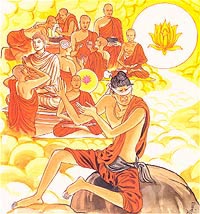
Though time to strive, not striving,
while young and strong yet indeed,
weak-minded and irresolute:
one finds not wisdom’s way.
Explanation: If an individual does not make
an effort even at a time when exertion is due, if a person is lethargic
even when he is young and strong; if a person suppresses the wholesome
thoughts that arise in his mind, if he is lazy, he will not find the path
to wisdom.
Dhammapada Verse 280
Padhanakammikatissatthera Vatthu
Utthana kalamhi anutthahano
yuva bali Alasiyam upeto
samsanna sankappamano kusito
pannaya maggam alaso na vindati.
Verse 280: The idler who does not strive when he should be striving, who
though young and strong is given to idleness, whose thoughts are weak and
wandering, will not attain Magga Insight which can only be perceived by wisdom.
The Story of Thera Tissa the Idle One
While residing at the Jetavana monastery, the Buddha uttered Verse (280) of
this book, with reference to Tissa, a lazy bhikkhu.
Once, five hundred young men were admitted into the Order by the Buddha in
Savatthi. After receiving a subject of meditation from the Buddha, all the new
bhikkhus except one went to the forest to practise meditation. They practised
zealously and vigilantly so that in due course all of them attained arahatship.
When they returned to the monastery to pay homage to him, the Buddha was very
pleased and satisfied with their achievement. Bhikkhu Tissa who stayed behind
did not try hard and therefore achieved nothing.
When Tissa found that the relationship between the Buddha and those bhikkhus
was very cordial and intimate, he felt rather neglected, and regretted that he
had wasted all that time. So he resolved to practise meditation throughout the
night. As he was walking in meditation on that night, he slipped and broke a
thigh bone. Other bhikkhus hearing his cry went to help him. On hearing about
the above incident the Buddha said, “Bhikkhus, one who does not strive
when he should be striving but idle away his time will not attain mental
absorption (jhana) and Magga Insight.”
Then the Buddha spoke in verse as follows:
| Verse 280: The idler who does not strive when he should be striving, who though young and strong is given to idleness, whose thoughts are weak and wandering, will not attain Magga Insight which can only be perceived by wisdom. |
Virginia
• Ekoji Buddhist Temple, Fairfax Station
http://en.wikipedia.org/wiki/Fairfax_Station
| Fairfax Station | |
|---|---|
| — Unincorporated community — | |
|
Location within the state of Virginia |
|
| Coordinates: 38°48′9″N 77°19′31″WCoordinates: 38°48′9″N 77°19′31″W | |
| Country | United States |
| State | Virginia |
| County | Fairfax |
| Time zone | Eastern (EST) (UTC-5) |
| • Summer (DST) | EDT (UTC-4) |
| ZIP codes | 22039 |
| FIPS code | |
| GNIS feature ID | |
Fairfax Station is a census-designated place (CDP) in Fairfax County, Virginia, ZIP code 22039.[1] The population as of the 2010 Census was 12,030.[2] As a suburb of Washington, DC, it is a bedroom community for many who work in the federal government.
http://filipinofestival.com/blog/2012/07/11/obon-festival-2012-ekoji-buddhist-temple-fairfax-station-va-saturday-july-14-2012/
DC Metro Filipino-American Group
Ekoji Buddhist Temple is celebrating its
31st Obon Festival on Saturday, July 14 at 5:30 p.m. with a full-evening
of activities including traditional Japanese folk dancing, a memorial
candle ceremony, children’s games and a taiko performance by Nen Daiko.
Obon, or Bon, is a time of remembrance for our parents, grandparents and
those who have come before us; it is a time to express our gratitude
for all they have done for us, and for the interconnectedness of our
lives.
The first video shows a group dance. I
participated last year at the one in Ekoji. Sure I looked terrible but
it was a lot of fun with friends. The second video shows the taiko drum
performance they do every year. The last video
[30]
| O |
NCE upon a time the king of a large and rich country
gathered together his army to take a far-away little country.
![[Illustration]](http://www.mainlesson.com/books/babbitt/morejataka/zpage031.gif)
The king and his soldiers marched all morning long
and then went into camp in the forest.
When they fed the horses they gave them some peas to eat.
One of the Monkeys living in the forest saw the peas
and jumped down to get some of them.
He filled his mouth and hands with them,
and up into the tree he went again, and sat down to eat the peas.
As he sat there eating the peas,
one pea fell from his hand to the ground.
At once the greedy Monkey dropped all the peas
he had in his hands, and ran down to hunt for the lost pea.
But he could not find that one pea. He climbed up into his tree again,
and sat still looking very glum.
“To get more, I threw away what I had,” he said to himself.
The king had watched the Monkey,
and he said to
him- [32] self: “I will not be like this foolish Monkey,
who lost much to gain a little. I will go back to my own country
and enjoy what I now have.”
So he and his men marched back home.



For the adventurer, there are 16.7 miles of
Indoor Golf Open Year Round on 68th St.
Fun for the whole family.
Don’t forget our 2 family arcades at our 68th …
Things to do in West Virginia with kids |
Fun places for kids in Kentucky
Things to do in VA with kids |
Places to visit in North Carolina with kids |
Fun things to do in Maryland |
What to do with kids in Tennessee |
Amusement parks near Norfolk |
Water parks near Norfolk VA |
Things to do in Norfolk VA |
Things to do in Williamsburg with kids |
What to do in Richmond |
Fun for kids in Arlington
Dhammapada Verses 277, 278 and 279
Aniccalakkhana Vatthu - Verse 277. Conditioned Things Are Transient
Dukkhalakkhana Vatthu - Verse 278. All Component Things Are Sorrow
Anattalakkhana Vatthu -Verse 279. Everything Is Soul-less
ALL ABOUT AWAKEN ONES WITH AWARENESS USA Utah
• Kanzeon Zen Center, Salt Lake City
This sutta is widely considered as a the main reference for meditation practice.
| (6) Puna ca·paraṃ, bhikkhave, bhikkhu seyyathāpi passeyya sarīraṃ sivathikāya chaḍḍitaṃ aṭṭhikāni apagata·sambandhāni disā vidisā vikkhittāni, aññena hatth·aṭṭhikaṃ aññena pād·aṭṭhikaṃ aññena gopphak·aṭṭhikaṃ aññena jaṅgh·aṭṭhikaṃ aññena ūru·ṭṭhikaṃ aññena kaṭi·ṭṭhikaṃ aññena phāsuk·aṭṭhikaṃ aññena piṭṭh·iṭṭhikaṃ aññena khandh·aṭṭhikaṃ aññena gīv·aṭṭhikaṃ aññena hanuk·aṭṭhikaṃ aññena dant·aṭṭhikaṃ aññena sīsakaṭāhaṃ, so imam·eva kāyaṃ upasaṃharati: ‘ayaṃ pi kho kāyo evaṃ·dhammo evaṃ·bhāvī evaṃ·an·atīto’ ti. |
(6)
Furthermore, bhikkhus, a bhikkhu, just as if he was seeing a dead body, |
|
Iti ajjhattaṃ vā kāye kāyānupassī viharati, bahiddhā vā kāye kāyānupassī viharati, ajjhatta-bahiddhā vā kāye kāyānupassī viharati; samudaya-dhamm·ānupassī vā kāyasmiṃ viharati, vaya-dhamm·ānupassī vā kāyasmiṃ viharati, samudaya-vaya-dhamm·ānupassī vā kāyasmiṃ viharati; ‘atthi kāyo’ ti vā pan·assa sati paccupaṭṭhitā hoti, yāvadeva ñāṇa·mattāya paṭissati·mattāya, a·nissito ca viharati, na ca kiñci loke upādiyati. Evam·pi kho, bhikkhave, bhikkhu kāye kāyānupassī viharati. |
Thus he dwells observing kāya in kāya internally, or he dwells observing kāya in kāya externally, or he dwells observing kāya in kāya internally and externally; he dwells observing the samudaya of phenomena in kāya, or he dwells observing the passing away of phenomena in kāya, or he dwells observing the samudaya and passing away of phenomena in kāya; or else, [realizing:] “this is kāya!” sati is present in him, just to the extent of mere ñāṇa and mere paṭissati, he dwells detached, and does not cling to anything in the world. Thus, bhikkhus, a bhikkhu dwells observing kāya in kāya. |
தமிழ்
மேலும், பிக்குக்களுக்களே, ஒரு பிக்கு, ஒருவேளை அவர் தொலைவான இடத்தில் ஒரு பிரேதம் இடுகாடு நிலத்தளத்தில் எறியப்பட்டு இருப்பதைப் பார்த்துக் கொண்டிருந்தால், கழற்றபட்ட எலும்புகள் அங்குமிங்குமா சிதறலான, இங்கே ஒரு கை எலும்பு, அங்கே ஒரு கால் எலும்பு, இங்கே ஒரு கணுக்கால் எலும்பு, அங்கே ஒரு முழந்தாள் எலும்பு, இங்கே ஒரு தொடை எலும்பு, அங்கே ஒரு இடுப்பு எலும்பு, இங்கே ஒரு தொடை எலும்பு, அங்கே ஒரு விலா எலும்பு, இங்கே ஒரு தொடை எலும்பு, அங்கே ஒரு முதுகு எலும்பு, இங்கே ஒரு தண்டெலும்பு, அங்கே ஒரு கழுத்து எலும்பு, இங்கே ஒரு தாடை எலும்பு, அங்கே ஒரு பல் எலும்பு, அல்லது அங்கே ஒரு மண்டை ஓடு என அவர் இந்த மெய்ம்மூலமான kāya உடல்/காய ஆழ்ந்து ஆராய: “இந்த kāya உடல்/காய கூட அவ்வகைப்பட்ட ஒரு இயற்கை ஆற்றல் உடையதாக இருக்கிறது, அதுவும் இப்படி ஆகத்தொடங்கு போக இருக்கிறது, மற்றும் அத்தகைய ஒரு கட்டுப்பாட்டு வரம்புகளற்ற நிலைமை இருந்து வேறல்ல.
இவ்வாறு அவர் kāya in kāya உடல்/காயத்தை காயதுக்குள் கண்காணி வாசம் செய்கிரார், அல்லது காயத்தை காயதுக்கு வெளியே கண்காணி வாசம் செய்கிரார், அல்லது காயத்தை காயதுக்கு உள்ளே மற்றும் வெளியே கண்காணி வாசம் செய்கிரார்;புலன்களால் உணரத்தக்க எழுச்சி கண்காணி வாசம் செய்கிரார், மற்றும் புலன்களால் உணரத்தக்கதை கடந்துசெல்லுவதை கண்காணித்து வாசம் செய்கிரார்; இல்லாவிடில் எச்சரிக்கையாயிருக்கிற உணர் உடனிருக்கிறதை,சும்மா வெறும் ஓர்அளவு ஞானம் மற்றும் ஓர்அளவு paṭissati என எண்ணி பற்றறு வாசம் செய்கிரார்.
| (7) Puna ca·paraṃ, bhikkhave, bhikkhu seyyathāpi passeyya sarīraṃ sivathikāya chaḍḍitaṃ aṭṭhikāni setāni saṅkha·vaṇṇa·paṭibhāgāni, so imam·eva kāyaṃ upasaṃharati: ‘ayaṃ pi kho kāyo evaṃ·dhammo evaṃ·bhāvī evaṃ·an·atīto’ ti. |
(7)
Furthermore, bhikkhus, a bhikkhu, just as if he was seeing a dead body, |
|
Iti ajjhattaṃ vā kāye kāyānupassī viharati, bahiddhā vā kāye kāyānupassī viharati, ajjhatta-bahiddhā vā kāye kāyānupassī viharati; samudaya-dhamm·ānupassī vā kāyasmiṃ viharati, vaya-dhamm·ānupassī vā kāyasmiṃ viharati, samudaya-vaya-dhamm·ānupassī vā kāyasmiṃ viharati; ‘atthi kāyo’ ti vā pan·assa sati paccupaṭṭhitā hoti, yāvadeva ñāṇa·mattāya paṭissati·mattāya, a·nissito ca viharati, na ca kiñci loke upādiyati. Evam·pi kho, bhikkhave, bhikkhu kāye kāyānupassī viharati. |
Thus he dwells observing kāya in kāya internally, or he dwells observing kāya in kāya externally, or he dwells observing kāya in kāya internally and externally; he dwells observing the samudaya of phenomena in kāya, or he dwells observing the passing away of phenomena in kāya, or he dwells observing the samudaya and passing away of phenomena in kāya; or else, [realizing:] “this is kāya!” sati is present in him, just to the extent of mere ñāṇa and mere paṭissati, he dwells detached, and does not cling to anything in the world. Thus, bhikkhus, a bhikkhu dwells observing kāya in kāya. |
இவ்வாறு அவர் kāya in kāya உடல்/காயத்தை காயதுக்குள் கண்காணி வாசம் செய்கிரார், அல்லது காயத்தை காயதுக்கு வெளியே கண்காணி வாசம் செய்கிரார், அல்லது காயத்தை காயதுக்கு உள்ளே மற்றும் வெளியே கண்காணி வாசம் செய்கிரார்;புலன்களால் உணரத்தக்க எழுச்சி கண்காணி வாசம் செய்கிரார், மற்றும் புலன்களால் உணரத்தக்கதை கடந்துசெல்லுவதை கண்காணித்து வாசம் செய்கிரார்; இல்லாவிடில் எச்சரிக்கையாயிருக்கிற உணர் உடனிருக்கிறதை,சும்மா வெறும் ஓர்அளவு ஞானம் மற்றும் ஓர்அளவு paṭissati என எண்ணி பற்றறு வாசம் செய்கிரார்.
| (8) Puna ca·paraṃ, bhikkhave, bhikkhu seyyathāpi passeyya sarīraṃ sivathikāya chaḍḍitaṃ aṭṭhikāni puñja·kitāni terovassikāni, so imam·eva kāyaṃ upasaṃharati: ‘ayaṃ pi kho kāyo evaṃ·dhammo evaṃ·bhāvī evaṃ·an·atīto’ ti. |
(8)
Furthermore, bhikkhus, a bhikkhu, just as if he was seeing a dead body, |
|
Iti ajjhattaṃ vā kāye kāyānupassī viharati, bahiddhā vā kāye kāyānupassī viharati, ajjhatta-bahiddhā vā kāye kāyānupassī viharati; samudaya-dhamm·ānupassī vā kāyasmiṃ viharati, vaya-dhamm·ānupassī vā kāyasmiṃ viharati, samudaya-vaya-dhamm·ānupassī vā kāyasmiṃ viharati; ‘atthi kāyo’ ti vā pan·assa sati paccupaṭṭhitā hoti, yāvadeva ñāṇa·mattāya paṭissati·mattāya, a·nissito ca viharati, na ca kiñci loke upādiyati. Evam·pi kho, bhikkhave, bhikkhu kāye kāyānupassī viharati. |
Thus he dwells observing kāya in kāya internally, or he dwells observing kāya in kāya externally, or he dwells observing kāya in kāya internally and externally; he dwells observing the samudaya of phenomena in kāya, or he dwells observing the passing away of phenomena in kāya, or he dwells observing the samudaya and passing away of phenomena in kāya; or else, [realizing:] “this is kāya!” sati is present in him, just to the extent of mere ñāṇa and mere paṭissati, he dwells detached, and does not cling to anything in the world. Thus, bhikkhus, a bhikkhu dwells observing kāya in kāya. |
இவ்வாறு அவர் kāya in kāya உடல்/காயத்தை காயதுக்குள் கண்காணி வாசம் செய்கிரார், அல்லது காயத்தை காயதுக்கு வெளியே கண்காணி வாசம் செய்கிரார், அல்லது காயத்தை காயதுக்கு உள்ளே மற்றும் வெளியே கண்காணி வாசம் செய்கிரார்;புலன்களால் உணரத்தக்க எழுச்சி கண்காணி வாசம் செய்கிரார், மற்றும் புலன்களால் உணரத்தக்கதை கடந்துசெல்லுவதை கண்காணித்து வாசம் செய்கிரார்; இல்லாவிடில் எச்சரிக்கையாயிருக்கிற உணர் உடனிருக்கிறதை,சும்மா வெறும் ஓர்அளவு ஞானம் மற்றும் ஓர்அளவு paṭissati என எண்ணி பற்றறு வாசம் செய்கிரார்.
| (9) Puna ca·paraṃ, bhikkhave, bhikkhu seyyathāpi passeyya sarīraṃ sivathikāya chaḍḍitaṃ aṭṭhikāni pūtīni cuṇṇaka·jātāni, so imam·eva kāyaṃ upasaṃharati: ‘ayaṃ pi kho kāyo evaṃ·dhammo evaṃ·bhāvī evaṃ·an·atīto’ ti. |
(9)
Furthermore, bhikkhus, a bhikkhu, just as if he was seeing a dead body, |
|
Iti ajjhattaṃ vā kāye kāyānupassī viharati, bahiddhā vā kāye kāyānupassī viharati, ajjhatta-bahiddhā vā kāye kāyānupassī viharati; samudaya-dhamm·ānupassī vā kāyasmiṃ viharati, vaya-dhamm·ānupassī vā kāyasmiṃ viharati, samudaya-vaya-dhamm·ānupassī vā kāyasmiṃ viharati; ‘atthi kāyo’ ti vā pan·assa sati paccupaṭṭhitā hoti, yāvadeva ñāṇa·mattāya paṭissati·mattāya, a·nissito ca viharati, na ca kiñci loke upādiyati. Evam·pi kho, bhikkhave, bhikkhu kāye kāyānupassī viharati. |
Thus he dwells observing kāya in kāya internally, or he dwells observing kāya in kāya externally, or he dwells observing kāya in kāya internally and externally; he dwells observing the samudaya of phenomena in kāya, or he dwells observing the passing away of phenomena in kāya, or he dwells observing the samudaya and passing away of phenomena in kāya; or else, [realizing:] “this is kāya!” sati is present in him, just to the extent of mere ñāṇa and mere paṭissati, he dwells detached, and does not cling to anything in the world. Thus, bhikkhus, a bhikkhu dwells observing kāya in kāya. |
இவ்வாறு அவர் kāya in kāya உடல்/காயத்தை காயதுக்குள் கண்காணி வாசம் செய்கிரார், அல்லது காயத்தை காயதுக்கு வெளியே கண்காணி வாசம் செய்கிரார், அல்லது காயத்தை காயதுக்கு உள்ளே மற்றும் வெளியே கண்காணி வாசம் செய்கிரார்;புலன்களால் உணரத்தக்க எழுச்சி கண்காணி வாசம் செய்கிரார், மற்றும் புலன்களால் உணரத்தக்கதை கடந்துசெல்லுவதை கண்காணித்து வாசம் செய்கிரார்; இல்லாவிடில் எச்சரிக்கையாயிருக்கிற உணர் உடனிருக்கிறதை,சும்மா வெறும் ஓர்அளவு ஞானம் மற்றும் ஓர்அளவு paṭissati என எண்ணி பற்றறு வாசம் செய்கிரார்.
________________________________________________________________________________________
மற்றும் இப்போது எவ்வாறு பிக்குக்களுக்களே, ஒரு பிக்கு, vedanā in vedanā வேதனையை வேதனையில் கூர்ந்த கவனித்து வாசம் செய்கிரார்?
இங்கு, பிக்குக்களுக்களே, ஒரு பிக்கு, ஒரு sukha vedanā சுக வேதனையை அனுபவிக்கும்போது, நான் ஒரு சுக வேதனையை அனுபவிக்றேன் என புரிந்துகொள்கிரார்: ஒரு dukkha vedanā துக்க வேதனையை அனுபவிக்கும்போது, நான் ஒரு துக்க வேதனையை அனுபவிக்றேன் என புரிந்துகொள்கிரார்: ஒரு adukkham-asukhā vedanā அதுக்க-அசுக (துக்க-சுகமற்ற) வேதனையை அனுபவிக்கும்போது, நான் ஒரு adukkham-asukhā vedanā அதுக்க-அசுக (துக்க-சுகமற்ற) வேதனையை அனுபவிக்றேன் என புரிந்துகொள்கிரார்:ஒரு sukhā vedanā sāmisa சுக வேதனையை உணவை மனப்பற்றுடன் அனுபவிக்கும்போது, நான் ஒரு sukhā vedanā sāmisa சுக வேதனையை உணவை மனப்பற்றுடன் அனுபவிக்றேன் என புரிந்துகொள்கிரார்:ஒரு sukhā vedanā nirāmisa சுக வேதனையை உணவை மனப்பற்றறுடன் அனுபவிக்கும்போது, நான் ஒரு sukhā vedanā nirāmisa சுக வேதனையை உணவை மனப்பற்றறுடன் அனுபவிக்றேன் என புரிந்துகொள்கிரார்:ஒரு dukkha vedanā sāmisa துக்க வேதனையை உணவை மனப்பற்றுடன் அனுபவிக்கும்போது, நான் ஒரு dukkha vedanā sāmisa துக்க வேதனையை உணவை மனப்பற்றுடன் அனுபவிக்றேன் என புரிந்துகொள்கிரார்:ஒரு dukkha vedanā nirāmisa துக்க வேதனையை உணவை மனப்பற்றறுடன் அனுபவிக்கும்போது, நான் ஒரு dukkha vedanā nirāmisa துக்க வேதனையை உணவை மனப்பற்றறுடன் அனுபவிக்றேன் என புரிந்துகொள்கிரார்:ஒரு adukkham-asukhā vedanā sāmisa அதுக்க-அசுக (துக்க-சுகமற்ற) வேதனையை உணவை மனப்பற்றுடன் அனுபவிக்கும்போது, நான் ஒரு adukkham-asukhā vedanā sāmisa அதுக்க-அசுக (துக்க-சுகமற்ற) வேதனையை உணவை மனப்பற்றுடன் அனுபவிக்றேன் என புரிந்துகொள்கிரார்:ஒரு adukkham-asukhā vedanā nirāmisa அதுக்க-அசுக (துக்க-சுகமற்ற) வேதனையை உணவை மனப்பற்றறுடன் அனுபவிக்கும்போது, நான் ஒரு adukkham-asukhā vedanā nirāmisa அதுக்க-அசுக (துக்க-சுகமற்ற) வேதனையை உணவை மனப்பற்றறுடன் அனுபவிக்றேன் என புரிந்துகொள்கிரார்:
இவ்வாறு அவர் vedanā in vedanā வேதனையை வேதனையில் கூர்ந்த கவனித்து வாசம் செய்கிரார், அல்லது வேதனையை வேதனைக்கு வெளியே கூர்ந்த கவனித்து வாசம் செய்கிரார், அல்லது வேதனையை வேதனைக்கு உள்ளே மற்றும் வெளியே கண்காணி வாசம் செய்கிரார்;புலன்களால் உணரத்தக்க எழுச்சி கண்காணி வாசம் செய்கிரார், மற்றும் புலன்களால் உணரத்தக்கதை கடந்துசெல்லுவதை கண்காணித்து வாசம் செய்கிரார்; இல்லாவிடில் எச்சரிக்கையாயிருக்கிற உணர் உடனிருக்கிறதை,சும்மா வெறும் ஓர்அளவு ஞானம் மற்றும் ஓர்அளவு paṭissati என எண்ணி பற்றறு வாசம் செய்கிரார்.
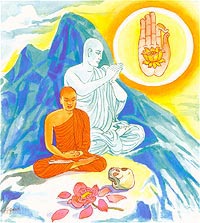 |
Verse 277. Conditioned Things Are Transient
Explanation: All component things, all things that have been |
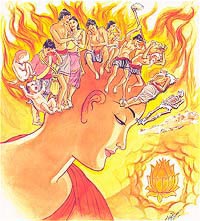 |
Verse 278. All Component Things Are Sorrow
Explanation: All component things - |
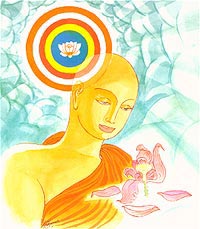 |
Verse 279. Everything Is Soul-less
Explanation: All states of being are without a self. When |
Dhammapada Verses 277, 278 and 279
Aniccalakkhana Vatthu
Dukkhalakkhana Vatthu
Anattalakkhana Vatthu“Sabbe sankhara anicca” ti
yada pannaya1 passati
atha nibbindati dukkhe
esa maggo visuddhiya.“Sabbe sankhara dukkha” ti
yada pannaya passati
atha nibbindati dukkhe
esa maggo visuddhiya.“Sabbe sankhara anatta” ti
yada pannaya passati
atha nibbindati dukkhe
esa maggo visuddhiya.Verse 277: “All conditioned phenomena are impermanent”; when one
sees this with Insight-wisdom, one becomes weary of dukkha (i.e., the khandhas).
This is the Path to Purity.Verse 278: “All conditioned phenomena are dukkha”; when one sees
this with Insight-wisdom, one becomes weary of dukkha (i.e., the khandhas). This
is the Path to Purity.Verse 279: “All phenomena (dhammas) are without Self”; when one
sees this with Insight-wisdom, one becomes weary of dukkha (i.e., the khandhas).
This is the Path to Purity.
1. panna: Insight-wisdom (Vipassana panna).
Stories Relating to Anicca, Dukkha and Anatta
While residing at the Jetavana monastery, the Buddha uttered Verses (277),
(278) and (279) of this book, with reference to three groups of five hundred
bhikkhus each.On Impermanence (Anicca)
Five hundred bhikkhus, after receiving their subject of meditation from the
Buddha, went into the forest to practise meditation, but they made little
progress. So, they returned to the Buddha to ask for another subject of
meditation which would suit them better. On reflection, the Buddha found that
those bhikkhus had, during the time of Kassapa Buddha, meditated on
impermanence. So, he said, “Bhikkhus, all conditioned phenomena are
subject to change and decay and are therefore impermanent.”Then the Buddha spoke in verse as follows:
Verse 277: “All conditioned phenomena are
impermanent”; when one sees this with Insight-wisdom, one becomes
weary of dukkha (i.e., the khandhas). This is the Path to Purity.
At the end of the discourse those five hundred bhikkhus attained arahatship.
On Dukkha
The story is the same as the story on Anicca. Here, the Buddha on reflection
found that another group of five hundred bhikkhus had meditated on dukkha. So,
he said, “Bhikkhus, all khandha aggregates are oppressive and
unsatisfactory; thus all khandhas are dukkha.”Then the Buddha spoke in verse as follows:
Verse 278: “All conditioned phenomena are
dukkha”; when one sees this with Insight-wisdom, one becomes
weary of dukkha (i.e., the khandhas). This is the Path to Purity.
At the end of the discourse those five hundred bhikkhus attained arahatship.
On Insubstantiality or Non-Self (Anatta)
The story is the same as the stories on Anicca and Dukkha. Here, the Buddha
on reflection found that still another group of five hundred bhikkhus had
meditated on insubstantiality or non-self (anatta). So, he said,
“Bhikkhus, all khandha aggregates are insubstantial; they are not subject
to one’s control.”Then the Buddha spoke in verse as follows:
Verse 279: “All phenomena (dhammas) are without
Self”; when one sees this with Insight-wisdom, one becomes weary
of dukkha (i.e., the khandhas). This is the Path to Purity.
At the end of the discourse all those five hundred bhikkhus attained
arahatship.
Utah
• Kanzeon Zen Center, Salt Lake City
http://en.wikipedia.org/wiki/Salt_Lake_City,_Utah
| Salt Lake City | |||
|---|---|---|---|
| — State Capital — | |||
| City of Salt Lake City | |||
|
From top left: The skyline in July 2011, the Salt Lake Temple, Utah State Capitol, UTA TRAX, the City and County Building, Union Pacific Depot and the Block U. |
|||
|
|||
| Nickname(s): “The Crossroads of the West” | |||
|
Location of Salt Lake City in Salt Lake County, Utah |
|||
| Coordinates: 40°45′0″N 111°53′0″WCoordinates: 40°45′0″N 111°53′0″W | |||
| Country | United States | ||
| State | Utah | ||
| County | Salt Lake | ||
| Government | |||
| • Mayor | Ralph Becker | ||
| Area | |||
| • State Capital | 110.4 sq mi (285.9 km2) | ||
| • Land | 109.1 sq mi (282.5 km2) | ||
| • Water | 1.3 sq mi (3.3 km2) | ||
| Elevation | 4,226 ft (1,288 m) | ||
| Population (2011) | |||
| • State Capital | 189,899 (127th in U.S.) | ||
| • Density | 1,666/sq mi (643.3/km2) | ||
| • Urban | 2,328,299 | ||
| • Metro | 1,145,905 (48th in U.S.) | ||
| • Demonym | Salt Laker | ||
| Time zone | Mountain (UTC-7) | ||
| • Summer (DST) | Mountain (UTC-6) | ||
| Area code(s) | 385, 801 | ||
| FIPS code | 49-67000[1] | ||
| GNIS feature ID | 1454997[2] | ||
| Website | www.slcgov.com | ||
Salt Lake City, often shortened to Salt Lake or SLC, is the capital and the most populous city of the U.S. state of Utah. With a population of 189,899 as of the 2011 estimate,[3] the city lies in the Salt Lake City metropolitan area, which has a total population of 1,145,905. Salt Lake City is further situated in a larger urban area known as the Wasatch Front, which has a population of 2,328,299.[4] It is one of only two major urban areas in the Great Basin (the other being Reno, Nevada), and the largest in the Intermountain West.
The city was founded in 1847 by Brigham Young and his Mormon followers, who extensively irrigated and cultivated the arid valley. Due to its proximity to the Great Salt Lake, the city was originally named “Great Salt Lake City”—the word “great” was dropped from the official name in 1868.[5] Although Salt Lake City is still home to the headquarters of The Church of Jesus Christ of Latter-day Saints (LDS Church), fewer than half the population of Salt Lake City proper are members of the LDS Church today.[6]
Immigration of international LDS members, mining booms, and the construction of the first transcontinental railroad initially brought economic growth, and the city was nicknamed the Crossroads of the West. It was traversed by the Lincoln Highway, the first transcontinental highway, in 1913, and presently two major cross-country freeways, I-15 and I-80, intersect in the city. Salt Lake City has since developed a strong outdoor recreation tourist industry based primarily on skiing, and was host to the 2002 Winter Olympics. It is the industrial banking center of the United States.[7]
[27]
| O |
NCE upon a time the people in a certain town
went out into the woods for a holiday.
They took baskets full of good things to eat.
But when noontime came they ate all the meat
they had brought with them, not leaving any for supper.
“I will get some fresh meat. We will make a fire here and roast it,”
said one of the men.
So taking a club, he went to the lake where the animals came to drink.
He lay down, club in hand, pretending to be dead.
![[Illustration]](http://www.mainlesson.com/books/babbitt/morejataka/zpage028.gif)
When the animals came down to the lake
they saw the man lying there and they watched him for some time.
“That man is playing a trick on us, I believe,”
said the King of the Wolves. “The rest of you stay here
while I will see whether he is really dead,
or whether he is pretending to be dead.”
[28] Then the cunning King of the Wolves crept up to the Man
and slyly pulled at his club.
At once the man pulled back on his club.
Then the King of the Wolves ran off saying:
“If you had been dead, you would not have pulled back on your club
when I tried to pull it away. I see your trick.
You pretend you are dead so that you may kill one of us for your supper.”
The man jumped up and threw his club at the King of the Wolves.
But he missed his aim. He looked for the other animals
but there was not one in sight. They had all run away.
[29] Then the man went back to his friends, saying:
“I tried to get fresh meat by playing a trick on the animals,
but the cunning Wolf played a better trick on me,
and I could not get one of them.”
![[Illustration]](http://www.mainlesson.com/books/babbitt/morejataka/zpage029.gif)
Crystal Hot Springs has been a favorite spot …
This is a truly Deluxe RV Park. Located at Big Rock Candy Mountain
Resort in Marysvale, Utah, you’ll have easy access to shopping,
restau…
Enjoy spectacular mountain views from your campsite. See the …
Places to go in New Mexico with kids |
Things to do in Nevada
What to do in Colorado |
Things to do in Idaho with kids |
Places to visit in Arizona
What is there to do in Salt Lake City for kids |
Things to do with kids in Ogden |
Things for kids to do in Orem |
Places to visit in Logan with kids |
Fun places for kids in Provo
VOICE OF SARVAJAN
–
Regards,
Ritesh M

UPASAKA JAGATHEESAN CHANDRASEKHARAN
The Awaken One with Awareness assert that, “The way to change the world is to change the nature of man,”that offers Insight to Improve Conditions for Planet, Inhabitants.
The world needs waves of reforms.
Generate an opportunity to set the world on a more equitable and sustainable path of development.
AOA much to offer that process. AOA assert that, “The way to change the world is to change the nature of man,” offers a critical insight into how to improve conditions for our planet and its inhabitants.
The spirit to care not just for ourselves but for others, based on an awareness of our interlinked fates, lies at the heart of AOA- and, indeed, all of the world’s great religions.
These thoughts challenge families, communities and nations to act in concert for the advancement of our common well-being. That is the best way to secure individual and collective progress in an interdependent world.
We must also change longstanding assumptions and open our minds to new ideas and possible solutions if we are to address major global threats, from the proliferation of deadly weapons to intolerance and inequality.
We must invite Awaken Ones with Awareness and people of all traditions to use the occasion to reflect on how we can change our actions to pave the way for a more sustainable future.
Awakened One with Awareness bequeathed to humanity profound thoughts that can guide our efforts to resolve the severe problems facing today’s world.
Injunction against the three poisons of greed, anger and ignorance is especially relevant to multilateral efforts to overcome the hunger that needlessly affects nearly a billion people in a world of plenty, the brutal violence that takes millions of lives each year, and the senseless environmental damage that humans cause to our only home, the planet Earth.
Socio-economic development may sound modern, but its core is the very problem of human suffering that was addressed more than 2,500 years ago.
Numerous Awakened One With Awareness organizations are putting these thoughts into practice. Their support is for activities to achieve the Millennium Development Goals, our blueprint for enabling all people to enjoy lives of dignity and opportunity.
Let us draw on the universal values of Awakened Ones With Awareness to act in solidarity with those who are suffering, thereby contributing to a more compassionate and awakened world for all.
ECONOMY OF THE AWAKEN ONE WITH AWARENESS (AOA) is to provide all people with a minimum income.
Radiation theory sees the economy prospering through the virtuous actions of individuals following the moral law.
AOA accept existing political and economic institutions, even while providing a democratic social ethos revolutionary for its time.
King Asoka, greatest of all Indian emperors, pursued a highly activist fiscal policy even though he believed only meditation could help people to advance in moral living.
AOA places great stress on gift giving.
Income Redistribution in the Ideal State
Through the laws of cause and condition there is a distributive cycle of one’s current social and economic position is due to one’s good cause and condition accumulated in the past. This does not mean indifference to the poor, for one’s economic status is not only dependent on the laws of cause and condition, but is also complemented by the moral virtues of compassion and generosity.’ Alms giving to the poor is regarded as increasing one’s merit The importance of our active intervention has some important implications for behavior of the “righteous ruler” as well.
AOA kings are also known for the financial aid which they provided for the poor; indeed, the kings were advised to give their gifts to all who are poor. Moreover, gifts to the those who practice AOA do not prevent them from providing a refuge for the destitute or from redistributing such beneficence to the indigent.
Redistribution of income, either through the public or private, sectors, is certainly regarded in a favorable light. In order to favor the spiritual improvement of the population, the State is justified in taking steps to provide all people with a minimum income.
Radiation: Virtue as a Positive Externality
AOA theory of radiation sees the economy prospering through the collective impact of the virtuous actions of individuals.
AOA argue that since the economy can ultimately prosper only through virtuous action, ultimately the only hope for prosperity lies in a regeneration of human kind, e.g., through the cultivation of the Four Sublime Abodes (loving kindness, compassion, sympathetic joy, and equanimity). Any appropriate good action inevitably leads to an increase of the material wealth of the community.
Trade Through the Market
AOA discussion on right livelihood prohibits trade in certain goods and services, which means that all other types of trade are apparently allowed (but not explicitly approved). In an interesting
comparison between trading and agriculture as means of livelihood, the AOA also notes that both can bring high or low returns, depending on the circumstances; however, trading is an occupation with little to do, few duties, a small administration, and small problems, while agriculture is the reverse. The capable merchant is approvingly said to know the value of goods and prices and the profits he obtains; and to buy where the price is low and to sell where the price is high.
A merchant who was generous to the cause was highly praised for his piety.
AOA accepts competition in general in the sense that it is possible to compete without hurting others,excel in virtue.
“prizes in the school of life that each may strive for to obtain…. If a man chooses to interpret this as free competition, it is still competition without rivalry, for victory to oneself does not mean the defeat of someone else.”
Economic Policies
Description of the origins of property also discusses the origins of the State. As crime increased after the division of the land, the people elected a king to maintain law and order, paying him for his troubles. This suggests a type of social contract theory, which means that the king has important obligations toward the people.
Some of the discussion about economic policy are traditional Ten Royal Precepts of Kingship: generosity, morality, liberality, uprightness, gentleness, self-restraint, non-anger, non-hurtfulness, forbearance, and non-opposition.
However, more practical advice can also be found. For instance, one of the sources, speaks of the Royal Acts to increase prosperity which include giving of seed corn and food to farmers and of capital to merchants to start or increase their business. The particular source emphasizes that if prosperity increases, economic disorders and crime such as theft decrease.
Additional insight into State economic activities can be gained by examining the records of some of the “righteous rulers” who are revered by the AOA. It should be noted that because of the participation of the State in the operations of the irrigation systems in many of these countries, the crown had a fairly active role in the economy.
The prototypical important righteous ruler was the revered King Asoka (Ashoka) (ca. 274-232 B.C.E.), the grandson of the founder of the Mauryan dynasty in indict and one of the greatest of the Indian emperors.2 From Asoka’s edicts it appears that he generally accepted the economic and political institutions of his time.
However, he also took as the goal of statecraft the welfare and happiness of the people. He adopted a highly activist fiscal policy, both with regard to current and capital expenditures. For instance, he gave gifts to the aged, other needy, and religious orders; he set up public education courses to teach the doctrines of Rule of the Law; he cut back on large public festivals; he imported and planted medicinal herbs; and he carried out various public works projects such as digging of wells, planting of trees, construction of rest houses and animal watering stations along main roads in the empire. Some of his edicts appeared to enforce traditional AOA beliefs, e.g, bans on slaughtering various animals. The funds spent on the maintenance of the crown and good works were high, e.g., taxes were apparently about one fourth of the revenue of land.
Still another righteous ruler was King Ruang who lived in the 14th century in Thailand, long after the canonical scriptures had been completed. Ruang stated quite clearly that a righteous king brings prosperity to his subjects. He apparently had a much less luxurious court or a less activist governmental expenditure policy than Asoka, since he advised that taxes should be less than 10 percent of the crop (and less in a drought) and that such taxes should never be higher than those of the preceding king. He also urged that the State provide interest free loans to those wishing to engage in commerce and that no profit taxes should be placed upon such commercial activities.
Awaken One with Awareness (AOA) and Politics
The Awaken One with Awareness (AOA) had gone beyond all worldly affairs, but still gave advice on good government.
The AoA came from a warrior caste and was naturally brought into association with kings, princes and ministers. Despite His origin and association, He never resorted to the influence of political power to introduce His thoughts nor allowed His Thoughts to be misused for gaining political power. But today, many politicians try to drag the AOA’s name into politics by introducing Him as a communist, capitalist, or even an imperialist. They have forgotten that the new political philosophy as we know it really developed in the West long after the AOA’s time. Those who try to make use of the good name of the AOA for their own personal advantage must remember that the AOA was the Supremely Awaken One who had gone beyond all worldly concerns.
There is an inherent problem of trying to intermingle religion with politics. The basis of religion is morality, purity and faith, while that for politics is power. In the course of history, religion has often been used to give legitimacy to those in power and their exercise of that power. Religion was used to justify wars and conquests, persecutions, atrocities, rebellions, destruction of works of art and culture.
When religion is used to pander to political whims, it has to forego its high moral ideals and become debased by worldly political demands.
The thrust of the AOA Rule of Law is not directed to the creation of new political institutions and establishing political arrangements. Basically, it seeks to approach the problems of society by reforming the individuals constituting that society and by suggesting some general principles through which the society can be guided towards greater humanism, improved welfare of its members, and more equitable sharing of resources.
There is a limit to the extent to which a political system can safeguard the happiness and prosperity of its people. No political system, no matter how ideal it may appear to be, can bring about peace and happiness as long as the people in the system are dominated by greed, hatred and delusion. In addition, no matter what political system is adopted, there are certain universal factors which the members of that society will have to experience: the effects of good and bad Cause and Condition, the lack of real satisfaction or everlasting happiness in the world characterized by unsatisfactoriness, impermanence), and egolessness. To the AOA, nowhere in Samsara is there real freedom, not even in the heavens or the world of Brahama.
Although a good and just political system which guarantees basic human rights and contains checks and balances to the use of power is an important condition for a happy in society, people should not fritter away their time by endlessly searching for the ultimate political system where men can be completely free, because complete freedom cannot be found in any system but only in minds which are free. To be free, people will have to look within their own minds and work towards freeing themselves from the chains of ignorance and craving. Freedom in the truest sense is only possible when a person uses Rule of Law to develop his character through good speech and action and to train his mind so as to expand his mental potential and achieve his ultimate aim of awaken-ness.
While recognizing the usefulness of separating religion from politics and the limitations of political systems in bringing about peace and happiness, there are several aspects of the AOA’s thoughts which have close correspondence to the political arrangements of the present day. Firstly, the AOA spoke about the equality of all human beings long before Abraham Lincoln, and that classes and castes are artificial barriers erected by society. The only classification of human beings, according to the AOA, is based on the quality of their moral conduct. Secondly, the AOA encouraged the spirit of social -co-operation and active participation in society. This spirit is actively promoted in the political process of modern societies. Thirdly, since no one was appointed as the AOA’s successor, the members of the Order were to be guided by the Rule of Law. Until today very member of the Order is to abide by the Rule of Law which governs and guides their conduct.
Fourthly, the AOA encouraged the spirit of consultation and the democratic process. This is shown within the community of the Order in which all members have the right to decide on matters of general concern. When a serious question arose demanding attention, the issues were put before the monks and discussed in a manner similar to the democratic parliamentary system used today. This self-governing procedure may come as a surprise to many to learn that in the assemblies of AOAs in India 2,500 years and more ago are to be found the rudiments of the parliamentary practice of the present day. A special officer similar to ‘Mr. Speaker’ was appointed to preserve the dignity of the Parliamentary Chief Whip, was also appointed to see if the quorum was secured. Matters were put forward in the form of a motion which was open to discussion. In some cases it was done once, in others three times, thus anticipating the practice of Parliament in requiring that a bill be read a third time before it becomes law. If the discussion showed a difference of opinion, it was to be settled by the vote of the majority through balloting.
The AOA approach to political power is the moralization and the responsible use of public power. The AOA preached non-violence and peace as a universal message. He did not approve of violence or the destruction of life, and declared that there is no such thing as a ‘just’ war. He taught: ‘The victor breeds hatred, the defeated lives in misery. He who renounces both victory and defeat is happy and peaceful.’ Not only did the Buddha teach non-violence and peace, He was perhaps the first and only religious teacher who went to the battlefield personally to prevent the outbreak of a war. He diffused tension between the Sakyas and the Koliyas who were about to wage war over the waters of Rohini. He also dissuaded King Ajatasattu from attacking the Kingdom of the Vajjis.
The AOAdiscussed the importance and the prerequisites of a good government. He showed how the country could become corrupt, degenerate and unhappy when the head of the government becomes corrupt and unjust. He spoke against corruption and how a government should act based on humanitarian principles.
The AOA once said, ‘When the ruler of a country is just and good, the ministers become just and good; when the ministers are just and good, the higher officials become just and good; when the higher officials are just and good, the rank and file become just and good; when the rank and file become just and good, the people become just and good.
The AOA said that immorality and crime, such as theft, falsehood, violence, hatred, cruelty, could arise from poverty. Kings and governments may try to suppress crime through punishment, but it is futile to eradicate crimes through force.
The AOA suggested economic development instead of force to reduce crime. The government should use the country’s resources to improve the economic conditions of the country. It could embark on agricultural and rural development, provide financial support to entrepreneurs and business, provide adequate wages for workers to maintain a decent life with human dignity.
The AOA had gtiven to rules for Good Government. These ten rules can be applied even today by any government which wishes to rule the country peacefully. The rules are as follows:
1) be liberal and avoid selfishness,
2) maintain a high moral character,
3) be prepared to sacrifice one’s own pleasure for the well-being of the subjects,
4) be honest and maintain absolute integrity,
5) be kind and gentle,
6) lead a simple life for the subjects to emulate,
7) be free from hatred of any kind,
8) exercise non-violence,
9) practice patience, and
10) respect public opinion to promote peace and harmony.
Regarding the behavior of rulers, He further advised:
- A good ruler should act impartially and should not be biased and discriminate between one particular group of subjects against another.
- A good ruler should not harbor any form of hatred against any of his subjects.
- A good ruler should show no fear whatsoever in the enforcement of the law, if it is justifiable.
- A good ruler must possess a clear understanding of the law to be enforced. It should not be enforced just because the ruler has the authority to enforce the law. It must be done in a reasonable manner and with common sense.
‘If a man, who is unfit, incompetent, immoral, improper, unable and unworthy of kingship, has enthroned himself a king or a ruler with great authority, he is subject to be tortured‚ to be subject to a variety of punishment by the people, because, being unfit and unworthy, he has placed himself unrighteously in the seat of sovereignty. The ruler, like others who violate and transgress moral codes and basic rules of all social laws of mankind, is equally subject to punishment; and moreover, to be censured is the ruler who conducts himself as a robber of the public. It is mentioned that a ruler who punishes innocent people and does not punish the culprit is not suitable to rule a country.
The king always improves himself and carefully examines his own conduct in deeds, words and thoughts, trying to discover and listen to public opinion as to whether or not he had been guilty of any faults and mistakes in ruling the kingdom. If it is found that he rules unrighteously, the public will complain that they are ruined by the wicked ruler with unjust treatment, punishment, taxation, or other oppressions including corruption of any kind, and they will react against him in one way or another. On the contrary, if he rules righteously they will bless him: ‘Long live His Majesty.’ (Majjhima Nikaya)
The AOA’s emphasis on the moral duty of a ruler to use public power to improve the welfare of the people had inspired Emperor Asoka in the Third Century B.C. to do likewise. Emperor Asoka, a sparkling example of this principle, resolved to live according to and preach the Rule of Law and to serve his subjects and all humanity. He declared his non-aggressive intentions to his neighbors, assuring them of his goodwill and sending envoys to distant kings bearing his message of peace and non-aggression. He promoted the energetic practice of the socio-moral virtues of honesty, truthfulness, compassion, benevolence, non-violence, considerate behavior towards all, non-extravagance, non-acquisitiveness, and non-injury to animals. He encouraged religious freedom and mutual respect for each other’s creed. He went on periodic tours preaching the Rule of Law to the rural people. He undertook works of public utility, such as founding of hospitals for men and animals, supplying of medicine, planting of roadside trees and groves, digging of wells, and construction of watering sheds and rest houses. He expressly forbade cruelty to animals.
Sometimes the AOA is said to be a social reformer. Among other things, He condemned the caste system, recognized the equality of people, spoke on the need to improve socio-economic conditions, recognized the importance of a more equitable distribution of wealth among the rich and the poor, raised the status of women, recommended the incorporation of humanism in government and administration, and taught that a society should not be run by greed but with consideration and compassion for the people. Despite all these, His contribution to mankind is much greater because He took off at a point which no other social reformer before or ever since had done, that is, by going to the deepest roots of human ill which are found in the human mind. It is only in the human mind that true reform can be effected. Reforms imposed by force upon the external world have a very short life because they have no roots. But those reforms which spring as a result of the transformation of man’s inner consciousness remain rooted. While their branches spread outwards, they draw their nourishment from an unfailing source — the subconscious imperatives of the life-stream itself. So reforms come about when men’s minds have prepared the way for them, and they live as long as men revitalize them out of their own love of truth, justice and their fellow men.
The doctrine preached by the AOA is not one based on ‘Political Philosophy’. Nor is it a doctrine that encourages men to worldly pleasures. It sets out a way to attain Eternal Bliss. In other words, its ultimate aim is to put an end to craving that keeps them in bondage to this world.’The path that leads to worldly gain is one, and the path that leads to Eternal Bliss (by leading a religious life)is another.’
However, this does not mean that AOAs cannot or should not get involved in the political process, which is a social reality. The lives of the members of a society are shaped by laws and regulations, economic arrangements allowed within a country, institutional arrangements, which are influenced by the political arrangements of that society. Nevertheless, if a AOAwishes to be involved in politics, he should not misuse religion to gain political powers, nor is it advisable for those who have renounced the worldly life to lead a pure, religious life to be actively involved in politics.
Putting Awaken One with Awareness (AOA) to Work:
A New Approach to Management and Business
Awaken One with Awareness (AOA) Economics: The Emerging Middle Path between Capitalism and Socialism
A novel approach to economic management that goes beyond socialism and capitalism. The proposed economics for the 21st century is ‘Awaken One with Awareness (AOA) Economics’.
Based on the insight of the Awaken One with Awareness (AOA) that spiritual liberation is attained by avoiding extremes, whether by indulgence in worldly pleasures or severe asceticism, and treading namely ‘ the Middle Way ‘, ‘Awaken One with Awareness (AOA) Economics ‘ is recommended as the ideal middle path between the competing models of capitalism and socialism. Both these systems, have failed to contain the relentless destruction of the natural environment and the human community, thereby forcing leading executives and planners to search for new solutions for planetary problems.
Best aspects of both capitalist and socialist economic systems is drawn in ‘ Awaken One with Awareness (AOA) Economics ‘ model. It supports the conventional forces of a free market and competition without destroying either nature or human society. Alternate vision of sustainable economics is meant to be more just and more ecologically sound.
Inspired by the fundamental AOA insight of the inter-connectedness existing among all living things, that AOA, Economics and Ecology are all inter-related. There is a heavy emphasis on the concept of freedom as understood in AOA in contrast to the Western concept of ‘freedom’. In the West ‘freedom’ revolves around the rights of the individual i.e. freedom to do what one wishes. In AOA, ‘freedom’ means freedom from personal desires or attachments.
An AOA approach to economics requires an understanding that economics and a moral and spiritual life are neither separate nor mutually exclusive. The 20th Century has been ravaged by a materialistic, self-centered consumerism. The next century needs to focus on the quality and spirituality of life itself. AOA, which advocates the ‘Middle Path’, serves as an important resource to pursue an alternative to the extremes of capitalism and socialism, or pure self-interest and utter self-negation.
The Essence of Awaken One with Awareness (AOA) Economics
Three key phrases are identified that underlie the model of Awaken One with Awareness (AOA) Economics.
They are:
1) an economics that benefits oneself and others
2) an economics of tolerance and peace
3) an economics that can save the earth.
An Economics that benefits oneself and others
Theory of free enterprise based on the concept of self-benefit is developed. This led to people being more concerned with enriching themselves and disregarding the interests of others. At the international level, major colonial powers such as England, Netherlands, France, Portugal and Spain developed their economies from the resources taken from other poorer regions, without an adequate resulting benefit accruing to the colonies. In contrast, the earlier AOA societies such as India during the time of the AOA or Japan during the time of Prince Shotuku ( 574 - 622 AD ) existed with a radically different social approach. In Japanese society where the density of population was high, human relations were tightly interwoven, and Japanese people were encouraged to pay great attention to how other people thought or reacted. In the Japanese world of business, earning the trust of others and entering into mutually beneficial transactions have always been given priority. Such conduct was the result of deep-seated AOA influence.
The Western obsession with ’self-benefit ‘ and indifference to the rights of non-European people has been well analysed by former Indian diplomat K.M.Panikkar in his ground breaking book ‘Asia and Western Domination - A Survey of the Vasco De Gama Epoch of Asian History 1498 - 1945, published in 1953. Panikkar says that western colonial powers were reluctant to recognise that doctrines of international law applied outside Europe or that European nations had any moral obligations when dealing with Asian people. For example, when Britain insisted on the opium trade against the laws of China in the 19th Century, there was a prohibition by law on opium smoking in England. In countries under direct British occupation eg. India, Ceylon and Burma, though there were equal rights established by law, there was considerable reservation in enforcing the law against Europeans. Maurice Collis, a British magistrate in Burma, gives a rare candid account in his book ‘Trials in Burma’ ( 1938 ) about the pressures brought upon him by the members of the Colonial Government and the British expatriate community, to be partial towards Europeans in his judgments. Panikkar avers that this doctrine of different rights (which made a mockery of the concept of the Rule of Law) persisted to the very end of western colonial domination and was a prime cause of Europe’s ultimate failure in Asia.
An Economics of Tolerance and Peace
The Indian Emperor Asoka established the world’s first welfare state in the third century BC upon embracing AOA approach. He renounced the idea of conquest by the sword. In contrast to the western concept of ‘ Rule of Law ‘, Asoka embarked upon a ‘policy of piety or rule of righteousness’. The basic assumption of this policy of piety was that the ruler who serves as a moral model would be more effective than one who rules purely by strict law enforcement. The right method of governing is not only by legislation and law enforcement, but also by promoting the moral education of the people. Asoka began by issuing edicts concerning the ideas and practice of Rule of Law, dealing with universal law and social order. Realizing that poverty eroded the social fabric, one of his first acts was to fund social welfare and other public projects. Asoka’s ideals involved promoting policies for the benefit of everyone in society, treating all his subjects as if they were his children and protecting religion. He built hospitals, animal welfare shelters and enforced a ban on owning slaves and killing. He gave recognition to animal rights in a number of his rock edicts and accepted state responsibility for the protection of animals. Animal sacrifice was forbidden by law.
An important aspect of Asoka’s economics of peace was tolerance. In one of his rock edicts, Asoka calls for religious freedom and tolerance, and declares that by respecting someone else’s religion, one brings credit to one’s own religion. The idea of religious tolerance only emerged in the West in 1689 with the publication of John Locke’s book ‘ A Letter Concerning Toleration ‘.
From a AOA perspective, politics can be summed up by the wheel turner, which means a king or political ruler who protects his people and the AOAt teachings. Asoka was the prototype of this ruler whose political ideas were to inspire a countless number of other Asian Emperors and rulers. One enthusiastic follower of Asoka in Japan was Prince Shotuku. (574 - 622 AD ). An ardent believer in AOA approach, Shotukti drafted a 17 Article Constitution (the first AOA approach Constitution of Japan), which was promulgated in 604 AD. Shotuku appeals neither to ’self-evident truths ‘ (as in the American Constitution ) nor to some divine right of kings as the basis of law. Instead he begins pragmatically by stating that if society is to work efficiently for the good of all, then people must restrain factionalism and learn to work together. A key feature of this Constitution is the emphasis placed on resolving differences by appeals to harmony and common good, using the procedure of consensus. This approach is in marked contrast to the western view that factions can be controlled only legally by a balance of powers. Decision making by consensus is a significant characteristic of Japanese society. Every effort is made to ensure that minority dissident factions are not allowed to lose face.
The influence of AOA approach in Japan was such that in 792 AD Emperor Kammu (781 - 806 AD) despite constant threats from Korea, abolished the 100 year old national army, except for one regiment to guard the region near Korea. National security was maintained by sons of local clan leaders somewhat similar to the present day police. Japan was effectively without an army until the emergence of the new warrior class before the Kamakura, Shogunate (1192 - 1333 AD). Tibet is another example of demilitarisation (in the 17th century). What is significant to note here is that long before the ideal of demilitarisation was espoused in western countries, ancient Buddhist countries had already implemented it. In Japan, beginning from the 9th century, the death penalty was abolished for nearly three and a
half centuries.
An Economics to save the Earth
The practice of industrial societies indulging in a policy of take-and-take from nature is criticized, despite economics being fundamentally about exchange or give-and-take.A possible root cause of the western attitude towards nature. This passage declares:
“So God created man in his own image, in the image created he him, male and female created he them. And God blessed them, and God said unto them, “Be fruitful and multiply, and replenish the earth and subdue it, and have dominion over the fish of the sea, and over the fowl of the air, and over every living thing that moveth upon the earth”.
Some have interpreted this passage literally, as one giving divine sanction to domination of the earth for the benefit of only human beings and disregarding the interests of both plants and other living creatures of this world. In contrast, AOA approach sacred texts are much more humble and always emphasise the need to live in harmony with nature and peacefully co-exist with other living creatures, as the ideal and noble way. In the AOA approach worldview, humans rather being masters of this earth, simply make up one tiny element in a vast cosmos. In the AOA approach Economics that proposes, the earth rather than human beings will be placed at the center of our worldview.
History of Economics
The major ideas in the theories of prominent economists such as Adam Smith (1723 - 1790), David Ricardo (1772 - 1823), Karl, Marx (1818 - 1883), John Keynes (1883 - 1946) Joan Robinson (1903 - 1983) and the German Economists Friedrich von Hayek (1899 - 1992), Wilhelm Lopke (1899 - 1966) and Ludwig Erhard (1897 - 1977) is examined.Lopke’s best-selling book ‘ Civitas Humanas (Human Citizen) published in 1949 as laying the foundation for the new humanistic school of economics is singled out.The concept of `social market economics’ advocated by Ludwig Erhard in his 1957 book ‘Woffistand fur Alles (Happiness for All ) as the precedent for developing the new AOA approach Economics is used. Erhard called for the need to overcome the inherent tensions between the haves and have-nots in society, through such governmental policies as the banning of cartels, using government ‘price valuation’ to ensure fair pricing, rent control and supporting people with disabilities.
Dr. E.F Schumacher’s book ‘Small is Beautiful’, which has a chapter on AOA approach Economics is an inspiration. Schumacher was heavily influenced by AOA approach meditation and wisdom during his time in Myanmar (formerly Burma). Though Schumacher recommended a new approach to economics based on AOA approach, that Schumacher’s ultimate solutions were sought in Christian oriented ethics. Nevertheless, that Schumacher’s book should serve as a wake up call for those living in AOA approacht countries. He further says that given the destruction of the natural environment that has taken place in the industrial West, the time has come to use a
AOA approach to economics.
Historical Background of Awaken One with Awareness (AOA) Economics
The life story of the AOA offers a valuable lesson when focusing on AOA approach economics. The Prince rejected the material comforts of a royal life, and also realised the futility of asceticism and denial of natural physical needs. ‘’The AOA walked a fine line between materialism and denial of the world, and this middle way or moderate standpoint is fundamental to understanding AOA Economics’.
The ordinary public and the merchant class supported AOA approach from the very outset. As AOA approach moved eastwards over the centuries, to China, Korea and Japan it absorbed elements of the culture of these countries and became transformed along the way. It also managed to transform the societies and economies of these countries by introducing ethical concepts into the pursuit of profit. In Japanese history there has been substantial AOA approach support of commerce, which had come to fruition during the Edo period (1603 - 1867). This period witnessed an explosion of economic activity. Some sociologists have found interesting parallels in the connections between the Protestant work ethic and capitalism, and between the rise of Japanese Capitalism and the religious thought of the time.
Unrestrained Consumption
The world’s natural resources would be depleted if two factors are not immediately addressed:
1) the ever increasing population growth, and
2) the mismanagement of desire ( particularly of those people in the so-called advanced countries)
In the Ryoan-ji, the AOA Temple of Kyoto, famous for its stone and sand garden, there is a poem carved on a stone, which says ‘ Know what one really needs ‘. This is no simple injunction. To know what one really needs in life requires great wisdom. But to have the strength to say ‘no’ to the unessential products in life would release a person from the coils of consumption. This view i.e. of wanting what is really essential reflects the AOA approach view of consumption and it is the ideal attitude to be promoted in the coming century.
Right Livelihood
Right livelihood is one of the components of the Noble Eightfold Path. Its importance lies in the fact that the work one does for a living influences a person’s thinking. The AOA has named five types of occupations as unwholesome ways of earning a living. They are 1) Selling liquor or being connected with the production and sale of liquor 2) Sale of flesh or being connected with the raising and killing of animals 3) Poison (includes drugs) 4) Trading in living beings (includes slavery or for similar purposes) 5) Dangerous weapons.
The layman’s code of discipline or gihi vinaya is the premise for developing the right work ethic for the next century. In one passage AOA says “One should work like a bee to earn one’s livelihood. Do not wait for others to help, nor depend on others foolishly”.AOA showed his concern for the material welfare and the spiritual development of his lay disciples. In the discourse to young Sigala, the AOA explained the full range of duties owed by a layman to all those with whom he interacts. The AOA also indicated how wealth has to be spent i.e. one portion for one’s needs, which includes offerings to Order of AOA and charity, two portions on investment and the fourth portion to be kept for an emergency.
Japanese entrepreneurs who had incorporated AOA principles and meditation techniques in their day to day work in an effort to develop a more humanistic and environmentalist business ethic.
Awaken One with Awareness (AOA) Economic Vision
Provides food for thought to anyone wishing to adopt an innovative approach to Management and Business. However the greatest appeal of this highly readable book lies in the elaborate development of Schumacher’s profound insight that there is another way of approaching economics, based on the ideas taught in the East 2500 years ago, particularly of the fundamental interconnectedness of people and nature. It is upon this premise that the world can shift from a throw-away culture to a more sustainable* civilisation. This work also throws a challenge to governments in AOA approach countries to develop a AOA economic vision as a part of national planning, as we move towards a new millennium.
Three Ambedkar statues vandalised in UP
![]()
![]()
Sat,28 Jul 2012
Two days after a statue of former Uttar Pradesh chief minister Mayawati
was vandalised in Lucknow, three statues of Dalit icon BR Ambedkar were
damaged in Azamgarh district, police said on Saturday.
Broken pieces of a statue were found in the morning in a field at Katat-Chakkatat
village in Azamgarh, some 270 km from Lucknow, police said.
Two other Ambedkar statues were vandalised and thrown in the fields
of the Nayi Palia and Jiyasath villages, said Superintendent of Police
(SP) Mirza Manzar Beg.
Angry villagers and Bahujan Samaj Party (BSP) workers took to the
streets and blocked a state highway for over four hours, protesting
against the incidents.
Heavy police reinforcements were rushed to the spot and new statues of Ambedkar were installed, police said.

ALL ABOUT AWAKEN ONES WITH AWARENESS USA
TEXAS
Wat Buddhavas Buddhist temple in Houston, Texas
• Chua Buu Mon, Port Arthur
• Chua Linh-Son Buddhist Temple, Austin
• Maria Kannon Zen Center, Dallas
• Wat Buddhavas of Houston, Houston
• Wat Buddhananachat of Austin, Del Valle
This sutta is widely considered as a the main reference for meditation practice.
|
|
|
| (4) Puna ca·paraṃ, bhikkhave, bhikkhu seyyathāpi passeyya sarīraṃ sivathikāya chaḍḍitaṃ aṭṭhika·saṅkhalikaṃ ni·maṃsa·lohita·makkhitaṃ nhāru·sambandhaṃ, so imam·eva kāyaṃ upasaṃharati: ‘ayaṃ pi kho kāyo evaṃ·dhammo evaṃ·bhāvī evaṃ·an·atīto’ ti. |
(4)
|
|
Iti ajjhattaṃ vā kāye kāyānupassī viharati, bahiddhā vā kāye kāyānupassī viharati, ajjhatta-bahiddhā vā kāye kāyānupassī viharati; samudaya-dhamm·ānupassī vā kāyasmiṃ viharati, vaya-dhamm·ānupassī vā kāyasmiṃ viharati, samudaya-vaya-dhamm·ānupassī vā kāyasmiṃ viharati; ‘atthi kāyo’ ti vā pan·assa sati paccupaṭṭhitā hoti, yāvadeva ñāṇa·mattāya paṭissati·mattāya, a·nissito ca viharati, na ca kiñci loke upādiyati. Evam·pi kho, bhikkhave, bhikkhu kāye kāyānupassī viharati. |
|
F. ஒன்பது இடுகாடு நிலத்தளங்கள் மேலான பிரிவு
மேலும், பிக்குக்களுக்களே, ஒரு பிக்கு, ஒருவேளை அவர் தொலைவான இடத்தில் ஒரு பிரேதம் இடுகாடு நிலத்தளத்தில் எறியப்பட்டு இருப்பதைப் பார்த்துக் கொண்டிருந்தால், ஒரு மனித எலும்புக் கூடு தசைகளில்லாமல் மற்றும் இரத்தம் பூசப்பட்டு,நரம்புகளால் ஒன்றாய் பிடிக்கப்பட்டு,அவர் இந்த மெய்ம்மூலமான kāya உடல்/காய ஆழ்ந்து ஆராய: “இந்த kāya உடல்/காய கூட அவ்வகைப்பட்ட ஒரு இயற்கை ஆற்றல் உடையதாக இருக்கிறது, அதுவும் இப்படி ஆகத்தொடங்கு போக இருக்கிறது, மற்றும் அத்தகைய ஒரு கட்டுப்பாட்டு வரம்புகளற்ற நிலைமை இருந்து வேறல்ல.
இவ்வாறு அவர் kāya in kāya உடல்/காயத்தை காயதுக்குள் கண்காணி வாசம் செய்கிரார், அல்லது காயத்தை காயதுக்கு வெளியே கண்காணி வாசம் செய்கிரார், அல்லது காயத்தை காயதுக்கு உள்ளே மற்றும் வெளியே கண்காணி வாசம் செய்கிரார்;புலன்களால் உணரத்தக்க எழுச்சி கண்காணி வாசம் செய்கிரார், மற்றும் புலன்களால் உணரத்தக்கதை கடந்துசெல்லுவதை கண்காணித்து வாசம் செய்கிரார்; இல்லாவிடில் எச்சரிக்கையாயிருக்கிற உணர் உடனிருக்கிறதை,சும்மா வெறும் ஓர்அளவு ஞானம் மற்றும் ஓர்அளவு paṭissati என எண்ணி பற்றறு வாசம் செய்கிரார்.
| (5) Puna ca·paraṃ, bhikkhave, bhikkhu seyyathāpi passeyya sarīraṃ sivathikāya chaḍḍitaṃ aṭṭhika·saṅkhalikaṃ apagata·maṃsa·lohitaṃ nhāru·sambandhaṃ, so imam·eva kāyaṃ upasaṃharati: ‘ayaṃ pi kho kāyo evaṃ·dhammo evaṃ·bhāvī evaṃ·an·atīto’ ti. |
(5)
|
|
Iti ajjhattaṃ vā kāye kāyānupassī viharati, bahiddhā vā kāye kāyānupassī viharati, ajjhatta-bahiddhā vā kāye kāyānupassī viharati; samudaya-dhamm·ānupassī vā kāyasmiṃ viharati, vaya-dhamm·ānupassī vā kāyasmiṃ viharati, samudaya-vaya-dhamm·ānupassī vā kāyasmiṃ viharati; ‘atthi kāyo’ ti vā pan·assa sati paccupaṭṭhitā hoti, yāvadeva ñāṇa·mattāya paṭissati·mattāya, a·nissito ca viharati, na ca kiñci loke upādiyati. Evam·pi kho, bhikkhave, bhikkhu kāye kāyānupassī viharati. |
|
மேலும், பிக்குக்களுக்களே, ஒரு பிக்கு, ஒருவேளை அவர் தொலைவான இடத்தில் ஒரு பிரேதம் இடுகாடு நிலத்தளத்தில் எறியப்பட்டு இருப்பதைப் பார்த்துக் கொண்டிருந்தால், ஒரு மனித எலும்புக் கூடு தசைகளில்லாமல் மற்றும் இரத்தம் இல்லாமல்,நரம்புகளால் ஒன்றாய் பிடிக்கப்பட்டு,அவர் இந்த மெய்ம்மூலமான kāya உடல்/காய ஆழ்ந்து ஆராய: “இந்த kāya உடல்/காய கூட அவ்வகைப்பட்ட ஒரு இயற்கை ஆற்றல் உடையதாக இருக்கிறது, அதுவும் இப்படி ஆகத்தொடங்கு போக இருக்கிறது, மற்றும் அத்தகைய ஒரு கட்டுப்பாட்டு வரம்புகளற்ற நிலைமை இருந்து வேறல்ல.
இவ்வாறு அவர் kāya in kāya உடல்/காயத்தை காயதுக்குள் கண்காணி வாசம் செய்கிரார், அல்லது காயத்தை காயதுக்கு வெளியே கண்காணி வாசம் செய்கிரார், அல்லது காயத்தை காயதுக்கு உள்ளே மற்றும் வெளியே கண்காணி வாசம் செய்கிரார்;புலன்களால் உணரத்தக்க எழுச்சி கண்காணி வாசம் செய்கிரார், மற்றும் புலன்களால் உணரத்தக்கதை கடந்துசெல்லுவதை கண்காணித்து வாசம் செய்கிரார்; இல்லாவிடில் எச்சரிக்கையாயிருக்கிற உணர் உடனிருக்கிறதை,சும்மா வெறும் ஓர்அளவு ஞானம் மற்றும் ஓர்அளவு paṭissati என எண்ணி பற்றறு வாசம் செய்கிரார்.
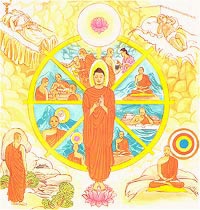 |
Verse 273. The Eight-fold Path Is Best
Explanation: Off all paths, the eight-fold path is the greatest. |
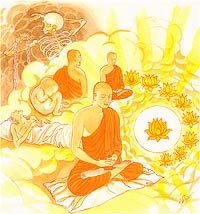 |
Verse 274. The Only Path To Purity
Explanation: This is the path. There is no other for the achievement |
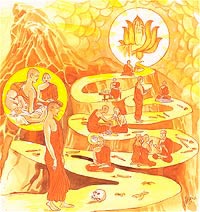 |
Verse 275. The Path To End Suffering
Explanation: If you follow this path, you will reach the termination |
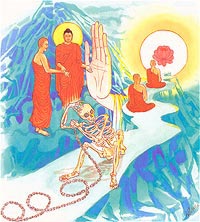 |
Verse 276. Buddhas Only Shows The Way
Explanation: The effort must be made by yourself. The Buddhas |
Dhammapada Verses 273, 274, 275 and 276
Pancasatabhikkhu VatthuMagganatthangiko1 settho
saccanam caturo pada2
virago settho dhammanam3
dvipadananca cakkhuma.Eseva maggo natthanno
dassanassa visuddhiya
etanhi tumhe patipajjatha
marassetam pamohanam.Etanhi tumhe patipanna
dukkhassantam karissatha
akkhato vo rnaya maggo
annaya sallakantanam.Tumhehi kiccamatappam
akkhataro tathagata
patipanna pamokkhanti
jhayino marabandhana.Verse 273: Of paths, the Path of Eight Constituents is the noblest; of
truths, the Four Noble Truths are the noblest; of the dhammas, the absence of
craving (i.e., Nibbana) is the noblest; of the two-legged beings, the All-Seeing
Buddha is the noblest.Verse 274: This is the only Path, and there is none other for the purity of
vision. Follow this Path; it will bewilder Mara.Verse 275: Following this Path, you will make an end of dukkha. Having myself
known the Path which can lead to the removal of the thorns of moral defilements,
I have shown you the Path.Verse 276: You yourselves should make the effort; the Tathagatas (Buddhas)
only can show the way. Those who practise the Tranquillity and Insight
Meditation are freed from the bond of Mara.
1. atthangiko: Ariya Atthangika Magga, or the Noble Path of Eight
Constituents. This is the Path pointed out by the Buddha for liberation from the
round of existences. The Eight Constituents are: right view, right thinking,
right speech, right action, right living, right effort, right mindfulness and
right concentration.2. caturo pada: Cattari Ariyasaccani, or the Four Noble Truths. These are the
four Truths upon which the whole doctrine of the Buddha is based. They are: (a)
the Noble Truth of Dukkha; (b) the Noble Truth of the Cause of Dukkha, i.e.,
craving; (c) the Noble Truth of the Cessation of Dukkha; and (d) the Noble Truth
of the Path leading to the Cessation of Dukkha. (N.B. Dukkha, in this context,
means the five aggregates of attachment or Pancupadanakkhandha).3. dhamma: both conditioned and unconditioned things.
The Story of Five Hundred Bhikkhus
While residing at the Jetavana monastery, the Buddha uttered Verses (273) to
(276) of this book, with reference to five hundred bhikkhus.Five hundred bhikkhus, after accompanying the Buddha to a village, returned
to the Jetavana monastery. In the evening they talked about the trip, especially
the nature of the land, whether it was level or hilly, clayey or stony, etc. The
Buddha came to them in the midst of their conversation and said to them, “Bhikkhus,
the path you are talking about is external to you; a bhikkhu should only be
concerned with the path of the Noble Ones (ariyas) and strive to do what should
be done for the attainment of the Ariya Path (Magga) that leads to the
realization of the Perfect Peace (Nibbana).”Then the Buddha spoke in verse as follows:
Verse 273: Of paths, the Path of Eight
Constituents is the noblest; of truths, the Four Noble Truths are the
noblest; of the dhammas, the absence of craving (i.e., Nibbana) is the
noblest; of the two-legged beings, the All-Seeing Buddha is the
noblest.Verse 274: This is the only Path, and there is
none other for the purity of vision. Follow this Path; it will
bewilder Mara.Verse 275: Following this Path, you will make an
end of dukkha. Having myself known the Path which can lead to the
removal of the thorns of moral defilements, I have shown you the Path.Verse 276: You yourselves should make the effort;
the Tathagatas (Buddhas) only can show the way. Those who practise the
Tranquillity and Insight Meditation are freed from the bond of Mara.
At the end of the discourse those five hundred bhikkhus attained arahatship.
Texas
Wat Buddhavas Buddhist temple in Houston, Texas
http://en.wikipedia.org/wiki/Wat_Buddhavas
| This article does not cite any references or sources. (June 2010) |
| Wat Buddhavas | |
|---|---|
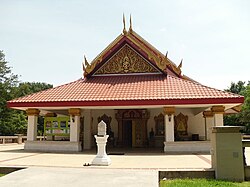 |
|
| Information | |
| Denomination | Theravada |
| Founded | April 5, 1982 |
| Founder(s) | Phra Promwachirayana |
| Teacher(s) | Manasnit Klinkul, Suwajee Munjeen, Patthanan Apiwitkullatat |
| Director(s) | Phrachan Kumchan |
| Abbot(s) | Most Venerable Sunthorn (Ajahn Prachan Kamchan) |
| Reverend(s) | Phra Ajahn Ken Kamalo |
| Address | 6007 Spindle Dr., Houston, TX 77086-3930 |
| Country | United States |
| Website | [1] |
Wat Buddhavas is a Buddhist Temple located on Spindle Dr. at Antoine Rd. in Houston, Texas.
• Chua Buu Mon, Port Arthur
http://en.wikipedia.org/wiki/Chua_Buu_Mon
| Chua Buu Mon | |
|---|---|
 |
|
| The main shrine hall | |
| Information | |
| Denomination | Theravada |
| Founded | August 15, 1987 |
| Abbot(s) | Most Venerable Huyen Viet |
| Reverend(s) | Rev. Bui Thanh Nhan (Thich Tri Quang), Bhante Kassapa Bhikkhu |
| Address | 2701 Proctor Street, Port Arthur, TX 77640 |
| Country | United States |
| Website | www.buumon.org/ |
Chua Buu Mon is a Buddhist Temple located on Proctor Street in Port Arthur, Texas.
• Chua Linh-Son Buddhist Temple, Austin
http://en.wikipedia.org/wiki/Chua_Linh-Son_Buddhist_Temple
| Chua Linh-Son | |
|---|---|
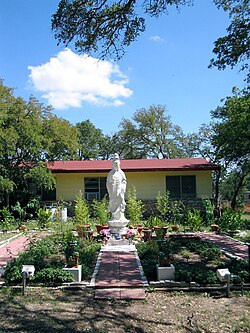 |
|
| Information | |
| Denomination | Theravada |
| Founded | 1998 |
| Abbot(s) | Venerable Thich Tri-Hue |
| Reverend(s) | Thich Hue-Minh |
| Address | 4604 Duval Rd., Austin, TX 78727 |
| Country | United States |
| Website | [2] |
Chua Linh-Son is a Buddhist Temple, located on 4604 Duval Rd. Austin, Texas.
• Maria Kannon Zen Center, Dallas
http://en.wikipedia.org/wiki/Maria_Kannon_Zen_Center
| Maria Kannon Zen Center | |
|---|---|
 |
|
| Ruben Habito, guiding teacher | |
| Information | |
| Denomination | Sanbo Kyodan |
| Founded | 1991 |
| Teacher(s) | Ruben Habito Valerie Pettys Helen Cortes |
| Address | 6532 Hunnicut Rd, Dallas, TX 75227 |
| Country | United States |
| Website | http://www.mkzc.org/ |
Maria Kannon Zen Center (MKZC) is a non-profit practice center in the Sanbo Kyodan tradition of Zen Buddhism, located in Dallas, Texas and founded in 1991 by the guiding teacher Ruben Habito (a Dharma heir of Yamada Koun).[1] MKZC derives its name by combining the names of the Virgin Mary of Christianity and Kannon bodhisattva of Buddhism. It is actually the name of a figurine revered in Japan during Christian persecution there.[2] Many of the MKZC members are individuals who consider themselves Christian, with Habito himself being a practicing Catholic and former Jesuit priest.[3] MKZC is listed with the American Zen Teachers Association.[1]
• Wat Buddhavas of Houston, Houston
http://en.wikipedia.org/wiki/Wat_Buddhavas_of_Houston
| This article does not cite any references or sources. (June 2010) |
| Wat Buddhavas | |
|---|---|
 |
|
| Information | |
| Denomination | Theravada |
| Founded | April 5, 1982 |
| Founder(s) | Phra Promwachirayana |
| Teacher(s) | Manasnit Klinkul, Suwajee Munjeen, Patthanan Apiwitkullatat |
| Director(s) | Phrachan Kumchan |
| Abbot(s) | Most Venerable Sunthorn (Ajahn Prachan Kamchan) |
| Reverend(s) | Phra Ajahn Ken Kamalo |
| Address | 6007 Spindle Dr., Houston, TX 77086-3930 |
| Country | United States |
| Website | [1] |
Wat Buddhavas is a Buddhist Temple located on Spindle Dr. at Antoine Rd. in Houston, Texas.
• Wat Buddhananachat of Austin, Del Valle
http://en.wikipedia.org/wiki/Wat_Buddhananachat_of_Austin
|
|
This article needs additional citations for verification. (May 2011) |
| Wat Buddhananachat | |
|---|---|
 |
|
| Information | |
| Denomination | Theravada |
| Founded | April, 1986 |
| Founder(s) | Ven. Phramaha Thewa Pribueng |
| Teacher(s) | Ven. Phra Somchay Mali |
| Director(s) | Mr. Sydney Ouk (President/Treasurer) |
| Abbot(s) | Most Ven. Phramaha Bancha Temprom |
| Reverend(s) | Ven. Phra Raem Poonnongwaeng |
| Address | 8105 Linden Rd., Del Valle, TX 78617 |
| Country | United States |
| Website | [1] |
Wat Buddhananachat is a Buddhist Temple located about 20 miles southeast of Downtown, on Linden Rd. in Del Valle, Texas.
This Buddhist temple was established in April, 1986 (in corporated on
August 4, 1986) as a nonprofit organization to serve as a center for
religious and cultural activities for Theravadic Buddhist belonging to
different ethnic communities in central Texas.
[24]
| O |
The king’s gardener thought to himself:
“All my friends are having a holiday in the city.
I could go into the city and enjoy myself with them
if I did not have to water the trees here in this garden.
I know what I will do. I will get the Monkeys to water
the young trees for me.” In those days,
a tribe of Monkeys lived in the king’s garden.
So the gardener went to the Chief of the Monkeys,
and said: “You are lucky Monkeys
to be living in the king’s garden.
You have a fine place to play in.
You have the best of food—nuts, fruit,
and the young shoots of trees to eat.
You have no work at all to do. You can play all day,
every day. To-day my friends are having a holiday in the city,
and I want to enjoy myself with them.
Will you water the young trees so that I can go away?”
“Oh, yes!” said the Chief of the Monkeys.
“We shall be glad to do that.”
[25] “Do not forget to water the trees when the sun goes down.
See they have plenty of water, but not too much,”
said the gardener. Then he showed them
where the watering-pots were kept, and went away.
![[Illustration]](http://www.mainlesson.com/books/babbitt/morejataka/zpage025.gif)
When the sun went down the Monkeys took the watering-pots,
and began to water the young trees.
“See that each tree has enough water,”
said the Chief of the Monkeys.
“How shall we know when each tree has enough?”
they asked. The Chief of the Monkeys had no good answer,
so
[26] he said: “Pull up each young tree
and look at the length of its roots.
Give a great deal of water to those with long roots,
but only a little to those trees that have short roots.”
Then those stupid Monkeys pulled up all the young trees
to see which trees had long roots and which had short roots.
When the gardener came back the next day,
the poor young trees were all dead.
http://www.texasoutside.com/texas-kids-activities/index.html
Texas Outside has lots of things for you to see
and do, so this page is dedicated to fun activities and things to do for
kids. Our children have enjoyed a lot of these adventures like kids day
or summer camps, mazes, bike trails, museums, water parks, amusement
rides, miniature golf, bumper cars, kids museums, or just a day in the
park grilling dogs, tossing balls, or fishing. Below are our
recommendations on some things to do with your kids in Texas - all are
great family activities.
 |
Everybody loves Shamu at Sea World and What kid doesn’t love a roller coaster, cotton |
 |
Texas has over 125 lakes spread |
 |
Texas is riddled with thousands of caves. |
 |
Get a REAL tree on a REAL farm at Devine |
 |
Once in their lifetime, you need to take |
 |
You will find games of |
Horseback Riding
 |
Need someplace the kids can go for an |
 |
If you’re looking for something fun and Most of the mazes have other activities and fun things |
 |
There is no limit to what your children |
| Meet the baby animals from a kangaroos to pigs, create a scarecrow, paint a pumpkin, ride a hayride or train or just pick out that perfect pumpkin for carving or eating. Whatever your day in the pumpkin patch brings it will be great entertainment for the entire family and an opportunity for awesome fall pictures. |
 |
What is better than fun, sun and |
 |
The magic of the train comes to life |
 |
It just doesn’t get much better than a |
 |
On a hot Texas summer day, it just |
 |
An exciting safari adventure filled with |
 |
Multiple Texas Locations |
For a thrilling adventure for kids over |
 |
It doesn’t get much better than taking |
| Texas Parks and Wildlife | Check out this website for some great ideas for outdoor and indoor craft activities and at the same time learn a little history of Texas, safety outdoors, animals & flower facts and much more. |
| Ways to make personal contact with living things by touch, feel, and smell to develop a relationship with the outdoors. |
Dhammapada Verse 271and 272 Sambahulasiladisampannabhikkhu Vatthu-Verse 271. A Monk Should Destroy All Passions-Verse 272. Blemishes Should Be Given Up To Reach Release
Rhode Island
• Providence Zen Center
VOICE OF SARVAJAN
Sarvajan Samaj urged the
Governor to recommend President’s rule for establishing peace and rule
of law in the state in view of the prevailing “jungle” and “goondaraj”.
Demanded a judicial and high-level inquiry into the
incident so that the conspirators and those giving them shelter could be
exposed.
Stern action should be initiated against the culprits under the SC/ST act and NSA.
Demands adequate security as was extended earlier at all the memorials
and museums in Lucknow, Gautambudhnagar and Noida the Sarvajan Samaj said
the incident had raised questions about the rule of law.
Those responsible for the incident had fled from
the scene after damaging the statue and have not been arrested so far.
This incident not only proves the traditional incompetence, immature, inefficient, ineffective, hateful, venomous, angry, mad bulldozing mentality of the government but
also indicates the impunity of unruly elements in the state. As an appropriate prize a new marble statue of the size of Liberty Statue should be erected in its place at the
earliest for the Living Buddhist Deity Ms. Maha Mayawati.
The Government must build Mental Hospitals to lodge these bulldozers who become mad out of hatred and anger after seeing an untouchable. That includes Amit Agrawal alias Amit Gupta alias Amit Jani, 32, the founder of Uttar Rajya Navnirman Sena (URNS) who has said that the members of his organisation will continue vandalising the statues of Mayawati in the state. Are, now scared by the
seriousness of the incident, Shivam Verma and his family members, who
live in the house on rent, a
house owned by Amit in Shiv Shakti Nagar of Meerut. shifted elsewhere in the night.
Some relatives of Amit who live in Kankarkheda area of Meerut also
locked their houses and escaped from there. His two houses in Meerut
city were also found locked from outside.
On the other hand, alert SP workers removed the banners of party
president Mulayam Singh Yadav and Chief Minister Akhilesh Yadav from the
walls of Amit’s office in Street No 10 of Bungalow Area in Meerut
within a few hours of Mayawati’s statue being vandalised in Lucknow.
The
photographs of other SP leaders with Amit, which were seen on his
Facebook page on Thursday, were also not there on Friday.
But Sanjay Yadav, a SP member and a friend of Amit, silently uploaded
the photograph of the beheaded statue of Mayawati on his Facebook page
on Thursday night to
claim that “the state government was behind the incident”.
People in Meerut also
know him as a fan of Gujarat Chief Minister Narendra Modi.
Sarvajan Samaj now calls URNS as Urinating Rotten Newnaked Stupids.
Some of the Views Papers are joining hands with URNS and glorify them with out knowing the pain of Sarvjan Samaj in general and the untouchables in particular. And mention the Living Buddhist Deity as Low Caste. They must stop this.
In the memorandum submitted by the BSP delegation led by Leaders of
Opposition in Legislative Council and Legislative Assembly Swami Prasad
Maurya and Naseemuddin Siddiqui respectively, the party urged the
Governor to recommend President’s rule for establishing peace and rule
of law in the state in view of the prevailing “jungle” and “goondaraj”.
The delegation also demanded a judicial and high-level inquiry into the
incident so that the conspirators and those giving them shelter could be
exposed.
They also said that stern action should be initiated against the culprits under the SC/ST act and NSA.
Demanding adequate security as was extended earlier at all the memorials
and museums in Lucknow, Gautambudhnagar and Noida the delegation said
the incident had raised questions about the rule of law.
They also alleged that those responsible for the incident had fled from
the scene after damaging the statue and have not been arrested so far.
This incident not only proves the incompetence of the government but
also indicates the impunity of unruly elements in the state, they said,
adding a new marble statue should be erected in its place at the
earliest.
The new state president of the BSP, Ram Achal Rajbhar was also among those who met the Governor.
The statue was located in the famous Ambedkar Park in Gomti Nagar.
Police sources said the incident took place at around 1.40 pm when yet
to be identified six men on bikes came to the park with hammers and
damaged the white marble statue of Mayawati.
As per reports, BSP leaders are discussing the matter with the party chief to chart out the future course of action.
BSP leader Vijay Bahadur Singh demanded an inquiry into the incident and action against the guilty.
He said the incident may have far reaching consequences.
Senior BSP leader Swami Prasad Maurya questioned the Samajwadi Party’s
role in the incident and demanded the government replace the damaged
statue with a new one.
Meanwhile, three persons have been detained, police said. The incident
led to protests by BSP workers at a number of places in the state,
including Jhansi, Ambedkar Nagar, Deoria, Muzaffarnagar and Kanpur.
A little known political outfit Uttar Pradesh Nav Nirman Sena claimed
responsibility for the incident.
He said that three persons, including organisers of the press conference of Sena have been detained and interrogated.
“Three persons, including Alok Srivastava, his son Arpit Srivastava and
an executive of a PR agency, Vishal Mishra, have been taken into
custody,” Sharma said, adding that an FIR has been lodged.
He said that information has been received regarding the organisation and it’s office-bearers and they would be arrested soon.
“Sena’s state president Amit Jaani hails from Meerut and has seven
criminal cases against him, including two attempt to murder cases,” he
said.
The DGP said that an inquiry was also being conducted into intelligence failure.
Lucknow : The Uttar Pradesh government was Friday hurriedly restoring
a life-sized statue of former chief minister Mayawati to replace the
one vandalised the day before.
A replica of the marble statue of the Bahujan Samaj Party (BSP) chief
was found at the Sangeet Natak Academy (SNA) in Gomtinagar late
Thursday and the administration got down to restoring it at 1.30 a.m.
itself.
District officials said they found an exact replica of the statue
broken Thursday. But the work would be completed only by Friday noon, an
official told IANS.
District Magistrate Anurag Yadav said restoration work had been taken
up and the sculptor, Sharawan Prajapati, had been requisitioned.
No time was wasted. Cranes were pressed into service midnight to lift
the defunct statue, which was to be initially used at the Manyavar
Kanshiram Eco garden on Jail Road. It was not done due to a stay by the
Supreme Court.
The new statue is of the same height and weighs 750 kg. The
restoration work has saved the district administration around Rs.15
lakh, an official said.
When Prajapati inspected the broken statue he told officials that it
was impossible to repair it because of the extent of damage inflicted on
it.
He said the statue was of very high grade marble and hence would have to be done all over again.
Detailing the events, an official said the government was informed of
the dilemma following which a hunt was ordered for a replica that was
luckily found a few kilometres away.
Four unidentified vandals Thursday afternoon damaged the statue,
which was placed in the sprawling Ambedkar Park. It was damaged in the
head, arm and neck.
Protests erupted in many parts of the state following the
desecration, including in Muzaffarnagar, Jhansi and Ambedkarnagar, with
BSP supporters and workers taking to the streets and raising anti-SP
slogans.
BSP leaders Naseemuddin Siddiqui, Swamy Prasad Maurya, Daddu Prasad
and Nakul Dubey led the protest in Lucknow. They staged a sit-in in
front of the Vidhan Sabha and demanded the immediate restoration of the
statue.
Lucknow, July 27 — A hammer blow on a statue of former Uttar Pradesh
chief minister Mayawati has not only boosted her stocks but also
brought the ruling Samajwadi Party (SP) to its knees and shown up the
inexperience of Chief Minister Akhilesh Yadav.
The government
raced to restore the statue within 24 hours of it being vandalised much
to the delight of the Bahujan Samaj Party (BSP).
Gleeful BSP
workers said it was the “power of their living Buddhist Deity behenji” that the
government, in a late night knee-jerk reaction, fished out a similar
Mayawati statue lying dumped at the Sangeet Natak Academy (SNA) and got
it scrubbed, polished and restored.
To make things worse for the
four-month-old Akhilesh Yadav government, police have been asked to
protect her statues 24×7 and to ensure that no repeat of the Thursday
incident takes place, said informed sources.
This missive from the
home department has taken the cops by surprise as the same government
was not so long ago speaking of bulldozing the statues and turning
memorials built by the Scheduled Caste (Untouchable) Diva into hospitals.
Political
observers feel that the inexperience and immaturity of the chief
minister Akhilesh Yadav, 38, has left the party red-faced as it is now
faced with the task of defending the decision to bring back the statue
of the BSP supremo.
Now officials in SP government are working
overtime, burning the midnight oil to restore the statue of one of the
most Liked Living Buddhist Deity in the country.
The
incident has highlighted the awe the former chief minister still evokes
in her political adversaries and the babudom. This is highlighted by
the fact that the first information report (FIR) slapped against the
miscreants likens Mayawati to a living Buddhist Deity as section 295 is meant for
people “damaging place of worship or an object/place considered to be
sacred for a section of the society”.
Other than this, the
government now has the onerous task of protecting 10 other statues of
Mayawati - four marble and six bronze, all over eight feet height, and
also of all other SC/ST/OBC icons that she placed during her five year
tenure (2007-12).
Other than this, there are figurines, huge and small of the party’s symbol elephant.
This
will be humbling for the government which had immediately after its
swearing in slashed 450 Home Guards from duty at the SC/ST/OBC memorials.
“There has been no cut in the number… everything is in place as it was
in the predecessor government,” said a defensive principal secretary
(Home) R.M. Srivastava.
This sutta is widely considered as a the main reference for meditation practice.
|
|
|
(1) Puna ca·paraṃ, bhikkhave, bhikkhu seyyathāpi passeyya sarīraṃ sivathikāya chaḍḍitaṃ ekāha·mataṃ vā dvīha·mataṃ vā tīha·mataṃ vā uddhumātakaṃ vinīlakaṃ vipubbaka·jātaṃ, so imam·eva kāyaṃ upasaṃharati: ‘ayaṃ pi kho kāyo evaṃ·dhammo evaṃ·bhāvī evaṃ·an·atīto’ ti. |
(1)
|
|
Iti ajjhattaṃ vā kāye kāyānupassī viharati, bahiddhā vā kāye kāyānupassī viharati, ajjhatta-bahiddhā vā kāye kāyānupassī viharati; samudaya-dhamm·ānupassī vā kāyasmiṃ viharati, vaya-dhamm·ānupassī vā kāyasmiṃ viharati, samudaya-vaya-dhamm·ānupassī vā kāyasmiṃ viharati; ‘atthi kāyo’ ti vā pan·assa sati paccupaṭṭhitā hoti, yāvadeva ñāṇa·mattāya paṭissati·mattāya, a·nissito ca viharati, na ca kiñci loke upādiyati. Evam·pi kho, bhikkhave, bhikkhu kāye kāyānupassī viharati. |
|
மேலும், பிக்குக்களுக்களே, ஒரு பிக்கு, ஒருவேளை அவர் தொலைவான இடத்தில் ஒரு பிரேதம் இடுகாடு நிலத்தளத்தில் எறியப்பட்டு இருப்பதைப் பார்த்துக் கொண்டிருஇந்தால், ஒரு நாள் இறந்த, அல்லது இரண்டு நாட்கள் இறந்த, அல்லது மூன்று நாட்கள் இறந்த, வீங்கிய, சற்றே நீலமான மற்றும் புரைத்துச் சீக்கொண்ட நிலையில், அவர் இந்த மெய்ம்மூலமான kāya உடல்/காய ஆழ்ந்து ஆராய: “இந்த kāya உடல்/காய கூட அவ்வகைப்பட்ட ஒரு இயற்கை ஆற்றல் உடையதாக இருக்கிறது, அதுவும் இப்படி ஆகத்தொடங்கு போக இருக்கிறது, மற்றும் அத்தகைய ஒரு கட்டுப்பாட்டு வரம்புகளற்ற நிலைமை இருந்து வேறல்ல.
இவ்வாறு அவர் kāya in kāya உடல்/காயத்தை காயதுக்குள் கண்காணி வாசம் செய்கிரார், அல்லது காயத்தை காயதுக்கு வெளியே கண்காணி வாசம் செய்கிரார், அல்லது காயத்தை காயதுக்கு உள்ளே மற்றும் வெளியே கண்காணி வாசம் செய்கிரார்;புலன்களால் உணரத்தக்க எழுச்சி கண்காணி வாசம் செய்கிரார், மற்றும் புலன்களால் உணரத்தக்கதை கடந்துசெல்லுவதை கண்காணித்து வாசம் செய்கிரார்; இல்லாவிடில் எச்சரிக்கையாயிருக்கிற உணர் உடனிருக்கிறதை,சும்மா வெறும் ஓர்அளவு ஞானம் மற்றும் ஓர்அளவு paṭissati என எண்ணி பற்றறு வாசம் செய்கிரார்.
| (2) Puna ca·paraṃ, bhikkhave, bhikkhu seyyathāpi passeyya sarīraṃ sivathikāya chaḍḍitaṃ kākehi vā khajjamānaṃ kulalehi vā khajjamānaṃ gijjhehi vā khajjamānaṃ kaṅkehi vā khajjamānaṃ sunakhehi vā khajjamānaṃ byagghehi vā khajjamānaṃ dīpīhi vā khajjamānaṃ siṅgālehi vā khajjamānaṃ vividhehi vā pāṇaka·jātehi khajjamānaṃ, so imam·eva kāyaṃ upasaṃharati: ‘ayaṃ pi kho kāyo evaṃ·dhammo evaṃ·bhāvī evaṃ·an·atīto’ ti. |
(2)
|
|
Iti ajjhattaṃ vā kāye kāyānupassī viharati, bahiddhā vā kāye kāyānupassī viharati, ajjhatta-bahiddhā vā kāye kāyānupassī viharati; samudaya-dhamm·ānupassī vā kāyasmiṃ viharati, vaya-dhamm·ānupassī vā kāyasmiṃ viharati, samudaya-vaya-dhamm·ānupassī vā kāyasmiṃ viharati; ‘atthi kāyo’ ti vā pan·assa sati paccupaṭṭhitā hoti, yāvadeva ñāṇa·mattāya paṭissati·mattāya, a·nissito ca viharati, na ca kiñci loke upādiyati. Evam·pi kho, bhikkhave, bhikkhu kāye kāyānupassī viharati. |
|
இவ்வாறு அவர் kāya in kāya உடல்/காயத்தை காயதுக்குள் கண்காணி வாசம் செய்கிரார், அல்லது காயத்தை காயதுக்கு வெளியே கண்காணி வாசம் செய்கிரார், அல்லது காயத்தை காயதுக்கு உள்ளே மற்றும் வெளியே கண்காணி வாசம் செய்கிரார்;புலன்களால் உணரத்தக்க எழுச்சி கண்காணி வாசம் செய்கிரார், மற்றும் புலன்களால் உணரத்தக்கதை கடந்துசெல்லுவதை கண்காணித்து வாசம் செய்கிரார்; இல்லாவிடில் எச்சரிக்கையாயிருக்கிற உணர் உடனிருக்கிறதை,சும்மா வெறும் ஓர்அளவு ஞானம் மற்றும் ஓர்அளவு paṭissati என எண்ணி பற்றறு வாசம் செய்கிரார்.
| (3) Puna ca·paraṃ, bhikkhave, bhikkhu seyyathāpi passeyya sarīraṃ sivathikāya chaḍḍitaṃ aṭṭhika·saṅkhalikaṃ sa·maṃsa·lohitaṃ nhāru·sambandhaṃ, so imam·eva kāyaṃ upasaṃharati: ‘ayaṃ pi kho kāyo evaṃ·dhammo evaṃ·bhāvī evaṃ·an·atīto’ ti. |
(3)
|
|
Iti ajjhattaṃ vā kāye kāyānupassī viharati, bahiddhā vā kāye kāyānupassī viharati, ajjhatta-bahiddhā vā kāye kāyānupassī viharati; samudaya-dhamm·ānupassī vā kāyasmiṃ viharati, vaya-dhamm·ānupassī vā kāyasmiṃ viharati, samudaya-vaya-dhamm·ānupassī vā kāyasmiṃ viharati; ‘atthi kāyo’ ti vā pan·assa sati paccupaṭṭhitā hoti, yāvadeva ñāṇa·mattāya paṭissati·mattāya, a·nissito ca viharati, na ca kiñci loke upādiyati. Evam·pi kho, bhikkhave, bhikkhu kāye kāyānupassī viharati. |
|
இவ்வாறு அவர் kāya in kāya உடல்/காயத்தை காயதுக்குள் கண்காணி வாசம் செய்கிரார், அல்லது காயத்தை காயதுக்கு வெளியே கண்காணி வாசம் செய்கிரார், அல்லது காயத்தை காயதுக்கு உள்ளே மற்றும் வெளியே கண்காணி வாசம் செய்கிரார்;புலன்களால் உணரத்தக்க எழுச்சி கண்காணி வாசம் செய்கிரார், மற்றும் புலன்களால் உணரத்தக்கதை கடந்துசெல்லுவதை கண்காணித்து வாசம் செய்கிரார்; இல்லாவிடில் எச்சரிக்கையாயிருக்கிற உணர் உடனிருக்கிறதை,சும்மா வெறும் ஓர்அளவு ஞானம் மற்றும் ஓர்அளவு paṭissati என எண்ணி பற்றறு வாசம் செய்கிரார்.
 |
Verse 271. A Monk Should Destroy All Passions
Explanation: These two stanzas are an admonition to the monks |
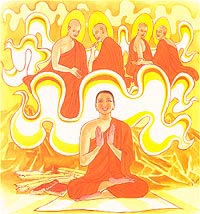 |
Verse 272. Blemishes Should Be Given Up To Reach Release
Explanation: Monks, do not rest content by precepts and rites. |
Dhammapada Verses 271 and 272
Sambahulasiladisampannabhikkhu VatthuNa silabbatamattena
bahusaccena va pana
atha va samadhilabhena
vivittasayanena va.Phusami nekkhammasukham1
aputhujjanasevitam
bhikkhu vissasamapadi
appatto asavakkhayam.Verses 271 & 272: Not only by mere moral practice, nor by much learning,
nor by acquiring concentration, nor by dwelling in seclusion, nor by assuring
oneself, “I enjoy the bliss of Anagami Fruition that is not enjoyed by
common worldlings (puthujjanas),” should the bhikkhu, rest content without
attaining the extinction of moral intoxicants (asavas) [i.e., without attaining
arahatship].
1. nekkhammasukham: In this context, Anagamisukham. i.e., Anagami Fruition,
the fruition that follows the attainment ot Anagami Magga.
The Story of Some Bhikkhus
While residing at the Jetavana monastery, the Buddha uttered Verses (271) and
(272) of this book, with reference to some bhikkhus.Once, there were some bhikkhus who were endowed with virtue; some of them had
strictly observed the austere practices (dhutanga), some had wide knowledge of’
the Dhamma, some had achieved mental absorption (jhana), some had achieved
Anagami Phala, etc. All of them thought that since they had achieved that much,
it would be quite easy for them to attain Arahatta Phala. With this thought they
went to the Buddha.The Buddha asked them, “Bhikkhus, have you attained Arahatta
Phala?” Then they replied that they were in such a condition that it
would not be difficult for them to attain Arahatta Phala at any time. To them
the Buddha said, “Bhikkhus! Just because you are endowed with morality
(sila), just because you have attained Anagami Phala, you should not be
complacent and think that there is just a little more to be done; unless you
have eradicated all moral intoxicants (asavas), you must not think that you have
realized perfect bliss of Arahatta Fruition.“Then the Buddha spoke in verse as follows:
Verses 271 & 272: Not only by mere moral practice,
nor by much learning, nor by acquiring concentration, nor by dwelling
in seclusion, nor by assuring oneself, “I enjoy the bliss of
Anagami Fruition that is not enjoyed by common worldlings
(puthujjanas),” should the bhikkhu, rest content without
attaining the extinction of moral intoxicants (asavas) [i.e., without
attaining arahatship].
At the end of the discourse all those bhikkhus attained arahatship.
End of Chapter Nineteen: The Just or the Righteous
Rhode Island
• Providence Zen Center
http://en.wikipedia.org/wiki/Providence_Zen_Center
| Providence Zen Center | |
|---|---|
 |
|
| Information | |
| Denomination | Kwan Um School of Zen |
| Founded | 1972 |
| Founder(s) | Seung Sahn |
| Teacher(s) | Dae Kwang |
| Abbot(s) | Jiri Hazlbauer |
| Address | 99 Pound Road Cumberland, RI 02864 |
| Country | United States |
| Website | www.providencezen.org/ |
Providence Zen Center (PZC) is the international headquarters for the Kwan Um School of Zen (KUSZ) and the first Zen center established by Seung Sahn in the United States
in October 1972. The PZC offers residential training where students and
teachers live together under one roof, which was one of the hallmarks
of Seung Sahn’s philosophy concerning Zen practice in his organization.
While the PZC is primarily a residential training site, the center also
offers retreats to the non-ordained—such as their Yong Maeng Jon Jin.
Practice at the center, and at Diamond Hill Zen Monastery, which shares the PZC property, includes sitting meditation, prostrations, and chanting.
The Providence Zen Center was originally located in Providence, Rhode Island, but in 1979 the center relocated to its current 50 acre site in Cumberland. One of the center’s centerpiece landmarks is the Peace Pagoda, a towering 65-foot (20 m) high pagoda located at the front of the center grounds.[1] PZC also serves as the U.S. headquarters for the Jogye Order of Korean Buddhism.
The Providence Zen Center was established by Seung Sahn in October 1972 on Doyle Avenue in Providence, Rhode Island as the first practice center for his American students. The center came to be after Brown University professor Leo Pruden had invited Seung Sahn to give talks on Buddhism at the university, with several of the students thereafter coming to him for teachings.[1] After relocating in 1974 to 48 Hope Street, the PZC came into possession of a 50-acre (200,000 m2) plot of land in 1978 located in Cumberland, Rhode Island.[2]
During the 1980s the PZC became a catalyst for opening the dialogue on the role of women in Zen Buddhism, becoming host to various discussion panels and conferences on feminist
issues in the years to follow. In 1982 the center organized a
discussion group for woman at the center. Then in 1983 the PZC offered a
workshop called “Feminist Principles in Zen,” led by Barbara Rhodes, Maurine Stuart,
Jacqueline Schwartz and Susan Murcott. In 1984 and 1985 the center held
“Women in American Buddhism” conferences and, according to the book The Encyclopedia of Women and Religion in North America, “[f]rom then on women’s retreats and conferences became common.”[3]
From 1983—1984 the Kwan Um School of Zen constructed Diamond Hill Zen Monastery on the grounds of PZC, a “low, pagoda shaped building” built in the “traditional Korean-style [of] architecture”,[2] which today hosts their semi-annual Kyol Che retreats.[4] Originally designed as a training ground for those who were ordained, Seung Sahn
expressed little interest in the training there. According to a
longtime student of the Kwan Um School Mu Soeng, “[Seung Sahn] did not
even insist that all his ordained American students make the monastery
their home and contribute to its growth as a monastic center. To this
day, the Diamond Hill Zen Monastery remains a minor footnote to Seung
Sahn’s missionary activities in America.”[5]
Grave of Hyon Jok at Providence Zen Center in Cumberland, RI
[21]
| O |
![[Illustration]](http://www.mainlesson.com/books/babbitt/morejataka/zpage022.gif)
“If I give them one after another of my golden feathers,
the mother can sell them, and with the money they bring
she and her daughters can then live in comfort.”
So away the Goose flew to the poor woman’s house.
Seeing the Goose, the woman said: “Why do you come here?
We have nothing to give you.”
“But I have something to give you,” said the Goose.
“I will give my feathers, one by one, and you can sell them
for enough so that you and your daughters can live in comfort.”
So saying the Goose gave her one of his feathers,
and then flew away. From time to time he came back,
each time leaving another feather.
[22] The mother and her daughters sold the beautiful feathers
for enough money to keep them in comfort.
But one day the mother said to her daughters:
“Let us not trust this Goose. Some day he may fly away
and never come back.
Then we should be poor again. Let us get all of his feathers
the very next time he comes.”
The daughters said: “This will hurt the Goose. We will not do such a thing.”
But the mother was greedy. The next time the Golden
[23] Goose
came she took hold of him with both hands, and pulled out every one of his feathers.
![[Illustration]](http://www.mainlesson.com/books/babbitt/morejataka/zpage023.gif)
Now the Golden Goose has strange feathers. If his feathers are plucked out
against his wish, they no longer remain golden
but turn white and are of no more value than chicken-feathers.
The new ones that come in are not golden, but plain white.
As time went on his feathers grew again, and then he flew away to his home
and never came back again.
http://en.wikipedia.org/wiki/The_Kids_Are_All_Right_%28film%29
| The Kids Are All Right | |
|---|---|
 Theatrical release poster |
|
| Directed by | Lisa Cholodenko |
| Produced by | Jeff Levy-Hinte Gary Gilbert Jordan Horowitz Celine Rattray Daniela Taplin Lundberg Philippe Hellmann |
| Written by | Lisa Cholodenko Stuart Blumberg |
| Starring | Annette Bening Julianne Moore Mark Ruffalo Mia Wasikowska Josh Hutcherson Yaya DaCosta |
| Music by | Carter Burwell Nathan Larson Craig Wedren |
| Cinematography | Igor Jadue-Lillo |
| Editing by | Jeffrey M. Werner |
| Distributed by | Alliance Films Focus Features |
| Release date(s) |
|
| Running time | 107 minutes |
| Country | United States |
| Language | English |
| Budget | $4 million[1] |
| Box office | $34,705,850[2] |
The Kids Are All Right is a 2010 American comedy-drama film directed by Lisa Cholodenko and written by Cholodenko and Stuart Blumberg. One of Sundance 2010’s breakout hits,[3][4][5][6] it opened in limited release on July 9, 2010, expanding to more theaters on July 30, 2010.[7] It was released on DVD and Blu-ray on November 16, 2010. The film was awarded the Golden Globe Award for Best Motion Picture - Musical or Comedy, and Annette Bening was awarded the Golden Globe Award for Best Actress – Motion Picture Musical or Comedy. The film also received four Academy Award nominations, including one for Best Picture, at the 83rd Academy Awards.
Places to go in Maine with kids |
Things to do in New Hampshire
What to do in Vermont
|
Things to do in Massachusetts with kids |
Places to visit in Connecticut
What is there to do in Newport for kids
|
Things to do with kids in Pawtucket |
Things for kids to do in Warwick |
Places to visit in Middletown with kids |
Fun places for kids in Providence
Dhammapada Verse 270 Balisika Vatthu - A Monk Should Destroy All Passions

Not by vows and rituals
or again by learning much
or by meditative calm
or by life in solitude.
Explanation: These two stanzas are an admonition to the monks
making an effort to reach the state of blemishlessness - Nibbana.
They are asked not to slacken their effort to win liberation by being
content with some achievement which only pave the way to the final
goal.
Dhammapada Verse 270
Balisika VatthuNa tena ariyo hoti
yena panani himsati
ahimsa sabbapapnam
“ariyo” ti pavuccati.Verse 270: He who harms living beings is, for that reason, not an ariya (a
Noble One); he who does not harm any living being is called an ariya1.
1. ariya: one who has realized one of the four maggas.
The Story of a Fisherman Named Ariya
While residing at the Jetavana monastery, the Buddha uttered Verse (270) of
this book, with reference to a fisherman named Ariya.Once, there was a fisherman who lived near the north gate of Savatthi. One
day through his supernormal power, the Buddha found that time was ripe for the
fisherman to attain Sotapatti Fruition. So on his return from the alms-round,
the Buddha, followed by the bhikkhus, stopped near the place where Ariya was
fishing. When the fisherman saw the Buddha, he threw away his fishing gear and
came and stood near the Buddha. The Buddha then proceeded to ask the names of
his bhikkhus in the presence of the fisherman, and finally, he asked the name of
the fisherman. When the fisher man replied that his name was Ariya, the Buddha
said that the Noble Ones (ariyas) do not harm any living being, but since the
fisherman was taking the lives of fish he was not worthy of his name.Then the Buddha spoke in verse as follows:
Verse 270: He who harms living beings is, for that
reason, not an ariya (a Noble One); he who does not harm any living
being is called an ariya.
At the end of the discourse the fisherman attained Sotapatti Fruition.
Oregon
• Great Vow Zen Monastery
http://en.wikipedia.org/wiki/Great_Vow_Zen_Monastery
| Great Vow Zen Monastery | |
|---|---|
 |
|
| Information | |
| Denomination | White Plum Asanga |
| Founded | 2002 |
| Rōshi(s) | Jan Chozen Bays Hogen Bays |
| Address | P.O. Box 368, Clatskanie, Oregon 97016 |
| Country | United States |
| Website | www.greatvow.org/ |
Great Vow Zen Monastery was founded in 2002 and is operated by Zen Community of Oregon[1] (ZCO) under the leadership of abbots Chozen Bays,
Roshi, and Hogen Bays. The monastery offers weekend workshops, weeklong
meditation retreats, and special events throughout the year.
[15]
| O |
![[Illustration]](http://www.mainlesson.com/books/babbitt/morejataka/zpage016.gif)
A hunter, wandering about in the wood,
saw the foot-prints of the Deer near the edge of the lake.
“I must trap the Deer, going down into the water,”
he said, and setting a strong trap of leather, he went his way.
Early that night when the Deer went down to drink,
he was caught in the trap, and he cried the cry of capture.
At once the Woodpecker flew down from her tree-top,
and the Turtle came out of the water to see what could be done.
Said the Woodpecker to the Turtle:
“Friend, you have teeth; you gnaw through the leather trap.
I will go and see to it that the hunter keeps away.
If we both do our best our friend will not lose his life.”
[16] So the Turtle began to gnaw the leather,
and the Woodpecker flew to the hunter’s house.
At dawn the hunter came, knife in hand,
to the front door of his house.
The Woodpecker, flapping her wings, flew at the hunter
and struck him in the face.
[18] The hunter turned back into the house
and lay down for a little while. Then he rose up again,
and took his knife. He said to himself:
“When I went out by the front door,
a Bird flew in my face; now I will go out by the back door.” So he did.
![[Illustration]](http://www.mainlesson.com/books/babbitt/morejataka/zpage017.gif)
The Woodpecker thought: “The hunter went out
by the front door before, so now he will leave by the back door.”
So the Woodpecker sat in a tree near the back door.
When the hunter came out the bird flew at him again,
flapping her wings in the hunter’s face.
Then the hunter turned back and lay down again.
When the sun arose, he took his knife, and started out once more.
This time the Woodpecker flew back as fast
as she could fly to her friends, crying, “Here comes the hunter!”
By this time the Turtle had gnawed through
all the pieces of the trap but one.
The leather was so hard that it made his teeth
feel as if they would fall out.
His mouth was all covered with blood.
The Deer heard the Woodpecker, and saw the hunter,
knife in hand, coming on. With a strong pull
the Deer broke this last piece of the trap, and ran into the woods.
The Woodpecker flew up to her nest in the tree-top.
But the Turtle was so weak he could not get away.
He
[19] lay where he was. The hunter picked him up
and threw him into a bag, tying it to a tree.
The Deer saw that the Turtle was taken,
and made up his mind to save his friend’s life.
So the Deer let the hunter see him.
The hunter seized his knife and started after the Deer.
The Deer, keeping just out of his reach,
led the hunter into the forest.
When the Deer saw that they had gone far into the forest
he slipped away from the hunter, and swift as the wind,
he went by another way to where he had left the Turtle.
But the Turtle was not there. The Deer called,
“Turtle, Turtle!”; and the Turtle called out,
“Here I am in a bag hanging on this tree.”
Then the Deer lifted the bag with his horns,
and throwing it upon the ground, he tore the bag open,
and let the Turtle out.
The Woodpecker flew down from her nest,
and the Deer said to them: “You two friends saved my life,
but if we stay here talking, the hunter will find us,
and we may not get away. So do you, Friend Woodpecker,
fly away. And you, Friend Turtle, dive into the water.
I will hide in the forest.”
[20] The hunter did come back, but neither the Deer,
nor the Turtle, nor the Woodpecker was to be seen.
He found his torn bag, and picking that up he went back to his home.
The three friends lived together all the rest of their lives.

http://akirchner.hubpages.com/hub/10-Best-Kid-Friendly-Places-For-Entertainment-In-Central-Oregon



VOICE OF SARVAJAN
The party threatened “dire consequences” if the statue was not repaired speedily.The state unit of the Bahujan Samaj Party (BSP), meanwhile, threatened
the state government of dire consequences if the statue was not restored
on Thursday itself.
Members of Nav Nirman Sena
in Uttar Pradesh allegedly vandalized a statue of former chief minister
and BSP supremo Mayawati on Thursday.
Before the four sped away on motorbikes, they left a pamphlet in the
name of Uttar Pradesh Navnirman Sena, saying they had promised to break
the statue on March 15, 2012 - the day the new Samajwadi Party
government led by Akhilesh Yadav was sworn in.
Nav Nirman Sena, which has claimed responsible for the incident, has
reportedly set a 48-hour deadline for the government to remove all the
statues of SC/ST/OBC icons across the state.
According to the media reports, the NNS activists came on three or
four bikes to the Ambedkar park, vandalized the statue of Mayawati and
fled the scene after they chipped off the head and hand with hammer..
The BSP leaders commenting on this said it was unfortunate and
alleged that it’s a reflection of anti-SC/ST sentiments, said media
reports.
Mayawati, during her regime in Uttar Pradesh have installed statues
of SC/ST/OBC icons, including hers, besides setting up several parks and
memorials.
The Mayawati government continued to build memorials of SC/ST/OBC icons
in Lucknow and Noida.
It was a Mayawati’s ”dream project.”
The statue was unveiled on July 25, 2009, by then Public Works Department minister Naseemuddin Siddiqui.
Please watch Video:
http://www.hindustantimes.com/India-news/Lucknow/Mayawati-s-statue-damaged-in-Lucknow-3-held/Article1-900154.aspx
MAYAWATI
A LIVING DEITY
Police has detained three persons in connection with the incident.
Interestingly, the FIR has been lodged by the police in section 295 of
the Indian Penal Code (IPC) which prescribes two years imprisonment for
“damaging place of worship and things considered sacred by a group or
section of people”. The IPC Section 295 states “Injuring or defiling
place of worship with intent to insult the religion of any class.
Whoever destroys, damages or defiles any place of worship, or any object
held sacred by any class of persons with the intention of thereby
insulting the religion of any class of persons or with the knowledge
that any class of persons is likely to consider such destruction, damage
or defilement as a insult to their religion, shall be punished with
imprisonment of either description for a term which may extend to two
years, or with fine, or with both”.
An Untouchable MsMAYAWATI
IS NOW A LIVING DEITY. Police has detained three persons in connection vandalising Her statue.
The FIR has been lodged by the police in section 295 of
the Indian Penal Code (IPC) which prescribes two years imprisonment for
“damaging place of worship and things considered sacred by a group or
section of people”. The IPC Section 295 states “Injuring or defiling
place of worship with intent to insult the religion of any class.
Whoever destroys, damages or defiles any place of worship, or any object
held sacred by any class of persons with the intention of thereby
insulting the religion of any class of persons or with the knowledge
that any class of persons is likely to consider such destruction, damage
or defilement as a insult to their religion, shall be punished with
imprisonment of either description for a term which may extend to two
years, or with fine, or with both”. They must also be punished under Atrocities Act for practice of untouchability. No sooner a person sees an untouchable, he develops hatred along with anger which is nothing but madness. Hence they must be treated for madness in the hospital which the present CM wishes to build. Because larger number of such mad people are now in the present regime, it is ideal to build a mental hospital.
Now, it is the duty of the entire Sarvajan Samaj to dislodge the present inefficient govt. and install new statues in every nook and corner of UP for the LIVING DEITY, since she is fighting for the welfare, happiness and liberty of the entire people, the UP govt. must be asked to replace the existing vandalised statue to that of the size of the statue of liberty.
Dhammapada Dhammapada Verses 268 and 269 Titthiya Vatthu Verse 268. Silence Alone Does Not Make A Sage-Verse 269. Only True Wisdom Makes a Sage
ALL ABOUT AWAKEN ONES WITH AWARENESS USA
This sutta is widely considered as a the main reference for meditation practice.
Puna ca·paraṃ, bhikkhave, bhikkhu imam·eva kāyaṃ yathā·ṭhitaṃ yathā·paṇihitaṃ dhātuso paccavekkhati: ‘Atthi imasmiṃ kāye pathavī·dhātu āpo·dhātū tejo·dhātū vāyo·dhātū’ ti. |
|
|
Seyyathāpi, bhikkhave, dakkho goghātako vā goghātak·antevāsī vā gāviṃ vadhitvā catu·mahā·pathe bilaso vibhajitvā nisinno assa; evameva kho, bhikkhave, bhikkhu imam·eva kāyaṃ yathā·ṭhitaṃ yathā·paṇihitaṃ dhātuso paccavekkhati: ‘Atthi imasmiṃ kāye pathavī·dhātu āpo·dhātū tejo·dhātū vāyo·dhātū’ ti. |
|
|
Iti ajjhattaṃ vā kāye kāyānupassī viharati, bahiddhā vā kāye kāyānupassī viharati, ajjhatta-bahiddhā vā kāye kāyānupassī viharati; samudaya-dhamm·ānupassī vā kāyasmiṃ viharati, vaya-dhamm·ānupassī vā kāyasmiṃ viharati, samudaya-vaya-dhamm·ānupassī vā kāyasmiṃ viharati; ‘atthi kāyo’ ti vā pan·assa sati paccupaṭṭhitā hoti, yāvadeva ñāṇa·mattāya paṭissati·mattāya, a·nissito ca viharati, na ca kiñci loke upādiyati. Evam·pi kho, bhikkhave, bhikkhu kāye kāyānupassī viharati. |
|
E. நாற்பெரும் பூதங்கள் மேலான பிரிவு
மேலும், பிக்குக்களுக்களே, ஒரு பிக்கு, எவ்வகையிலேனும் அதை வைத்திருந்த போதும், எவ்வகையிலேனும் அதை அப்புறப்படுத்த போதும், இந்த உடல்/காயம் பிரதிபலிக்க இந்த :”உடல்/காயத்தில் ,நிலவுலகம் மெய்ம்மூலம், தண்ணீர் மெய்ம்மூலம், நெருப்பு மெய்ம்மூலம், காற்று மெய்ம்மூலம் இருக்கிறது.
சம்மதம்போலே,பிக்குக்களுக்களே, ஒரு பயிற்சி பெற்ற கசாப்புக்காரர் அல்லது ஒரு
கசாப்புக்காரரிடம் தொழில் பழகுநர்,ஒரு பசு கொல்லுஞ் செயல் உடையவராயிரருந்து,
ஒரு குறுக்கு வீதி உட்கார்ந்து எப்படி வெட்டி எடுக்கப்பட்டதோ; அதே போன்றே, பிக்குக்களுக்களே, ஒரு பிக்கு, எவ்வகையிலேனும் அதை வைத்திருந்த போதும், எவ்வகையிலேனும் அதை அப்புறப்படுத்த போதும், இந்த உடல்/காயம் பிரதிபலிக்க இந்த :”உடல்/காயத்தில் ,நிலவுலகம் மெய்ம்மூலம், தண்ணீர் மெய்ம்மூலம், நெருப்பு மெய்ம்மூலம், காற்று மெய்ம்மூலம் இருக்கிறது.
இவ்வாறு அவர் kāya in kāya உடல்/காயத்தை காயதுக்குள் கண்காணி வாசம் செய்கிரார், அல்லது காயத்தை காயதுக்கு வெளியே கண்காணி வாசம் செய்கிரார், அல்லது காயத்தை காயதுக்கு உள்ளே மற்றும் வெளியே கண்காணி வாசம் செய்கிரார்;புலன்களால் உணரத்தக்க எழுச்சி கண்காணி வாசம் செய்கிரார், மற்றும் புலன்களால் உணரத்தக்கதை கடந்துசெல்லுவதை கண்காணித்து வாசம் செய்கிரார்; இல்லாவிடில் எச்சரிக்கையாயிருக்கிற உணர் உடனிருக்கிறதை,சும்மா வெறும் ஓர்அளவு
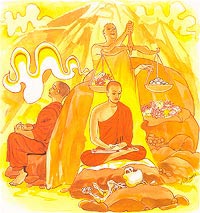 |
Verse 268. Silence Alone Does Not Make A Sage
Explanation: The ignorant person, possessing foolish ways |
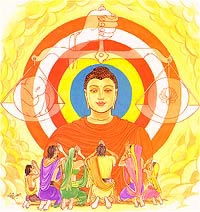 |
Verse 269. Only True Wisdom Makes a Sage
Explanation: Weighing what is right and wrong, he shuns evil. |
Dhammapada Verses 268 and 269
Titthiya Vatthu
Na monena muni hotimulharupo aviddasu
yo ca tulamva paggayha
varama1 daya pandito.
Papani parivajjeti
sa muni tena so muni
yo munati ubho loke2
“muni” tena pavuccati.
Verses 268 & 269: Not by silence does one become a muni, if one is
dull and ignorant. Like one holding a pair of scales, the wise one takes what is
good and rejects what is evil. For this reason he is a muni. He who
understands both internal and external aggregates is also, for that reason,
called a muni.
1. varam: the best, the good, the noble. In this context, it
means morality (sila), concentration (samadhi) and knowledge (panna), etc. (The
Commentary)
2. ubho loke: lit., both worlds, meaning internal and external
aggregates, or one’s own aggregates as well as those of others.
The Story of the Followers of Non-Buddhist Doctrines
While residing at the Jetavana monastery, the Buddha uttered Verses (268) and
(269) of this book, with reference to some non-Buddhist ascetics.
To those who offered them food or other things, those ascetics would say
words of blessing. They would say, “May you be free from danger, may you
prosper and get rich, may you live long,” etc. At that time, the followers
of the Buddha did not say anything after receiving something from their
lay-disciples. This was because during the first twenty years after the Buddha’s
attainment of Buddhahood they were instructed to remain silent on receiving
offerings. Since the followers of the Buddha were silent when ascetics of other
doctrines were saying things which were pleasing to their disciples, people
began to compare the two groups.
When the Buddha heard about this, he permitted the bhikkhus to say words of
blessing to their disciples after receiving offerings. As a result of that, more
and more people invited the followers of the Buddha for alms. Then, the ascetics
of other doctrines remarked with disdain: “We adhere to the practice of the
muni and keep silent, whereas the followers of Samana Gotama go about talking
exuberantly in the eating places.” On hearing those disparaging remarks,
the Buddha said, “Bhikkhus! There are some who keep silent because they
are ignorant and timid, and some who keep silent because they do not want to
share their profound knowledge with others. Only one who has overcome evil is to
be called a muni.”
North Carolina
• Wat Carolina Buddhajakra Vanaram
http://en.wikipedia.org/wiki/Wat_Carolina_Buddhajakra_Vanaram
Wat Carolina Buddhajakra Vanaram is a Thai Buddhist Monastery. It is located near Bolivia, North Carolina (or about 20 miles (32 km) west of Wilmington, North Carolina). The Wat Carolina Monastery is under the leadership of Abbot Phrakru Buddamonpricha.
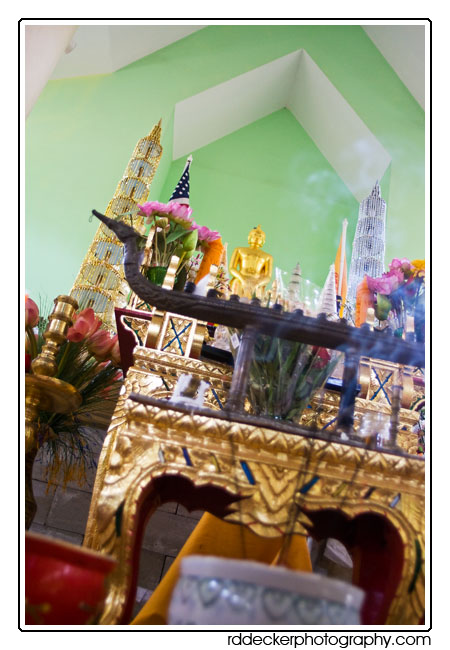

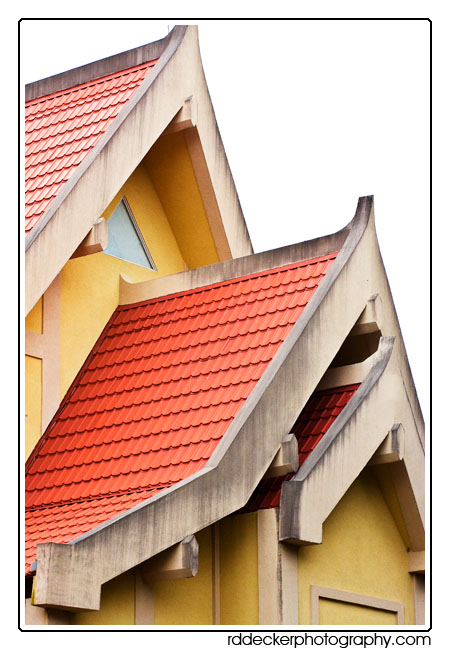
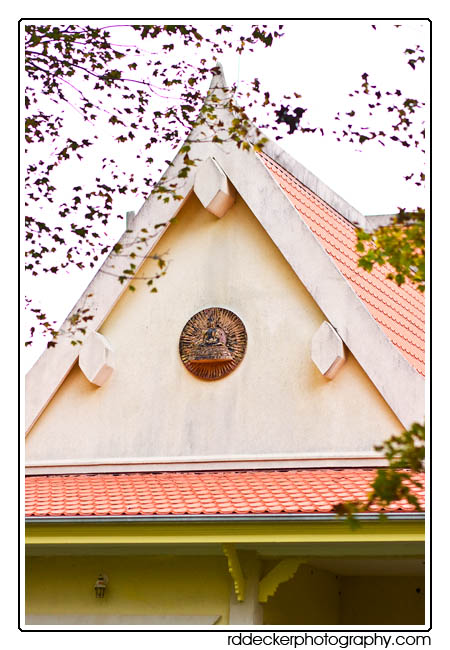


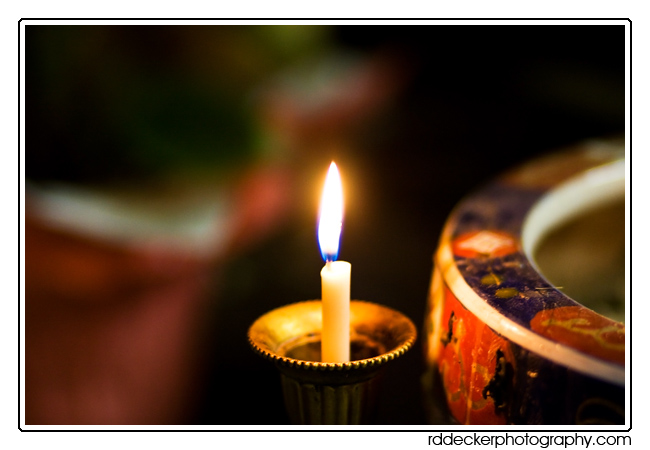
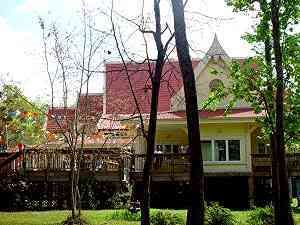
[11]
| O |
NCE upon a time a Big Rat lived in the forest,
and many hundreds of other Rats called him their Chief.
![[Illustration]](http://www.mainlesson.com/books/babbitt/morejataka/zpage012.gif)
A Tricky Wolf saw this troop of Rats,
and began to plan how he could catch them.
He wanted to eat them, but how was he to get them?
At last he thought of a plan.
He went to a corner near the home of the Rats
and waited until he saw one of them coming.
Then he stood up on his hind legs.
The Chief of the Rats said to the Wolf,
“Wolf, why do you stand on your hind legs?”
“Because I am lame,” said the Tricky Wolf.
“It hurts me to stand on my front legs.”
“And why do you keep your mouth open?” asked the Rat.
“I keep my mouth open so that I may drink in all the air I can,”
said the Wolf. “I live on air;
it is my only food day after day. I can not run or walk,
so I stay here. I
[13] try not to complain.”
When the Rats went away the Wolf lay down.
![[Illustration]](http://www.mainlesson.com/books/babbitt/morejataka/zpage013.gif)
The Chief of the Rats was sorry for the Wolf,
and he went each night and morning with all the other Rats
to talk with the Wolf, who seemed so poor, and who did not complain.
Each time as the Rats were leaving,
the Wolf caught and ate the last one. Then he wiped his lips,
and looked as if nothing had happened.
Each night there were fewer Rats at bedtime.
Then they asked the Chief of the Rats what the trouble was.
He could not be sure, but he thought the Wolf was to blame.
So the next day the Chief said to the other Rats,
“You go first this time and I will go last.”
They did so, and as the Chief of the Rats went by,
the
[14] Wolf made a spring at him. But the Wolf was not quick enough,
and the Chief of the Rats got away.
“So this is the food you eat.
Your legs are not so lame as they were.
You have p
http://www.allaboutkidsnc.com/
http://www.secretary.state.nc.us/kidspg/
At Fun World you can have a fun and safe experience with great games and
fantastic pizza in a wholesome family…
What to do in Charlotte |
Fun things to do in Raleigh with kids |
Places to visit in Wilmington |
What to do with kids in Winston Salem |
Things to do in Asheville for kids |
Things to do in NC with kids |
Indoor Play in South Carolina |
Tennessee Indoor Play
What to do with your kids in Tennessee |
Places to go in South Carolina |
Georgia for kids |
Things to do in VA |
What to do in KY with kids |
Indoor Play near Charlotte |
Indoor Play near Raleigh |
Indoor Play near Wilmington |
Indoor Play near Winston Salem |
Then the Buddha spoke in verse as follows:
| Verses 268 & 269: Not by silence does one become a muni, if one is dull and ignorant. Like one holding a pair of scales, the wise one takes what is good and rejects what is evil. For this reason he is a muni. He who understands both internal and external aggregates is also, for that reason, called a muni. |
Dhammapada Verses 266 and 267 Annatarabrahmana Vatthu- Verse 266. One Is Not A Monk Merely By Begging Alms Food- Verse 267. The Holy Life Makes a Monk
This sutta is widely considered as a the main reference for meditation practice.
Puna ca·paraṃ, bhikkhave, bhikkhu imam·eva kāyaṃ, uddhaṃ pādatalā adho kesa·matthakā, taca·pariyantaṃ pūraṃ nānappakārassa asucino paccavekkhati: ‘Atthi imasmiṃ kāye kesā lomā nakhā dantā taco maṃsaṃ nhāru aṭṭhi aṭṭhimiñjaṃ vakkaṃ hadayaṃ yakanaṃ kilomakaṃ pihakaṃ papphāsaṃ antaṃ antaguṇaṃ udariyaṃ karīsaṃ pittaṃ semhaṃ pubbo lohitaṃ sedo medo assu vasā kheḷo siṅghāṇikā lasikā muttaṃ’ ti. |
|
|
Seyyathāpi, bhikkhave, ubhatomukhā putoḷi pūrā nānāvihitassa dhaññassa, seyyathidaṃ sālīnaṃ vīhīnaṃ muggānaṃ māsānaṃ tilānaṃ taṇḍulānaṃ. |
|
|
Iti ajjhattaṃ vā kāye kāyānupassī viharati, bahiddhā vā kāye kāyānupassī viharati, ajjhatta-bahiddhā vā kāye kāyānupassī viharati; samudaya-dhamm·ānupassī vā kāyasmiṃ viharati, vaya-dhamm·ānupassī vā kāyasmiṃ viharati, samudaya-vaya-dhamm·ānupassī vā kāyasmiṃ viharati; ‘atthi kāyo’ ti vā pan·assa sati paccupaṭṭhitā hoti, yāvadeva ñāṇa·mattāya paṭissati·mattāya, a·nissito ca viharati, na ca kiñci loke upādiyati. Evam·pi kho, bhikkhave, bhikkhu kāye kāyānupassī viharati. |
|
தமிழ்
மேலும், பிக்குக்களுக்களே, ஒரு பிக்கு, இதே உடம்பில்,உச்சைந்தலை முடியிலிருந்து கீழ்நோக்கி உள்ளங்கால் வரை, மெல்லிய தோல் மற்றும் பல்வேறு வகைப்பட்ட அசுத்தம் நிறைந்த, ‘இந்த kāya, உடம்பு தலை முடி, உடம்புமுடி, நகம், பற்கள், மெல்லியல் தோல், தசை, தசை நாண், எலும்பு, எலும்புச்சோறு, சிறுநீரகம், இதயம், கல்லீரல்,மார்புவரி, மண்ணீரல், சுவாசப்பை,குடல், குடல்தாங்கி, இரைப்பை அதனுடைய உள்ளடங்கல், மலம், பித்தநீர், கபம், சீழ், இரத்தம், வியர்வை, கொழுப்பு, கண்ணீர், மசகிடு, உமிழ்நீர், மூக்குச்சளி, உயவுநீர்மஞ் சார்ந்த நீர்த்தன்மையுள்ள மற்றும் சிறுநீர் அதன் வரம்பிடலில் உள்ளது என அறீவார்.
ஒருவேளை பிக்குக்களுக்களே,அங்கே ஒரு பை இரண்டு வாயில்கள் உடையதாயிருப்பின், பல்வேறு வகைப்பட்ட தானியம், குன்று நெல் பயிர், நெல் பயிர், பச்சைப்பருப்பு, மாட்டு பட்டாணி, எள்ளு விதை, தொலியல். ஒரு மனிதன் நல்ல பார்வையாற்றல் உடையவராயிருத்தல் கட்டு அவிழ்க்கப் பட்டவுடன் ஆழ்ந்து ஆராய விரும்பி ,”இது குன்று நெல் பயிர்,நெல் பயிர், பச்சைப்பருப்பு, மாட்டு பட்டாணி, எள்ளு விதை, தொலியல்என அறீவார்.” அதே போல், பிக்குக்களுக்களே, ஒரு பிக்கு, இதே உடம்பில்,உச்சைந்தலை முடியிலிருந்து கீழ்நோக்கி உள்ளங்கால் வரை, மெல்லிய தோல் மற்றும் பல்வேறு வகைப்பட்ட அசுத்தம் நிறைந்த, ‘இந்த kāya, உடம்பு தலை முடி, உடம்புமுடி, நகம், பற்கள், மெல்லியல் தோல், தசை, தசை நாண், எலும்பு, எலும்புச்சோறு, சிறுநீரகம், இதயம், கல்லீரல்,மார்புவரி, மண்ணீரல், சுவாசப்பை,குடல், குடல்தாங்கி, இரைப்பை அதனுடைய உள்ளடங்கல், மலம், பித்தநீர், கபம், சீழ், இரத்தம், வியர்வை, கொழுப்பு, கண்ணீர், மசகிடு, உமிழ்நீர், மூக்குச்சளி, உயவுநீர்மஞ் சார்ந்த நீர்த்தன்மையுள்ள மற்றும் சிறுநீர் அதன் வரம்பிடலில் உள்ளது என அறீவார்.
இவ்வாறு அவர் kāya in kāya உடல்/காயத்தை காயதுக்குள் கண்காணி வாசம் செய்கிரார், அல்லது காயத்தை காயதுக்கு வெளியே கண்காணி வாசம் செய்கிரார், அல்லது காயத்தை காயதுக்கு உள்ளே மற்றும் வெளியே கண்காணி வாசம் செய்கிரார்;புலன்களால் உணரத்தக்க எழுச்சி கண்காணி வாசம் செய்கிரார், மற்றும் புலன்களால் உணரத்தக்கதை கடந்துசெல்லுவதை கண்காணித்து வாசம் செய்கிரார்; இல்லாவிடில் எச்சரிக்கையாயிருக்கிற உணர் உடனிருக்கிறதை,சும்மா வெறும் ஓர்அளவு ஞானம் மற்றும் ஓர்அளவு paṭissati என எண்ணி பற்றறு வாசம் செய்கிரார்.
|
|||||||||
New York
Chuang Yen Monastery in New York
• Blue Cliff Monastery
• Chapin Mill Zen Retreat Center
• Chogye International Zen Center
• Chuang Yen Monastery
• Dai Bosatsu Zendo Kongo-ji
• Karma Triyana Dharmachakra
• Mahamevnawa Buddhist Monastery (Theravada)
• Namgyal Monastery
• New York Mahayana Temple
• New York Zendo Shobo-Ji
• Rochester Zen Center
• USA Shaolin Temple
• Still Mind Zendo
• Vajiradhammapadip Temple
• Village Zendo
• Zen Center of Syracuse
• Zen Mountain Monastery
http://en.wikipedia.org/wiki/Blue_Cliff_Monastery
| Blue Cliff Monastery | |
|---|---|
 |
|
| Dining Hall and Meditation Hall | |
| Information | |
| Denomination | Order of Interbeing Lam Te Dhyana |
| Founded | 2007 |
| Founder(s) | Thich Nhat Hanh |
| Address | 3 Mindfulness Way Pine Bush, NY 12566 |
| Country | United States |
| Website | BlueCliffMonastery.org |
Blue Cliff Monastery is a 80-acre (0.32 km2) Buddhist monastery located in Pine Bush, New York.[1][2] It was founded in May 2007 by monastic and lay practitioners from Plum Village in France.[3][4]
The monastery is under the direction of Thich Nhat Hanh’s Order of Interbeing in the Vietnamese Zen
tradition. Blue Cliff Monastery follows the same practices and daily
schedules as its root monastery Plum Village and its sister monasteries Deer Park Monastery in Escondido, California and Magnolia Village Practice Center in Batesville, Mississippi.[5]
Blue Cliff Monastery was created when the monastics moved from Maple Forest Monastery and the Green Mountain Dharma Center. In 1997 Maple Forest Monastery was founded in Woodstock, Vermont and a year later Green Mountain Dharma Center was founded in Hartland, Vermont. Maple Forest was the monks’ residence and Green Mountain was the nuns’ residence.[6] On May 2007 both centers moved to Blue Cliff Monastery.[7]
The Monastery is located in the lush green Hudson Valley of New York (one hour and 30 minutes away from NYC).[8]
Inside the property there are two ponds and a creek, and out of its 80
acres 65 are forest. Visitors are welcome to practice mindfulness with
the fourfold community of monks, nuns, laymen and laywomen. Typically
days of mindfulness are held twice a week (Thursdays and Sundays).
Retreats are held frequently throughout the year.[9][10][11][12][13]
Chapin Mill Buddhist Retreat Center is the 135-acre (0.55 km2) Buddhist Retreat center of the Rochester Zen Center located at 8603 Seven Springs Rd, Batavia, NY, between Buffalo, NY and Rochester, NY.
Ralph Chapin, a member and friend of the Center donated the property to
the Center in 1996. The retreat center held a groundbreaking in April
2000. Building began in 2003 and was mostly completed in 2007. The
center has a new zendo completed in July 2007.
Sesshin are regularly held at Chapin Mill. Held are 2 & 7 day sesshin.
Huge 3-foot (0.91 m) wide Mokugyu drum. Sounds like a heart beat.
Facing enso, zendo on right carved door on left.
Dokusan line (facing dining hall)
Chogye International Zen Center is a Kwan Um School of Zen practice center founded by Seung Sahn in 1975, located in New York City. The center offers a daily practice regimen, as well as retreats and workshops. Wu Kwang is the guiding teacher and resident Zen Master, the abbot is Steven Cohen.[1]Prebish, Charles S (1999). Luminous Passage: The Practice and Study of Buddhism in America. University of California Press. pp. 34. ISBN 0-520-21697-0.
Morreale, Don (1998). The Complete Guide to Buddhist America. Shambhala Publications. pp. 171.
Coordinates: 41°29′00″N 73°47′40″W
| Chuang Yen Monastery | |
|---|---|
 |
|
| Kuan Yin Hall at the Chuang Yen Monastery. | |
| Information | |
| Denomination | Pure land |
| Country | United States |
| Website | http://www.baus.org/baus/about_us/intro_cym.html |

Kuan Yin Hall at the Chuang Yen Monastery.
Chuang Yen Monastery (Chinese: 莊嚴寺; pinyin: Zhuāngyán Sì; literally “solemn monastery”) is a Pure Land buddhist monastery in Carmel, New York. The monastery was built and is maintained by the Buddhist Association of the United States on land donated by C. T. Shen. His autobiography, My Memoir is published by The Institute for Advanced Studies of World Religions and is distributed free at the monastery.
The monastery grounds contain several prayer halls, dormitories, a
dining hall, a memorial area, and a library. Most of the buildings are
built in an imitation of Tang dynasty architecture, and the main hall contains a 37-foot statue of the Buddha Vairocana,
encircled by 10,000 small statues of the Buddha on a lotus terrace. The
larger Buddha statue is said to be the largest of its kind in the
Western Hemisphere.
They hold also seminars and summer camps in both the English and Chinese languages.
| Dai Bosatsu Zendo Kongo-ji | |
|---|---|
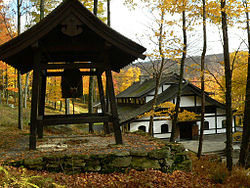 |
|
| Information | |
| Denomination | Rinzai |
| Founded | July 4, 1976 |
| Founder(s) | Soen Nakagawa & Eido Tai Shimano |
| Address | 223 Beecher Lake Road, Livingston Manor, New York 12758-6000 |
| Country | United States |
| Website | http://www.daibosatsu.org/dbzindex.html Kongo-ji |

Dai Bosatsu Zendo Kongo-ji zendo
Dai Bosatsu Zendo Kongo-ji, or International Dai Bosatsu Zendo Kongo-ji, is a Rinzai monastery and retreat center located in the Catskill Mountains of upstate New York. Maintained by the Zen Studies Society, Dai Bosatsu Zendo Kongo-ji is led by Shinge-Shitsu Roko Sherry Chayat. Located on 1,400 acres (5.7 km2) near Beecher Lake[1] in a deciduous forest region[2], Dai Bosatsu Zendo Kongo-ji was established on July 4, 1976.[1] The site offers daily services which include zazen, chanting and samu (work). Dai Bosatsu Zendo Kongo-ji also offers traditional ango — “a three-month period of intensive spiritual training in a Zen monastery during the rainy season in summer”[3] — in addition to weeklong sesshins and weekend retreats throughout the year.[1] The monastery site is located atop a 2-mile (3.2 km) drive that passes through “Sangha Meadow”, a cemetery for housing the cremated remains of deceased sangha members (including a portion of the ashes of Soen Nakagawa).[2]

KTD Shrine Room with HH 17th Karmapa Ogyen Trinley Dorje enthroned
Karma Triyana Dharmachakra[1] is a Tibetan Buddhist monastery in Woodstock, New York, USA, which serves as the North American seat of His Holiness the 17th Gyalwa Karmapa, head of the Karma Kagyu lineage. It was founded in 1976 by the 16th Gyalwa Karmapa. The abbot has been Khenpo Karthar Rinpoche from the inception of the monastery to present (November, 2011).
| This article relies on references to primary sources or sources affiliated with the subject. (May 2011) |
| Mahamevnawa Buddhist Monastery | |
|---|---|
| Motto | The world that Buddha saw |
| Formation | 14 August 1999 |
| Type | Organization of Buddhist monasteries |
| Purpose/focus | Spiritual Development |
| Headquarters | Polgahawela, Sri Lanka |
| Location | Sri Lanka (35 branches); Toronto, CA; New Jersey, USA; Sydney, AU; London, UK; Offenbach, DE (List of Mahamevnawa Branches) |
| Region served | Worldwide |
| Membership | practicing Buddhists |
| Founder | Kiribathgoda Gnanananda Thero |
| Website | http://www.mahamevnawa.lk http://www.buddhavision.com |
Mahamevnawa Buddhist Monastery is an organization of Buddhist monasteries, of Sri Lankan origin established to benefit the spiritual development of human beings using the teachings of the Gautama Buddha.[1] Its main main monastery is in Polgahawela, Sri Lanka, and Sri Lanka is home to 35 branches of the organization. Overseas branches are in Canada,[2] USA, Australia, UK [3] and Germany.[4]
The founder and the chief Buddhist monk in charge of these monasteries is Venerable Kiribathgoda Gnanananda Thero,
who is engaged in spreading Buddhism to both local and international
communities, and in highlighting the aim of Buddhism: putting and end to
Dukkha (suffering) or attaining Nibbana.
http://en.wikipedia.org/wiki/Namgyal_Monastery
| [show]
Part of a series on Tibetan Buddhism |
|---|

Namgyal Monastery Dharamsala, India
Namgyal Monastery (Tibetan: རྣམ་གྱལ་, Wylie: rnam rgyal, ༸སྐུ་བཅར་རྣམ་པར་རྒྱལ་བ་ཕན་བདེ་ལེགས་བཤད་གླིང། named for a long-life deity) is a Tibetan Buddhist monastery associated with the Dalai Lamas. Founded in 1575 by the Third Dalai Lama, Sonam Gyatso, Namgyal Monastery was historically housed within the Potala Palace
(the red section on top). Namgyal Monastery is personal monastery of
His Holiness the Dalai Lama, Its primary role was to assist with rituals
involving the Dalai Lama of Tibet.
After 1959, Namgyal Monastery relocated to Dharamshala, India, where it continues activity today. (Whether the People’s Republic of China
has maintained an institution with this name is unclear.) According to
its website, Namgyal (Dharamshala) has “nearly 200″ monks (up from 55 in
1959), representing all four Tibetan monastic lineages. Its main
tantric practices are Kalachakra, Yamantaka, Chakrasamvara, Guhyasamaja, and Vajrakilaya.
In 1992, on the advice of the present Dalai Lama, Namgyal established an American branch in Ithaca, New York. For information on this see Namgyal Monastery Institute of Buddhist Studies.
In 1998, Namgyal incorporated a Tibetan monastery in Bodhgaya,
India, called Gendhen Phelgyeling. The monastery is now known as
Namgyal (Bodhgaya), and has 45 monks. Namgyal (Dharamsala) also manages a
temple in Kushinagar (since 1967), and an elderly home in Simla (since 1992).
http://en.wikipedia.org/wiki/New_York_Mahayana_Temple
| Retreat Mahayana Temple | |
|---|---|
| Information | |
| Denomination | Pure land |
| Founded | 1962 |
| Founder(s) | Mrs. Annie Ying |
| Address | 710 Ira Vail Rd, Leeds, NY 12451 |
| Country | United States |
| Website | http://www.mahayana.us |
Mahayana Temple (Chinese: 大乘寺;; pinyin: Da Cheng Si) is a Chinese Buddhist temple located within a forest in South Cairo, N.Y.. It is the retreat of the Eastern States Buddhist Temple of America, Inc. (“ESBT”). The original retreat land was donated by Mr. James Ying. The downtown branch of the Mahayana Temple (aka Mahayana City Campus) is located in New York.
The temple grounds in South Cairo contain the Grand Buddha Hall (with
dormitories located in the wings and a dining hall located on the lower
level), the Kuan Yin Hall, the 500 Arhat Hall, a six storied pagoda, and
the newly-completed Earth Store Bodhisattva Hall as well as a
three-unit temple dedicated to the spirits of the land.
http://en.wikipedia.org/wiki/New_York_Zendo_Shobo-Ji
New York Zendo Shobo-Ji, or Temple of True Dharma, is a Rinzai zen practice facility located in the upper East Side of Manhattan, NY. It is part of the Zen Studies Society. Founded on September 15, 1968 by Japanese Zen master Soen Nakagawa, the building had been converted from a private home. Eido Tai Shimano, now retired, was the founding abbot; he was succeeded by Roko Sherry Chayat, who is the current abbot.
http://en.wikipedia.org/wiki/Rochester_Zen_Center
| Rochester Zen Center | |
|---|---|
 |
|
| Information | |
| Denomination | Independent |
| Founded | 1966 |
| Founder(s) | Philip Kapleau |
| Abbot(s) | Bodhin Kjolhede |
| Address | 7 Arnold Park Rochester, New York 14607-2082 |
| Country | United States |
| Website | http://www.rzc.org/ |
| Part of a series on |
| Zen |
|---|
 |
| Part of a series on |
| Western Buddhism |
|---|
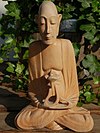 |
The Rochester Zen Center (RZC) is a Sōtō and Rinzai Zen Buddhist sangha in the Sanbo Kyodan lineage, located in Rochester, New York and established in 1966 by Philip Kapleau. It is one of the oldest Zen centers in the United States.[citation needed]
http://en.wikipedia.org/wiki/Shi_Yan_Ming
| Shì Yánmíng 釋延明 |
|
|---|---|
 Shi Yan Ming at USA Shaolin Temple in Lower Manhattan, November 4, 2010. |
|
| Religion | Chan Buddhism |
| School | Shaolin Temple |
| Lineage | 34th Generation Shaolin Warrior Monk |
| Dharma name(s) | Shì Yánmíng 釋延明 |
| Personal | |
| Nationality | Chinese American |
| Born | February 13, 1964 Zhumadian Village, Henan Province, |
| Senior posting | |
| Title | Chan Master, Founder and abbot of the USA Shaolin Temple |
| Religious career | |
| Teacher | Shi Yong Qian (釋永乾) |
| Students | RZA, Wesley Snipes, Rosie Perez, Bokeem Woodbine, John Leguizamo[1] |
| Website | http://usashaolintemple.org |
Shi Yan Ming (born Duan Gen Shan February 13, 1964) is a 34th[2] generation Shaolin warrior monk,[3] teacher and actor, best known as the founder of USA Shaolin Temple.[4] Trained at the Shaolin Temple in the People’s Republic of China (PRC) since the age of five, Shi Yan Ming defected to the United States in 1992, before opening the USA Shaolin Temple in Manhattan,
where he has taught hundreds of students, including numerous
celebrities. He has made various media appearances in television, film
and print, including National Geographic, PBS, History, Time magazine, and the 1999 American samurai action film, Ghost Dog: The Way of the Samurai.
http://en.wikipedia.org/wiki/Still_Mind_Zendo
| Still Mind Zendo | |
|---|---|
| Information | |
| Denomination | White Plum Asanga (Sōtō) |
| Founded | 1994 |
| Founder(s) | Janet Jiryu Abels Sensei |
| Abbot(s) | Janet Jiryu Abels Sensei Gregory Hosho Abels Sensei |
| Address | 37 West 17th Street, 6th Floor, New York, New York 10011 |
| Country | United States |
| Website | www.stillmindzendo.org/ |
Still Mind Zendo, a Zen meditation center formed in 1994, is in the
Soto lineage of the late Taizan Maezumi Roshi and the White Plum Asanga.
The founder and resident teacher of Still Mind Zendo, Sensei Janet
Jiryu Abels, is a dharma successor of Roshi Robert Jinsen Kennedy as is
Sensei Gregory Hosho Abels, the co-resident teacher at the center.
Still Mind Zendo emphasizes the practice of zazen (sitting
meditation) above all else, recognizing it as a way for people to deepen
their insight and realization of their essential self, which is nothing
other than the realization of their lives. And because essential self
or essential nature is not bound by the limitations of any religion or
gender or path in life, people from all walks of life and from all
religious or non-religious backgrounds are welcomed.
The singular commitment to zazen makes practice at Still Mind Zendo a
simple one. Because the two teachers have chosen to be lay teachers and
are not ordained as Zen priests, there are no services and robes are
not worn. There is, however, deep commitment to the teachings of the
ancestors; to the disciplines of the Way; to the attention to posture
and detail; to the practice of being in the moment; and to the extension
of that practice into every facet of life. Weekly dharma talks are
given and dokusan or daisan (private teaching) is available, offering
guidance in both zazen and koan study.
Understanding how daunting Zen often seems, simple, practical and
accessible instruction is available, beginning with the bi-monthly Zen
for Beginners program. Understanding how difficult is the continuation
of Zen practice, Still Mind Zendo offers strong challenge and the
support of caring and like-minded people. In addition to daily zazen
(except for Sunday and Monday when the center is closed), weekend and
week retreats (sesshin), study sessions and related workshops are
offered.
Sensei Janet Jiryu Abels, founder of Still Mind Zendo, has been a Zen
teacher since 2000 prior to which she was in private practice as a
spiritual director for 15 years, also working as a community organizer
and peace activist. She is married to Sensei Gregory Abels and they are
the parents of a grown daughter.
Sensei Gregory Hosho Abels is co-resident teacher at Still Mind
Zendo. As well as being a Zen teacher, he has enjoyed a 50 year career
as an actor, theatre director and Master Teacher of Acting and is also a
poet, his writing being informed by his Zen practice.
The zendo is located at 37 W. 17th Street in Manhattan. A schedule
and further details can be found at www.stillmindzendo.org. Still Mind
Zendo is a not-for-profit organization in the State of New York run by a
Board of Directors made up of members.
http://en.wikipedia.org/wiki/Vajiradhammapadip_Temple
| Part of a series on |
| Buddhism |
|---|
 |




| Village Zendo | |
|---|---|
 |
|
| Group shot of the Village Zendo sangha. | |
| Information | |
| Denomination | Sōtō (White Plum Asanga) |
| Founded | 1986 |
| Founder(s) | Enkyo Pat O’Hara |
| Address | 588 Broadway, Suite 1108 New York, New York 10012-3229 |
| Country | United States |
| Website | www.villagezendo.org/ |
Village Zendo is a Soto Zen practice center originally located in the apartment of Enkyo Pat O’Hara, who founded the zendo in 1986. Formerly located in a red brick building, the Zen center took up the majority of space in O’Hara’s apartment.[1] The center has since moved to its new location on Broadway in New York City.[1] Village Zendo is a practice center of the White Plum Asanga and Zen Peacemaker Circle, the former founded by O’Hara’s teacher Taizan Maezumi and the latter by Bernard Glassman.[2][3]
http://en.wikipedia.org/wiki/Zen_Center_of_Syracuse
| Zen Center of Syracuse | |
|---|---|
| Information | |
| Denomination | Rinzai |
| Founded | 1972 |
| Abbot(s) | Roko Sherry Chayat |
| Address | 266 West Seneca Turnpike, Syracuse, New York 13207 |
| Country | United States |
| Website | http://www.zencenterofsyracuse.org |
The Zen Center of Syracuse (or, Syracuse Zen Center), temple name Hoen-ji, is a Rinzai Zen Buddhist practice center in Syracuse, New York, one of the oldest continuously running Zen centers in the United States.[1] Founded in 1972, the center is currently led by Roko Sherry Chayat (the first officially recognized female Rinzai roshi in the United States).[2] Originally located at 111 Concord Place, the center is located in both the former carriage house and home of Joshua Forman (the first mayor of Syracuse) and offers Zen practice for laypeople.[3][4] It began as a group of graduate students from Syracuse University, with Chayat eventually becoming the center’s leader.[1] In addition to Zen practice, the center also provides some instruction in Tibetan Buddhism. According to The Encyclopedia of Women and Religion in North America,
“The Syracuse Zen Center also leads meditation at Syracuse University,
Syracuse area schools, recovery and justice system institutions,
hospitals and corporations.”[5] The center also won two awards for their restoration of The Forman House from the Preservation Association of Central New York . This house was instrumental during the War of 1812 and the American Civil War, for it was a bandage assembly area for wounded troops.[6]

http://en.wikipedia.org/wiki/Zen_Mountain_Monastery
| Zen Mountain Monastery | |
|---|---|
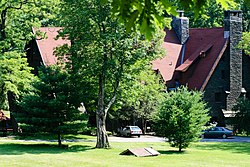 |
|
| Information | |
| Denomination | Mountains and Rivers Order (Zen) |
| Founded | 1980 |
| Founder(s) | John Daido Loori |
| Abbot(s) | Konrad Ryushin Marchaj |
| Address | P.O. Box 197 Mount Tremper, New York 12457 |
| Country | United States |
| Website | Zen Mountain Monastery |
|
Camp Wapanachki
|
|
|
|
|
| Location: | S. Plank Rd. (Old Co. Rt 28) at jct. with Miller Rd., Shandaken, Mt. Tremper, New York |
| Coordinates: | 42°2′56″N 74°16′21″WCoordinates: 42°2′56″N 74°16′21″W |
| Area: | 235 acres (95 ha) |
| Built: | 1935 |
| Architect: | Haffner, V.L.S. |
| Governing body: | Private |
| NRHP Reference#: | 94001372[1] |
| Added to NRHP: | November 25, 1994 |
Zen Mountain Monastery (or, Doshinji, meaning Temple of the Way of Reality) is a Zen Buddhist monastery and training center on a 230-acre (0.93 km2) forested property in the Catskill Mountains in Mount Tremper, New York. It was founded in 1980 by John Daido Loori, originally as the Zen Arts Center. It combines the Rinzai and Sōtō Zen traditions, in both of which Loori received dharma transmission. Since Loori’s death in October 2009, Zen Mountain Monastery has two teachers: Geoffrey Shugen Arnold, who received Dharma transmission from Loori in 1997, and Konrad Ryushin Marchaj, the abbot of the monastery.
http://www.ny.com/kids/
So come get your summer at Seabreeze!
Immerse yourself in nearly 2000 acres of exquisite landscape at Fort
Ticonderoga. Experience the story of how the blood spilled to create an
empire in the French & Indian War resulte…
Places to go in Massachusetts with kids |
Things to do in Connecticut
What to do in Pennsylvania |
Things to do in Vermont with kids |
Places to visit in New Jersey
What is there to do in Manhattan for kids |
Things to do with kids in Rochester |
Things for kids to do in Lake George |
Places to visit in New York City with kids |
Fun places for kids in Brooklyn
http://www.mainlesson.com/display.php?author=babbitt&book=morejataka&story=fishes
[8]
| O |
NCE upon a time three Fishes lived in a far-away river.
They were named Thoughtful,
Very-Thoughtful, and Thoughtless.
One day they left the wild country where no men lived,
and came down the river to live near a town.
Very-Thoughtful said to the other two:
“There is danger all about us here. Fishermen come
to the river here to catch fish with all sorts of nets and lines.
Let us go back again to the wild country where we used to live.”
But the other two Fishes were so lazy and so greedy
that they kept putting off their going from day to day.
But one day Thoughtful and Thoughtless went swimming on ahead
of Very-Thoughtful and they did not see the fisherman’s net
and rushed into it. Very-Thoughtful saw them rush into the net.
“I must save them,” said Very-Thoughtful.
So swimming around the net, he splashed in the water
[9] in front of it,
like a Fish that had broken through the net and gone up the river.
Then he swam back of the net and splashed about there
like a Fish that had broken through and gone down the river.
[9] The fisherman saw the splashing water and thought the Fishes had
![[Illustration]](http://www.mainlesson.com/books/babbitt/morejataka/zpage009.gif)
broken through the net and that one had gone up the river,
the other down, so he pulled in the net by one corner.
That let the two Fishes out of the net
and away they went to find Very-Thoughtful.
“You saved our lives, Very-Thoughtful,” they said,
“and now we are willing to go back to the wild country.”
So back they all went to their old home where they lived safely ever after.

Dear All,
Aligarh, Jul 24 (PTI) The Aligarh Muslim University
Teachers Association (AMUTA) today expressed concern over
incidents of violence in Uttar Pradesh.
It was a matter of great concern for the minority
community that the SP government which received overwhelming
support from Muslims was showing scant concern for their
safety and security in the state, Secretary of the AMUTA
Mustafa Zaidi told reporters here.
Zaidi said that the executive committee of the AMUTA had
recently passed a resolution that the violence in Pratapgarh,
Mathura and Bareilly was an ominous pointer to the fact that
the SP government was appearing to be both uninterested and
incapable of addressing basic issues of governance and
problems of minorities and other weaker sections of the
society.
He said there were allegations against some senior SP
functionaries for having instigated the violence in Pratapgarh
district.
“Instead of taking action against such elements, the UP
government is shielding them,” he alleged.
Zaidi said the Muslim community was fully committed to
the ideals of secularism, nationalism and humanism.
“It is therefore a matter of deep pain when our
nationalist commitment is questioned whenever fringe groups
indulge in acts of senseless terror.” he said. PTI COR AVA PG
Lucknow: Two Uttar Pradesh
State Roadways buses were damaged as members of two communities clashed
over a religious site in Uttar Pradesh’s Faizabad town Tuesday, police
said. A contingent of paramilitary Rapid Action Force (RAF) has been
deployed in the town.
The clash follows similar communal tension in the state’s Bareilly city Sunday.
Police said violence broke
out in the Mirzapur area of Faizabad, 120 km from Lucknow, after a
brief altercation between members of two communities. They then indulged
in heavy stone pelting and went on rampage, damaging two buses of the
Uttar Pradesh State Roadways.
They also raised slogans against the district administration and the state government.
District officials admitted that for the last one week discontent had
been simmering following a dispute over the religious place and its use
but the officials had failed to thrash out a solution.
Senior Superintendent of Police (SSP) Ramit Sharma said the situation
was under control and a platoon of the RAF has been deployed as a
precautionary measure.
No arrests have been made but police are keeping a close watch on the situation, he added.
IANS
DhammapadaVerses 264 and 265 Hatthaka Vatthu-Verse 264. Shaven Head Alone Does Not Make A MonkVerse 265. Who Give Up Evil Is True Monk
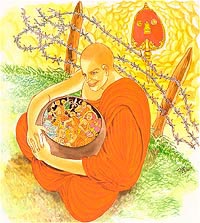 |
Verse 264. Shaven Head Alone Does Not Make A Monk
Explanation: Can an individual who does not practice religion, |
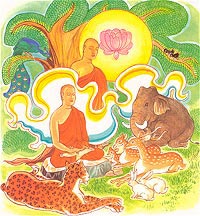 |
Verse 265. Who Give Up Evil Is True Monk
Explanation: If an individual were to quell all defilements, |
Dhammapada Verses 264 and 265
Hatthaka Vatthu
Na mundakena samano
abbato alikam bhanam
icchalobhasamapanno
samano kim bhavissati.
Yo ca sameti papani
anumthulani sabbaso
samitatta hi papanam
“samano” ti pavuccati.
Verse 264: Not by a shaven head does a man become a samana, if he lacks
morality and austere practices and tells lies. How could he who is full of
covetousness and greed be a samana?
Verse 265: He who has totally subdued all evil, great and small, is called a
samana because he has overcome all evil.
The Story of Bhikkhu Hatthaka
While residing at the Jetavana monastery, the Buddha uttered Verses (264) and
(265) of this book, with reference to a bhikkhu named Hatthaka.
Bhikkhu Hatthaka was in the habit of challenging ascetics of non-Buddhist
faiths to meet him in a certain place to debate on religious matters. He would
then go out by himself to the self-appointed place. When nobody appeared he
would boast, “Look, those wandering ascetics dare not meet me, they have
been beaten by me!”, and such other things. The Buddha called Hatthaka to
him and said, “Bhikkhu! Why do you behave in this way? One who says such
things cannot become a samana in spite of his shaven head. Only one who has rid
himself of all evil is to be called a samana.”
Then the Buddha spoke in verse as follows:
|
Verse 264: Not by a shaven head does a man become |
|
Verse 265: He who has totally subdued all evil, |
New Jersey
Soshimsa
• So Shim Sa Zen Center
http://en.wikipedia.org/wiki/So_Shim_Sa_Zen_Center
| So Shim Sa Zen Center | |
|---|---|
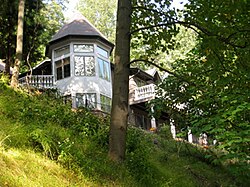 |
|
| Information | |
| Denomination | Seon, Korean Zen |
| Founder(s) | Il-Cho Bobsanim |
| Director(s) | Dir. of Wellness: Ven. Mooh-Sang Dir. of Outreach: Ven. Duhk-Song |
| Abbot(s) | Ven. Myong-Ahn |
| Address | 123 Morning Glory Rd Warren, New Jersey |
| Country | United States |
| Website | soshimsa.org |
So Shim Sa Zen Center ( Hangul: 소심사 Hanja: 少心寺) is a Buddhist organization in New Jersey affiliated with the Taego Order of Korean Zen.[1]
Contents
http://www.examiner.com/article/buddhist-stories-for-children-for-free Buddhist stories for children - for free
There is a large collection of Buddhist stories that are popular with children. These stories are called the Jataka Tales (Wikipedia). The Buddha
Through the wonders of the Internet, you can access and download texts and videos for free to enjoy these ancient stories and, if you feel they are appropriate, to share them with your children. Jataka Tales on video
from short cartoons of the stories to a teaching by the Dalai Lama over ninety minutes long.
Jataka Tales By Ellen C. Babbitt - This is a Google book of modern versions of the stories. Jataka Tales Jataka Tales of the Buddha, retold by Ken & Visakha Kawasaki - These are modern retellings of stories from the Cowell edition. Jataka Tales to download
Buddhist Tales for Young & Old, Volume I Buddhist Tales for Young & Old, Volume II http://www.sacred-texts.com/bud/index.htm#jataka http://books.google.com/books?id=Xpbx97xn_7gC&dq=jataka+tales&printsec=frontcover&source=bn&hl=en&ei=zXMxS-iZJsaVtgfFn-2FCQ&sa=X&oi=book_result&ct=result&resnum=6&ved=0CB8Q6AEwBQ#v=onepage&q&f=false http://www.accesstoinsight.org/lib/authors/kawasaki/index.html http://www.mainlesson.com/display.php?author=babbitt&book=morejataka&story=_contents THE GIRL MONKEY AND THE STRING OF PEARLS[3]
NE day the king went for a long walk in the woods.
When they were all ready to go into the water,
As the queen put her string of pearls away in a box,
At first the servant kept her eyes on the jewel-box.
[4] As soon as the Monkey saw this,
By and by the servant awoke. She looked in the box, Up ran the guards from every side.
The servant said: “I sat right here beside the box The guards told the king that the pearls were gone.
“Find the man who stole the pearls,” said the king. After the king had gone, the chief guard said to himself:
“There is something strange here. These pearls,” thought he,
Then the chief guard thought of a trick
After dark that night the guards hung the strings of glass beads
But the Girl Monkey who had taken the queen’s string
The other Monkeys were greatly pleased with their strings of beads.
Then the chief of the guards, who had been hiding near-by, “It was this Girl Monkey, your Majesty, who took the pearls.”
[7] The king was glad enough to get the pearls,
The chief guard told the king
“You are the right man in the right place,”
![[Illustration]](http://www.mainlesson.com/books/babbitt/morejataka/zpage007.gif) |
While Keane’s cartoon kids have stayed the same age,
his real kids have grown up and two followed in their father’s creative
footsteps. Glen, who served as the model for the Billy character, is now
a prominent animator for The Walt Disney Company. He designed and
animated the Beast for Disney’s “Beauty and the Beast” and most recently
did the brilliant animation on Tarzan. Jeff works as his dad’s
assistant on the comic panel. And today, nine grandchildren provide the
cartoonist with a whole new generation of ideas.

Cheney may have shot that man in the face, but at least he didn’t call him an idiot.
DhammapadaVerses 262 and 263
Sambahulabhikkhu Vatthu-Verse 262. Who Gives Up Jealousy Is Good-Natured-Verse 263. Who Uproots Evil Is The Virtuous One
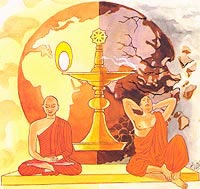 |
Verse 262. Who Gives Up Jealousy Is Good-Natured
Explanation: Merely because of one’s verbal flourishes, |
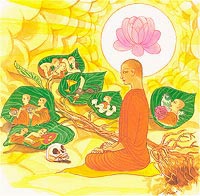 |
Verse 263. Who Uproots Evil Is The Virtuous One
Explanation: If an individual has uprooted and eradicated |
Dhammapada Verses 262 and 263
Sambahulabhikkhu VatthuNa vakkaranamattena
vannapokkharataya va
sadhurupo naro hoti
issuki macchari satho.Yassa cetam samucchinnam
mulaghaccam samuhatam
sa vantadoso medhavi
“sadhurupo” ti vuccati.Verse 262: Not by fine talk, nor by good looks could one be a good-hearted
man, if he were envious, miserly and crafty.Verse 263: A wise man who has cut off, uprooted and removed these and has rid
himself of moral defilements is indeed called a good-hearted man.
The Story of Some Bhikkhus
While residing at the Jetavana monastery, the Buddha uttered Verses (262) and
(263) of this book, with reference to some bhikkhus who were very envious of
other bhikkhus.At the monastery, young bhikkhus and samaneras were in the habit of attending
on older bhikkhus who were their teachers. They washed and dyed the robes, or
else performed other small services for their teachers. Some bhikkhus noticing
these services envied those senior bhikkhus, and so they thought out a plan that
would benefit them materially. Their plan was that they would suggest to the
Buddha that young bhikkhus and samaneras should be required to come to them for
further instruction and guidance even though they had been taught by their
respective teachers. When they went to the Buddha with this proposal, the
Buddha, knowing full well their motive, turned it down. To them the Buddha said,
“Bhikkhus I do not say that you are good-hearted just because you can
talk eloquently. Only he who has got rid of covetousness and all that is evil by
means of Arahatta Magga is to be called a good-hearted man.”Then the Buddha spoke in verse as follows:
Verse 262: Not by fine talk, nor by good looks
could one be a good-hearted man, if he were envious, miserly and
crafty.Verse 263: A wise man who has cut off, uprooted
and removed these and has rid himself of moral defilements is indeed
called a good-hearted man.
New Jersey
Soshimsa
• So Shim Sa Zen Center
http://en.wikipedia.org/wiki/Jemez_Springs,_New_Mexico
http://www.bellaonline.com/articles/art46941.asp
| Jemez Springs, New Mexico | |
|---|---|
| — Village — | |
|
Location of Jemez Springs, New Mexico |
|
| Coordinates: 35°46′15″N 106°41′33″WCoordinates: 35°46′15″N 106°41′33″W | |
| Country | United States |
| State | New Mexico |
| County | Sandoval |
| Area | |
| • Total | 4.8 sq mi (12.4 km2) |
| • Land | 4.8 sq mi (12.4 km2) |
| • Water | 0.0 sq mi (0.0 km2) |
| Elevation | 6,198 ft (1,889 m) |
| Population (2000) | |
| • Total | 375 |
| • Density | 78.1/sq mi (30.2/km2) |
| Time zone | Mountain (MST) (UTC-7) |
| • Summer (DST) | MDT (UTC-6) |
| ZIP code | 87025 |
| Area code(s) | 575 |
| FIPS code | 35-35320 |
| GNIS feature ID | 0918208 |
Jemez Springs is a village in Sandoval County, New Mexico, United States. The population was 375 at the 2000 census.[1] Named for the nearby Pueblo of Jemez[2]:76, the village is the site of Jemez State Monument and the headquarters of the Jemez Ranger District. The village and nearby locations in the Jemez Valley are the site of hot springs and several religious retreats.
http://mountains.choicehotels.com/new-mexico-hotels/familyattractions

http://www.ruidoso.net/visitors/ruidoso_area_kids_guide.htm 
http://www.familydaysout.com/kids-things-to-do-usa/newmexico/
The Museum of Indian Arts & Culture is located on beautiful Museum
HillTM at 710 Camino Lejo off Old Santa Fe Trail in Santa Fe, New
Mexico. The museum is open Tuesday through Sunday from 10:00 am to 5:00
pm.
A visit to the Museum of Indian…
There also will be snacks, face painter, clowns, balloon artists and lots of activities for the Kids.
FREE
Some of the finest mountain scenery in the Southwest is found in the
1…
Places to go in Oklahoma with kids |
Things to do in Colorado
What to do in Texas
|
Things to do in Utah with kids |
Places to visit in Arizona
What is there to do in Albuquerque for kids
|
Things to do with kids in Carlsbad |
Things for kids to do in Taos |
Places to visit in Las Cruces with kids |
Fun places for kids in Santa Fe
http://www.videosurf.com/videos/Jataka+Tales%3A+Elephant+Stories
http://www.videosurf.com/video/jataka-stories-elephant-tales-the-winner-jumbo-animated-movie-1354149468
http://www.videosurf.com/video/jataka-stories-elephant-tales-the-royal-elephant-animated-movie-1357703272
http://www.videosurf.com/video/jataka-tales-animals-of-merit-108812022
http://blog.tsemtulku.com/tsem-tulku-rinpoche/film-tv-music/the-buddha-the-story-of-siddhartha.html
THIS
IS A INTERESTING SHOW ON BUDDHA’S LIFE STORY. Adults would find it
refreshing, and children would find it a nice way to learn. Please take
do enjoy the learning.
I
have provided on my blog a wide variety of subjects to explore, read,
learn, and think about. You literally have to just carry your laptop and
I have so much to share with everyone. You don’t have to keep so many
files in your computer that takes up space, just access this blog. I
will add more to it in time for your benefit. It’s like entering another
world. My world which I open to you.
http://www.huffingtonpost.com/2012/07/16/science-religion_n_1654264.html
As an atheist, I do not believe in god. Neither does Dr. Matthieu Ricard, a Buddhist monk who earned his PhD in cellular genetics and currently lives in the Himalayan region, where he leads humanitarian efforts in India, Nepal, and Tibet.
I sat down with Dr. Ricard at the 2012 World Science Festival
in New York City to talk about science and religion. His comments
surprised my skeptical ears. I’m interested to see if they do the same
for you.
Click the link below and watch the video above to learn more. And
don’t forget to sound off by leaving a comment at the bottom of the
page. Talk nerdy to me!
CARA SANTA MARIA: Hi everyone. Cara Santa Maria here. When Dr. Matthieu Ricard was 26 years old, he earned his doctorate degree in cellular genetics from the Pasteur Institute
in Paris. Instead of pursuing a traditional post-doc, he left his
worldly possessions behind and moved to the Himalayas to become a
Buddhist monk. Today, he’s the founding director of Karuna-Shechen, a humanitarian charity, and he works as the French translator for the Dalai Lama. I sat down with him to discuss Buddhism from a scientific perspective.
DR. MATTHIEU RICARD: It’s not about a religious
practice, and as the Dalai Lama often says religion can be a choice and
we may not make that choice, but we need, from the moment we are born,
we need affection, we need love, we need interconnection, we need
emotional balance. From the moment we are born to the moment we die, we
need to receive and give those affections, love and kindness, and other
qualities. So that’s not an issue of religion, or religion can help each
person in their own part if they choose to do so, it can help
techniques to enhance that, but the main thing is for all human beings
and their techniques to become a better human being.
CSM: I told Dr. Ricard that as a scientist, skeptic,
and atheist, I was wary of the language often used in the context of
Buddhism. Like the word “spirituality,” it just doesn’t compute. So when
I asked him what that term meant to him, well, he surprised me.
MR: When we say
“spirituality,” again we must be careful. I actually don’t use that word
usually. I prefer to speak, let’s say, if I speak of a spiritual path,
for me in Buddhism, it is a path of transformation. Each and every one
of us has the potential for transformation, that’s the fundamental
aspect of Buddhism. We don’t speak of original sin, but original
goodness, and again original goodness is not some kind of weird, sort of
dogmatic thing, it’s just a fact that there’s the potential for change
in every human being. If you look deep within the mind, of course
there’s a lot of emotion, some positive emotion, negative emotion,
sometime anger, sometime love and kindness, but basically the
fundamental nature of mind, you know it’s like light. Cognitive faculty,
the basic cognitive faculty of mind is like a beam of light. It’s not
modified by what it lights up. Like, if light shines on a heap of
garbage it doesn’t become dirty. If light shines on a piece of gold it
doesn’t become expensive. We don’t want to fall prey to the chain
reaction that goes from, you know, feeling a bit upset to animosity to
anger and to full-fledged hate. You don’t want to cause that, the spark
gives birth to that forest fire. You want to just let it vanish before,
that’s all the science of mind that applies to every human being. So a
part of transformation to inner means, that’s what I would call
spirituality. But I would happily dispense of the word spirituality to
say that it is a science of mind. A contemplative science.
CSM: This got me thinking about the eternal debate between science and religion.
I know where I stand, and you may know where you stand. But what does
this man, who is so enlightened in the ways of the scientific method and
Buddhism, have to say?
MR: I think what the Dalai Lama often says about
that, the relation between religion and one’s life, not only with
science, is that it is a fact that possibly more than half of humanity,
even the minimally religious, they don’t really live every moment
according to their religion. And of course there are many completely
nonbelievers, whether they are agnostic or atheist or whatever, those
are human beings, and of course I’m not saying that like a sort of, “OK,
you are also human beings.” No, they are full human beings with a full
potential for being extraordinarily good human beings. So you can’t
associate the potential that we have to express those human qualities
with religion. So that’s why the Dalai Lama says, you know, let’s keep
religion aside. But not being against religion, but it is not
intrinsically linked with religion. So when you speak of secular ethics
and secular spirituality or meditation, he does that. He says, always as
it happens in India, India is a secular state but the notion is
secularism means, respecting all religion including nonbelievers in a
very open society without choosing a particular one and even less
without wanting to impose it on others saying “no, no, because it is
best for me it is best for you,” that doesn’t make sense. As he says
often, “if there was only one dish served in all the worlds’ restaurants
nobody would go to the restaurant, it’s boring.” And also we all have
different mental dispositions. So some people would feel comfortable
with the notion of God, some people it just doesn’t make sense and they
prefer the idea of interdependence and law and cause and effect. And
Buddhism, some people don’t care about Buddhism either, but they still
can and want to be a good human being. So it’s just an option, but it’s
definitely not a necessity.
CSM: Hear hear, Dr. Ricard. What role do you think
religion should play in our modern, scientific society? Let me know your
thoughts on Twitter, Facebook, or by leaving a comment right here on
the Huffington Post. Come on, talk nerdy to me!
To learn more about Dr. Ricard’s humanitarian work and how you can get involved, visit karuna-shechen.org.
http://greatergood.berkeley.edu/gg_live/parenting_videos/
Dhammapada Verses 260 and 261 Lakundakabhaddiyatthera Vatthu Verse 260. Grey Hair Alone Does Not Make An Elder-Verse 261. The Person Full Of Effort Is The True Elder
This sutta is widely considered as a the main reference for meditation practice.
Puna ca·paraṃ, bhikkhave, bhikkhu abhikkante paṭikkante sampajānakārī hoti, ālokite vilokite sampajānakārī hoti, samiñjite pasārite sampajānakārī hoti, saṅghāṭi-patta-cīvara-dhāraṇe sampajānakārī hoti, asite pīte khāyite sāyite sampajānakārī hoti, uccāra-passāva-kamme sampajānakārī hoti, gate ṭhite nisinne sutte jāgarite bhāsite tuṇhībhāve sampajānakārī hoti. |
|
|
Iti ajjhattaṃ vā kāye kāyānupassī viharati, bahiddhā vā kāye kāyānupassī viharati, ajjhatta-bahiddhā vā kāye kāyānupassī viharati; samudaya-dhamm·ānupassī vā kāyasmiṃ viharati, vaya-dhamm·ānupassī vā kāyasmiṃ viharati, samudaya-vaya-dhamm·ānupassī vā kāyasmiṃ viharati; ‘atthi kāyo’ ti vā pan·assa sati paccupaṭṭhitā hoti, yāvadeva ñāṇa·mattāya paṭissati·mattāya, a·nissito ca viharati, na ca kiñci loke upādiyati. Evam·pi kho, bhikkhave, bhikkhu kāye kāyānupassī viharati. |
|
மேலும்,பிக்குக்களுக்களே,ஒரு
பிக்கு, அணுகும் பொழுது மற்றும் விட்டு நீங்கும் பொழுது, sampajañña
நிரந்தரமான தீர்க்கமான உணருந்திறனுடன் நுணுகிக்கண்டு செயல் படுகிரார்,
முன் நோக்கி கவனித்துப் பார்க்கும் பொழுது மற்றும் எல்லாப் பக்கங்களிலும்
கவனித்துப் பார்க்கும் பொழுது,sampajañña நிரந்தரமான தீர்க்கமான
உணருந்திறனுடன் நுணுகிக்கண்டு செயல் படுகிரார், வளைக்கிற பொழுது மற்றும்
நெட்டிமுறியும் பொழுது,sampajañña நிரந்தரமான தீர்க்கமான உணருந்திறனுடன்
நுணுகிக்கண்டு செயல் படுகிரார், பதவிக்குரிய நீண்ட மேலங்கி அணிந்து கொள்
பொழுது மற்றும் தளர்த்தியான மேலங்கி மற்றும் ஐயக்கடிஞை எடுத்துச் செல்லும்
பொழுது,sampajañña நிரந்தரமான தீர்க்கமான உணருந்திறனுடன் நுணுகிக்கண்டு
செயல் படுகிரார், உண்ணும் பொழுது, குடிக்கும் பொழுது, மெல்லும் பொழுது,
சுவைக்கும் பொழுது,sampajañña நிரந்தரமான தீர்க்கமான உணருந்திறனுடன்
நுணுகிக்கண்டு செயல் படுகிரார், வண்டலகற்றும் மற்றும் சிறுநீர் கழிக்கும்
பணி கவனிக்கும் பொழுது,sampajañña நிரந்தரமான தீர்க்கமான உணருந்திறனுடன்
நுணுகிக்கண்டு செயல் படுகிரார், நடந்து செல்கிறே பொழுது நின்று
கொண்டிருக்கிற பொழுது,
உட்கார்ந்திருக்கிற பொழுது, படுத்திருத்திருக்கிற
பொழுது, விழிதிருக்கிற பொழுது, உரையாடுகிற பொழுது, பேசாமலிருக்கிற பொழுது,
sampajañña நிரந்தரமான தீர்க்கமான உணருந்திறனுடன் நுணுகிக்கண்டு செயல்
படுகிரார்.
இவ்வாறு அவர் kāya in kāya உடல்/காயத்தை காயதுக்குள்
கண்காணி வாசம் செய்கிரார், அல்லது காயத்தை காயதுக்கு வெளியே கண்காணி வாசம்
செய்கிரார், அல்லது காயத்தை காயதுக்கு உள்ளே மற்றும் வெளியே கண்காணி வாசம்
செய்கிரார்;புலன்களால் உணரத்தக்க எழுச்சி கண்காணி வாசம் செய்கிரார்,
மற்றும் புலன்களால் உணரத்தக்கதை கடந்துசெல்லுவதை கண்காணித்து வாசம்
செய்கிரார்; இல்லாவிடில் எச்சரிக்கையாயிருக்கிற உணர் உடனிருக்கிறதை,சும்மா
வெறும் ஓர்அளவு ஞானம் மற்றும் ஓர்அளவு paṭissati என எண்ணி பற்றறு வாசம்
செய்கிரார்.
Value of consciousness…

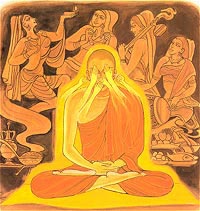 |
Verse 260. Grey Hair Alone Does Not Make An Elder
Explanation: One does not become an elder merely because one’s |
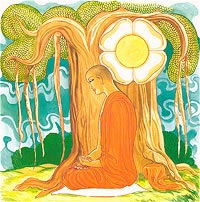 |
Verse 261. The Person Full Of Effort Is The True Elder
Explanation: All things that men do arise out of the mind. |
Dhammapada Verses 260 and 261
Lakundakabhaddiyatthera VatthuNa tena thero so hoti
yenassa palitam siro
paripakko vayo tassa
“moghajinno” ti vuccati.Yamhi saccanca dhammo ca
ahimsa samyamo damo
sa ve vantamalo1 dhiro
“thero2” iti pavuccati.Verse 260: He is not a thera just because his head is grey; he who is ripe
only in years is called “one grown old in vain”.Verse 261: Only a wise man who comprehends the Four Noble Truths and the
Dhamma, who is harmless and virtuous, who restrains his senses and has rid
himself of moral defilements is indeed called a thera.
1. vantamalo: lit., has vomited impurities.
2. thero: an Elder, i.e., a senior member of the Buddhist Order; but often
applied to bhikkhus in general.
The Story of Thera Bhaddiya
While residing at the Jetavana monastery, the Buddha uttered Verses (260) and
(261) of this book, with reference to Thera Bhaddiya. He was also known as
Lakundaka Bhaddiya because he was very short in stature.One day, thirty bhikkhus came to pay obeisance to the Buddha. The Buddha knew
that time was ripe for those thirty bhikkhus to attain arahatship. So he asked
them whether they had seen a thera as they came into the room. They answered
that they did not see a thera but they saw only a young samanera as they came
in. Whereupon, the Buddha said to them, “Bhikkhus! That person is not a
samanera, he is a senior bhikkhu although he is small-built and very unassuming.
I do say that one is not a thera just because he is old and looks like a thera;
only he who comprehends the Four Noble Truths and does not harm others is to be
called a thera.”
Verse 260: He is not a thera just because his head
is grey; he who is ripe only in years is called “one grown old in
vain”.Verse 261: Only a wise man who comprehends the
Four Noble Truths and the Dhamma, who is harmless and virtuous, who
restrains his senses and has rid himself of moral defilements is
indeed called a thera.
At the end of the discourse those thirty bhikkhus attained arahatship.
Nebraska
• Nebraska Zen Center, Omaha, Nebraska
| Nebraska Zen Center | |
|---|---|
 |
|
| Information | |
| Denomination | Soto Zen |
| Founded | 1975 |
| Founder(s) | Rev. Dainin Katagiri |
| Reverend(s) | Rev. Nonin Chowaney |
| Address | 3625 Lafayette Avenue, Omaha, NE 68131 |
| Country | USA |
| Website | Nebraska Zen Center |
The Nebraska Zen Center at the Heartland Temple is a Soto Zen Buddhist Temple located in the Bemis Park Landmark Heritage District of Omaha, Nebraska.[1] Established for Zen practice in 1975, the Nebraska Zen Center follows the tradition established in Japan by Zen Master Eihei Dogen in the 13th century. Rev. Dainin Katagiri was instrumental in establishing Nebraska Zen Center in 1975. Today Rev. Nonin Chowaney is the Center’s teacher.[2][3][4]
Molly and Justin Sousley of Ballard
were caught off guard when their 6-year-old daughter, Jillian, suddenly
displayed some unwelcome traits: cheating, fibbing and poor
sportsmanship. During family game nights, Jillian would regularly alter
the game’s rules to give herself an edge and throw a fit if she didn’t
win. “Right away, we realized that we needed to have some big
conversations about right and wrong,” says Molly.
As the parents of two happy, well-adjusted young children, the
Sousleys have been shocked at the intensity of the moral
issues—including respect, kindness and self-control—that seem to be
cropping up at younger and younger ages. “I remember elementary school
as this idyllic time,” says Molly. “I didn’t expect to be dealing with
things like cheating and lying so soon.”
Add in increasingly raunchy media messaging, declining family time
and growing concern about modern kids’ lack of empathy and conscience,
and it’s no wonder parents like the Sousleys feel like they’re in the
middle of a moral mess.
Modern parents are bombarded with information about how to keep their
child’s body and mind healthy—but what about their child’s moral
health? “Historically, morality was the central goal of child-raising.
Today, that doesn’t appear to be the case,” says Harvard psychologist
Richard Weissbourd, Ed.D., author of The Parents We Mean to Be: How Well-Intentioned Adults Undermine Children’s Moral and Emotional Development.
Bestselling author and parent educator Michele Borba, Ed.D., wrote Building Moral Intelligence: The Seven Essential Virtues That Teach Kids to Do the Right Thing
a decade ago, and believes that today’s moral climate is worse than it
was in 2001. Most Americans agree: A recent Gallup poll indicates that
seven out of 10 Americans feel the moral state of the country is
declining.
As Borba points out, peer cruelty is escalating—government reports
show that a third of middle school and high school students have been
bullied—and today’s kids are more likely to cheat academically than any
past generation. In a 2010 study by University of Nebraska–Lincoln, 87
percent of high school juniors admitted to cheating, and nearly half of
the students surveyed (47 percent) didn’t believe cheating was wrong.
Borba cites a decline in family time as a big reason for a poor moral
atmosphere. In October, University of Missouri human development
scientists reported that wireless technology is harming family
relationships as people spend more time plugged in to a device and less
time connecting with each other.
According to the Kaiser Family Foundation, kids’ media use has
increased more than 20 percent in the past five years. Kids ages 8-18
spend more than 53 hours per week—seven hours and 38 minutes per
day—using entertainment media. Thanks to media multitasking (using more
than one medium at once), they actually observe 10 hours and 45 minutes
of media content per day.
With fewer high-quality, face-to-face interactions, kids don’t have
the chance to build and practice empathy, the trait Borba calls “the
core of goodness.” As Borba notes, “You can’t learn empathy from a
screen.” It’s this troubling lack of empathy, says Borba, that
contributes to antisocial and anticommunity behaviors like bullying and
cheating.
Social entrepreneur Mary Gordon, author of Roots of Empathy: Changing the World Child by Child,
agrees. A longtime educator, Gordon piloted empathy-building program
Roots of Empathy in Seattle in 2007, 11 years after founding it in
Toronto. “When we don’t have empathy, we don’t have a social brake,” she
says. “There is nothing to stop us from being cruel.”
With church attendance declining steadily—the Hartford Institute for
Religion Research reports that church attendance has dropped 16.9
percent over the past 10 years—fewer parents are benefiting from the
support of a values-based community or a ready-made moral script. Lack
of support can hurt parents’ efforts to guide children’s moral growth,
Weissbourd says; parents sometimes need other trusted adults to tell
them when they slip up.
Rabbi Rachel Nussbaum, executive director and cofounder of Seattle’s
Kavana Cooperative and the mom of two young daughters, believes that
religious communities can boost kids’ moral development. “There’s
immense social benefit to belonging to a community of like-minded people
with shared values,” she says. “And any religious tradition has a
shared narrative that parents can use when talking with their children
about morally complex issues.”
Families don’t need to attend a traditional bricks-and-mortar church
or temple to benefit from this type of support, she notes. Innovative
communities are springing up to fill a demand for outside-the-box
religion: Kavana creates Jewish programming centered around holidays,
learning and social activism throughout its Queen Anne neighborhood—at
parks and in private homes—without a physical building.
Regardless of religious affiliation (or non-affiliation), one of the
most important things parents can do for their children is to invest in
their own moral growth, according to Weissbourd. “Parenthood can make
you morally progress or morally regress,” he says. As an example of
moral regression, he points to the increasing numbers of fathers who
abandon their children. (According to David Blankenhorn, author of
Fatherless America, the percentage of children growing up fatherless
doubled between 1960 and 1990.) Today, says Weissbourd, too few parents
view themselves as engaged in moral development—leaving children without
a healthy model of moral growth.
Though it’s tempting to blame declining religious affiliation and
growing media use for children’s moral shortcomings, experts place the
blame squarely on parents’ shoulders. In his book The Moral Intelligence of Children,
Pulitzer Prize–winning author Robert Coles reports that parents are the
single most important source of moral instruction in a child’s life.
Ironically, modern parents’ fixation with their children’s happiness
has become hazardous to kids’ moral health. According to Weissbourd,
happiness has replaced morality as the central goal of raising children.
“My research suggests that in white middle- and upper-class
communities, parents are focused on happiness—goodness tends to be
secondary,” he says.
When parents prioritize happiness over basic human traits like
kindness and compassion, children grow up with a skewed worldview: They
are more likely to have an inflated sense of self, which corresponds to
less empathy for others. The all-encompassing focus on happiness even
creeps into parents’ attempts to teach their children moral values.
Familiar statements like “Be nice to others, and they’ll be nice to
you,” and “Pass the ball to her, and she’ll pass it to you” masquerade
as lessons in kindness and sharing, but the underlying message is that
actions should be motivated by personal happiness—not the greater good.
Children raised on a steady diet of happiness need to learn to
appreciate sadness—an important component of empathy, says the Rev.
David R. Brown of Immanuel Presbyterian Church in Tacoma. “It’s
appropriate and healthy to feel sad and troubled at times, when we’re
thinking about poverty or abuse or problems in our community.” In fact,
sadness is essential to moral development. “That’s how kids can begin to
feel compassion for others.”
Parents also undermine children’s moral growth when they try too hard
to befriend them. This type of “peerenting,” exemplified by Phil Dunphy
on ABC’s hit show Modern Family, can backfire. “We identify
with our kids so much, we often really see their challenges,” says
Melissa Eller, an Edmonds mom of four children ages 16 through 23. “But
sometimes that means we’re empathizing with them, instead of saying,
‘What you did is not right.’”
 Children of character
Children of characterDespite these common parenting traps, both Weissbourd and Borba see
much to be encouraged about in today’s parenting culture. One bright
spot: Many parents are teaching kids basic manners, says Weissbourd.
“Being polite and respectful is one way kids develop moral awareness and
moral identity.”
According to Borba, the most vital moral traits for children are
empathy, conscience and self-control. “Kids need to feel the right
choice in their heart—that’s empathy. They need to know it in their
head—that’s conscience. But they also need the self-control to actually
do the right thing.” These three qualities form a “moral core” that
creates a foundation for other virtues, such as patience, perseverance,
tolerance and kindness, she says.
Children are born with an innate sense of empathy that needs to be
stretched and nurtured, says Anil Singh-Molares, the father of six
children and the president and founder of the Compassionate Action
Network, a Seattle-based network of groups dedicated to advancing
compassion. “Children are born with compassion, but parents can’t assume
that their kids will grow up to be good people. We have to be
intentional about it,” he says.
Parents can do this by responding to and “mirroring” a child’s
emotions in infancy, and talking with toddlers and preschoolers about
how their actions affect others, instead of relating all consequences
back to the child’s own happiness. “Don’t say, ‘Stop pulling the cat’s
tail because you might get scratched,’” says Borba. “Say, ‘Don’t pull
the cat’s tail because that hurts him.’”
Parents have a bigger influence than they realize, says Ian James Corlett, author of E Is for Ethics: How to Talk to Kids About Morals, Values, and What Matters Most,
but the degree of their influence hinges on the closeness of the
parent-child relationship. “Adults need to create strong relationships
with children, be people whom children trust and respect, and truly know
their children in order to assert any type of moral authority,” he
says.
Parents fail to realize the power of their own moral example. “When
kids 12 and under get a discount, and your child just turned 13, do you
pay the higher rate without complaining? Kids notice those day-to-day
decisions about right and wrong,” says Eller.
The most natural way to assert moral influence? Spend time—real,
unplugged, face-to-face time—with kids. Spending unstructured time with
children encourages the types of conversations and questions that allow
parents to share their values, something experts agree is critical to
children’s moral growth. “If you can start talking about these types of
ethical issues when kids are young, you’ve got a great foundation to
build on when those more challenging years come around the corner,” says
Corlett.
The Sousleys are seeing their ethical instruction start to pay off.
When Jillian recently declared that she was quitting her youth soccer
league, they held firm: “We told her that she made a commitment to the
team and she needs to honor it. Even if she doesn’t play, she needs to
go to the games to support the team.” It’s a hard lesson, Molly says,
but it sends an important message about responsibility and community.
Jillian is starting to grasp those concepts, and Molly looks forward to
continued moral growth. “More than anything, we want her to be
compassionate.”
Malia Jacobson is a nationally published freelance writer specializing in parenting and health. She blogs about family life at thewellrestedfamily.com.
Targeting the ‘moral core’: empathy, conscience and self-control
These tactics were developed by Michele Borba, Ed.D., to help children develop the traits she calls “essential to goodness.”
Empathy
Draw attention to unspoken feeling cues. Point out facial expressions,
“people watch,” or watch television without sound to help children tune
into the emotions of others.
Ask kids to switch roles
During conflicts with siblings, friends or authority figures, ask
children to imagine themselves in the place of the other party to help
them appreciate different perspectives.
Conscience
Be a strong moral example. Parents are a child’s strongest moral influence; ensure that your own moral behavior is up to par.
Explain the reasons behind the rules
Telling children why you set certain rules gives you an opportunity to
share your values with children, and gives them important insight into
your ideas about right and wrong.
Self-control
Create a family self-control motto. Post your slogan in a spot where it
can serve as a constant reminder of the value your family places on
self-control.
Encourage self-motivation
Help your child develop an internal compass by encouraging self-praise
for positive moral behaviors: “You didn’t give up and you figured out
that tough assignment. Did you remember to tell yourself that you did a
great job?





VOICE OF SARVAJAN
Lucknow: Opposition BSP
Friday lashed out at allegedly growing incidents of atrocities,
specially on SC/STs, in Uttar Pradesh and said that humanity has been
put to shame in the four months of the Samajwadi Party government.
“Two riots have already taken place in Pratapgarh and Kosi Kalan, entry
of SC/STs was banned in temples in Chandauli, Saharanpur, Ghaziabad
besides SC/STs were trampled under the wheels of tractors in Etawah, the
native district of the chief minister”, leaders of opposition in the
Assembly and Legislative Council Swami Prasad Maurya and Naseemuddin
Siddiqui respectively told reporters at a joint press conference here.
There have also been reports of post-mortems being performed on road
sides and unclaimed bodies being left in the open and a ruling party MLA
catching hold of a police officer by his collar…Yet this government
is patting its own back, Siddiqui said.
Citing an example of the government’s anti-SC/ST sentiment, Maurya said
that there is an attempt to flout Centre’s guidelines in granting
admissions in medical colleges set up by the previous government through
the Special Component Plan by which 70 per cent admissions should be
ensured to students of the SC/STs.
Warning that BSP would not allow such a flagrant misuse of rules,
Maurya said that his party would put the government in the dock if this
was not rectified immediately.
Stressing that the Akhilesh Yadav government was best in making
U-turns, Siddiqui said that it has also gone back on some of the popular
election promises like reservation to minorities as per the ratio of
their population.
To a question on the state’s urban development minister Azam Khan
blaming the central government for denying permission for opening his
dream Maulana Mohammand Ali Jauhar University in Rampur, Siddiqui
without taking names said that a lots of funds are being raised in its
name both in and out of country.
Dhammapada Verse259 Ekudanakhinasava Vatthu-Those Who Know Speak Little
The Dhammapada:
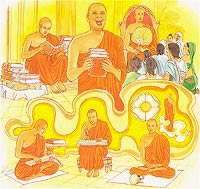 |
Verse 259. Those Who Know Speak Little
Explanation: One does not become an upholder of the Law of |
Dhammapada Verse 259
Ekudanakhinasava Vatthu
Na tavata dhammadharo
yavata bahu bhasati
yo ca appampi sutvana
dhammam kayena passati
sa ve dhammadharo hoti
yo dhammam nappamajjati.
Verse 259: He is not “one versed in the Dhamma (Dhammadhara)” just
because he talks much. He who hears only a little but comprehends the Dhamma,
and is not unmindful is, indeed, “one versed in the Dhamma”.
The Story of Ekudana the Arahat
While residing at the Jetavana monastery, the Buddha uttered Verse (259) of
this book, with reference to a bhikkhu who was an arahat.
This bhikkhu lived in a grove near Savatthi. He was known as Ekudana, because
he knew only one stanza of exultation (Udana) by heart. But the thera fully
understood the meaning of the Dhamma as conveyed by the stanza. On each sabbath
day, he would exhort others to listen to the Dhamma, and he himself would recite
the one stanza he knew. Every time he had finished his recitation, the guardian
spirits (devas) of the forests praised him and applauded him resoundingly. On
one sabbath day, two learned theras, who were well-versed in the Tipitaka,
accompanied by five hundred bhikkhus came to his place. Ekudana asked the two
theras to preach the Dhamma. They enquired if there were many who wished to
listen to the Dhamma in this out of the way place. Ekudana answered in the
affirmative and also told them that even the guardian spirits of the forests
usually came, and that they usually praised and applauded at the end of
discourses.
So, the two learned theras took turns to preach the Dhamma, but when their
discourses ended, there was no applause from the guardian spirits of the
forests. The two learned theras were puzzled; they even doubted the words of
Ekudana. But Ekudana insisted that the guardian spirits used to come and always
applauded at the end of each discourse. The two theras then pressed Ekudana to
do the preaching himself. Ekudana held the fan in front of him and recited the
usual stanza. At the end of the recitation, the guardian spirits applauded as
usual. The bhikkhus who had accompanied the two learned theras complained that
the devas inhabiting the forests were very partial.
They reported the matter to the Buddha on arrival at the Jetavana monastery.
To them the Buddha said. “Bhikkhus! I do not say that a bhikkhu who has
learnt much and talks much of the Dhamma is one who is versed in the Dhamma,
(Dhammadhara).” One who has learnt very little and knows only one stanza of
the Dhamma, but fully comprehends the Four Noble Truths, and is ever mindful is
the one who is truly versed in the Dhamma.”
Then the Buddha spoke in verse as follows:
| Verse 259: He is not “one versed in the Dhamma (Dhammadhara)” just because he talks much. He who hears only a little but comprehends the Dhamma, and is not unmindful is, indeed, “one versed in the Dhamma”. |
Minnesota
• Dharma Field Zen Center
http://en.wikipedia.org/wiki/Dharma_Field_Zen_Center
| Dharma Field | |
|---|---|
 |
|
| Native plants are used for water management | |
| Information | |
| Denomination | Sōtō Zen Buddhism |
| Founded | 1997 |
| Founder(s) | Steve Hagen |
| Teacher(s) | Bev Forsman, Steve Hagen, Norm Randolph, Lee Register |
| Address | 3118 West 49th Street Minneapolis, Minnesota 55410 (West 49th St & York Ave S) |
| Country | United States |
| Website | http://www.dharmafield.org/ |
Dharma Field Zen Center (Dharma Field Meditation and Learning Center) is a Zen Buddhist community that offers daily meditation, sesshins, Sunday morning Dharma talks, and a large web archive.[1]
A multi-year curriculum explores the foundation studies of Buddha, Nagarjuna, Dōgen, and the wisdom teachings of the Mahayana.[citation needed]
Senior Dharma teachers Steve Hagen and Norm Randolph are Dharma heirs of Dainin Katagiri. Head teacher Bev Forsman and Dharma teacher Lee Register are Dharma heirs of Steve Hagen.[citation needed]
Dharma Field is located in the former St. Andrew’s Lutheran Church in Minneapolis, Minnesota.[2]
Category:
3343 E Calhoun Pkwy(612) 822-5313
by fixednut
Selected for Google Earth [?] - ID: 14262155

| Minnesota Zen Meditation Center | |
|---|---|
| Information | |
| Denomination | Sōtō Zen Buddhism |
| Founded | 1972 |
| Founder(s) | Dainin Katagiri |
| Teacher(s) | Tim Burkett |
| Address | 3343 East Calhoun Parkway, Minneapolis, Minnesota 55408 |
| Country | United States |
| Website | http://mnzencenter.org |
Minnesota Zen Meditation Center was formed when the founding head teacher, Dainin Katagiri, (1928-1990) was invited to come from California in 1972 to teach a small but growing group of Minneapolis students interested in the dharma. After his death, Shohaku Okumura served as interim head teacher until the installation of Karen Sunna, who had studied with Katagiri Roshi until his death. Succeeding Karen as head priest is Tim Burkett, a long time student of both Katagiri and Suzuki Roshi. Tim became the head teacher on November 1, 2002.
Robert M. Pirsig, author of Zen and the Art of Motorcycle Maintenance, attended the Center for a period of time.
Natalie Goldberg studied at the Center for over a dozen years and writes extensively about it in her books Long Quiet Highway and The Great Failure.
GLA is home to a variety of species found primarily in the Great Lakes
Basin. Additional exhibits showcase animals from both freshwater and
marine habitats around the …
The Turnblad …
For awhile…
Hear the old steam locomotive puff and chug throughout the countryside.
Hear the puffing and chuggin…
Dhammapada Verse 258 Chabbaggiya Vatthu-Who Speaks A Lot Is Not Necessarily Wise
DN 22 - (D ii 290)
Mahāsatipaṭṭhāna Sutta
This sutta is widely considered as a the main reference for meditation practice.
|
|
|
Puna ca·paraṃ, bhikkhave, bhikkhu gacchanto vā ‘gacchāmī’ ti pajānāti, ṭhito vā ‘ṭhitomhī’ ti pajānāti, nisinno vā ‘nisinnomhī’ ti pajānāti, sayāno vā ‘sayānomhī’ ti pajānāti. Yathā yathā vā pan·assa kāyo paṇihito hoti, tathā tathā naṃ pajānāti. |
|
|
Iti ajjhattaṃ vā kāye kāyānupassī viharati, bahiddhā vā kāye kāyānupassī viharati, ajjhatta-bahiddhā vā kāye kāyānupassī viharati; samudaya-dhamm·ānupassī vā kāyasmiṃ viharati, vaya-dhamm·ānupassī vā kāyasmiṃ viharati, samudaya-vaya-dhamm·ānupassī vā kāyasmiṃ viharati; ‘atthi kāyo’ ti vā pan·assa sati paccupaṭṭhitā hoti, yāvadeva ñāṇa·mattāya paṭissati·mattāya,{1} a·nissito ca viharati, na ca kiñci loke upādiyati. Evam·pi kho, bhikkhave, bhikkhu kāye kāyānupassī viharati. |
|
இவ்வாறு அவர் kāya in kāya உடல்/காயத்தை காயதுக்குள் கண்காணி வாசம் செய்கிரார், அல்லது காயத்தை காயதுக்கு வெளியே கண்காணி வாசம் செய்கிரார், அல்லது காயத்தை காயதுக்கு உள்ளே மற்றும் வெளியே கண்காணி வாசம் செய்கிரார்;புலன்களால் உணரத்தக்க எழுச்சி கண்காணி வாசம் செய்கிரார், மற்றும் புலன்களால் உணரத்தக்கதை கடந்துசெல்லுவதை கண்காணித்து வாசம் செய்கிரார்; இல்லாவிடில் எச்சரிக்கையாயிருக்கிற உணர் உடனிருக்கிறதை,சும்மா வெறும் ஓர்அளவு ஞானம் மற்றும் ஓர்அளவு paṭissati என எண்ணி பற்றறு வாசம் செய்கிரார்
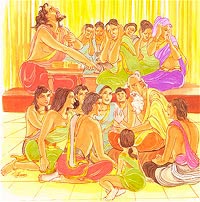
Just because articulate
one’s not thereby wise,
hateless, fearless and secure,
a ‘wise one’ thus is called.
Explanation: A person cannot be described as learned simply
because he speaks quite a lot. He who is liberated and secure, non-hating
and fearless is described as a learned person.
Dhammapada Verse 258
Chabbaggiya Vatthu
Na tena pandito hoti
yavata bahu bhasati
khemi averi abhayo
“pandito” ti pavuccati.
Verse 258: He is not a wise man just because he talks much; only he who is
peaceful, free from enmity, and does no harm to others, is to be called ‘a wise
man’.
The Story of a Group of Six Bhikkhus
While residing at the Jetavana monastery, the Buddha uttered Verse (258) of
this book, with reference to a group of six bhikkhus.
Once, there was a group of six bhikkhus who made trouble at the place of
eating either in the monastery or in the village. One day, while some samaneras
were, having their alms-food, the group of six bhikkhus came in and said
boastfully to the samaneras, “Look! We only are the wise.” Then they
started throwing things about, leaving the place of eating in disorder. When the
Buddha was told about this, he said, “Bhikkhus! I do not say that one
who talks much, abuses and bullies others is a wise man. Only he who is free
from hatred, and harms no one is a wise man.”
Then the Buddha spoke in verse as follows:
| Verse 258: He is not a wise man just because he talks much; only he who is peaceful, free from enmity, and does no harm to others, is to be called ‘a wise man’. |
Michigan
• Lake Superior Zendo
• Still Point Zen Buddhist Temple, Detroit
Lake Superior Zendo (LSV) is a Sōtō Zen Buddhist temple located in Marquette, Michigan. The zendo was founded in 1990 by Tesshin Paul Lemberg, who received Dharma transmission from Rev. Shoken Winecoff of Ryumonji Zen Monastery.[1] Lake Superior Zendo is informally affiliated with Northern Michigan University through the Presque Isle Zen Community[2] and participates in local interfaith events.[3]
http://www.rtbot.net/Lake_Superior_Zendo
http://en.wikipedia.org/wiki/Still_Point_Zen_Buddhist_Temple
Still Point Zen Buddhist Temple is located at 4347 Trumbull in Detroit, Michigan.
The community of Zen Buddhists welcomes people from all walks of life
and faiths to Sunday meetings, retreats and workshops. The temple was
founded by P’arang Geri Larkin. Her ordination on July 2, 1995 followed three years of Buddhist development at Maitreya Buddhist Seminary. She served as dharma teacher at the Zen Buddhist Temple in Ann Arbor, Michigan before founding Still Point Buddhist Temple. She was taught by Venerable Samu Sunim, a Korean Zen Master who has established several Buddhist temples in North America. Still Point Buddhist Temple traces its lineage to Korean Buddhism. The current guiding teacher of Still Point Zen Buddhist Temple is Koho Vince Anila. Koho is the 1st dharma successor of P’arang Geri Larkin, and was ordained in May 2003.

 The village
The village  transports
transportsDhammapada Verses 256 and 257 Vinicchayamahamatta Vatthu-Verse 256. The Just And The Impartial Judge Best-Verse 257. Firmly Rooted In The Law
 |
Verse 256. The Just And The Impartial Judge Best
Explanation: If for some reason someone were to judge what |
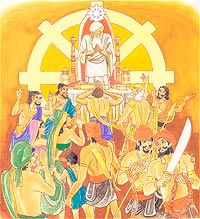 |
Verse 257. Firmly Rooted In The Law
Explanation: That wise person, who dispenses justice and judges |
Dhammapada Verses 256 and 257
Vinicchayamahamatta Vatthu
Na tena hoti dhammattho
yenattham sahasa naye
yo ca attham anatthanca
ubbo niccheyya pandito.
Asahasena dhammena
samena nayati pare
dhammassa gutto medhavi
“dhammattho” ti pavuccati.
Verse 256: He is not just if he decides a case arbitrarily; the wise
man should decide after considering both what is right and what is wrong.
Verse 257: The wise man who decides not arbitrarily but in accordance
with the law is one who safeguards the law; he is to be called ‘one who abides
by the law (dhammattho).’
The Story of the Judge
While residing at the Jetavana monastery, the Buddha uttered
Verses (256) and (257) of this book with reference to some judges who were
corrupt.
One day, some bhikkhus were returning from their round of alms-food when it
rained and they went into a law court to take shelter. While they were there,
they found out that some judges, having taken bribes, were deciding cases
arbitrarily. They reported the matter to the Buddha and the Buddha replied, “Bhikkhus!
In deciding cases, if one is influenced by affection or by monetary
consideration, he cannot be called ‘the just’, or ‘a judge who abides by the
law.’ If one weighs the evidence intelligently and decides a case impartially,
then he is to be called, ‘the just’ or ‘a judge who abides by the law.’”
Then the Buddha spoke in verse as follows:
|
Verse 256: He is not just if he decides a case |
|
Verse 257: The wise man who decides not |
Massachusetts
• Cambridge Zen Center
• Pioneer Valley Zendo
• Wat Boston Buddha Vararam
| Cambridge Zen Center | |
|---|---|
 |
|
| Dharma room at the Cambridge Zen Center | |
| Information | |
| Denomination | Zen |
| Founded | 1973 |
| Founder(s) | Zen Master Seung Sahn |
| Teacher(s) | Zen Master Bon Yeon Zen Master Bon Haeng |
| Director(s) | Barbara Feldman |
| Abbot(s) | Tom Johnson |
| Address | 199 Auburn Street, Cambridge, MA 02139 |
| Country | Cambridge, MA, United States |
| Website | www.cambridgezen.com |
Cambridge Zen Center is an urban meditation center in Cambridge, Massachusetts close to Harvard University, part of the Kwan Um School of Zen.
Free meditation training and dharma talks are offered to the public and
the Zen Center also provides a large (35-40 people) residential
training program.[1][2][3]
Pioneer Valley Zendo is a Soto Zen zendo established in 1976 in Charlemont, MA as a sister-temple to Antai-ji in Japan, where Kosho Uchiyama was roshi. Koshi Ichida, Eishin Ikeda and Shohaku Okumura were the zendo’s original founders, and the place was run by Reverend Issho Fujita (1954 - present) from 1987 until 2005. Eishin Ikeda, who had later been leading the Bean Town Sangha (founded by Eishin Ikeda and Michael Flessas)
whose first meetings where held on the second floor of a book store in
Arlington, Massachusetts and returned as the present resident priest in
2006.http://en.wikipedia.org/wiki/Wat_Boston_Buddha_Vararam
|
|
Wat Boston Buddha Vararam (Abbreviated BBVT) is a Thai Theravada Buddhist Temple or Wat located in Bedford, Massachusetts. It is one of two Thai Buddhist Temples in Massachusetts, the other being Wat Nawamintararachutis.
The main community at Wat Boston includes Thai and Laos.
Wat Boston Buddha Vararam was started as a small house in Malden, Massachusetts
by Phra Ajan Kitti, and now is expanded to 125 North Road, Bedford
Massachusetts. Phra Ajan Maha Kamolpetch Pinijkarn is the Abbot.
Unlike Wat Nawamintararachutis, Wat Boston is famous for the lack of
an Executive Buddhist Panel to decide all affairs of the temple.

|
|
 |
|
 |
|
 |
|
 |
|
 |
|
 |
|

Birthday parties, family fun, games, rides, food court, redemption prizes, air conditioned….. A great place for kids!
Birthday party packages, wristbands, family packs six major indoor
rides…… Bumper Cars, Carousel, Road Yard, Airport, Space Train,
Ferris Wheel and Soft play…….. Newly added kiddies tent with rides
for little people ( 18 months and up ), group rates…
Press the stars above for more information!

1300 FALL RIVER AVENUE
RT. 6 SEEKONK, MA. 02771
phone 508 336 6262
fax 508 336 5721
We book birthday parties daily!
Mon - Fri 9:30 am to 3 pm
Sat & Sun 10 am to 8 pm
17 07 2012 MONDAY LESSON 670 FREE ONLINE eNālāndā Research and Practice UNIVERSITY![]() T
T
ipitaka network … his life, his acts, his words
sabbe satta bhavantu sukhi-tatta
TIPITAKA
TIPITAKA AND TWELVE DIVISIONS
Brief historical background
Sutta Pitaka
Vinaya Pitaka
Abhidhamma Pitaka
Twelve Divisions of Buddhist Canons
Nine Divisions of Buddhist Canons
Sutta Piṭaka
— The basket of discourses —Mahāsatipaṭṭhāna Sutta (DN 22) {excerpt} - all infobubbles— Attendance on awareness —Kāyānupassanā
Dhammapada Verse 254-and 255 Subhaddaparibbajaka Vatthu-Verse 254. Nothing Is Eternal Other Than Nibbana-Verse 255. The Buddha Has No Anxiety
ALL ABOUT AWAKEN ONES WITH AWARENESS USA
Maryland
• Kunzang Palyul Choling
This sutta is widely considered as a the main reference for meditation practice.
Seyyathāpi, bhikkhave, dakkho bhamakāro vā bhamakār·antevāsī vā dīghaṃ vā añchanto ‘dīghaṃ añchāmī‘ ti pajānāti; rassaṃ vā añchanto ‘rassaṃ añchāmī‘ ti pajānāti; evameva kho, bhikkhave, bhikkhu dīghaṃ vā assasanto ‘dīghaṃ assasāmī‘ ti pajānāti; dīghaṃ vā passasanto ‘dīghaṃ passasāmī‘ ti pajānāti; rassaṃ vā assasanto ‘rassaṃ assasāmī‘ ti pajānāti; rassaṃ vā passasanto ‘rassaṃ passasāmī‘ ti pajānāti;
‘sabba-kāya-paṭisaṃvedī assasissāmī‘ ti sikkhati; ‘sabba-kāya-paṭisaṃvedī passasissāmī‘ ti sikkhati; ‘passambhayaṃ kāya-saṅkhāraṃ assasissāmī‘ ti sikkhati; ‘passambhayaṃ kāya-saṅkhāraṃ passasissāmī‘ ti sikkhati.
தமிழ்
சம்மதம்படி,பிக்குக்களுக்களே,திறமை கடைசல்காரர் அல்லது கடைசல்காரின் தொழில் பழகுநர், ஒரு நீளமான சுழற்றுதல் உருவாக்குதல் குறிப்பறிது: ‘நான் நீளமான சுழற்றுதல் உருவாக்குகிறேன்’;ஒரு குறைவான சுழற்றுதல் உருவாக்குதல் குறிப்பறிது: ‘நான் குறைவான சுழற்றுதல் உருவாக்குகிறேன்’;அவ்வழி,பிக்குக்களுக்களே,ஒரு பிக்கு,மூச்சு நீண்டதாக உள்ளே செலுத்தும்போது: நான் நீண்டதாக உள்ளே செலுத்துககின்றேன் என அறிகிரார்.மூச்சு நீண்டதாக வெளியே செலுத்தும்போது: நான் நீண்டதாக வெளியே செலுத்துககின்றேன் என அறிகிரார்.மூச்சு குறைவாக உள்ளே செலுத்தும்போது: நான் குறைவாக உள்ளே செலுத்துககின்றேன் என அறிகிரார்.மூச்சு குறைவாக வெளியே செலுத்தும்போது:நான் குறைவாக வெளியே செலுத்துககின்றேன் என அறிகிரார்.அவர் தானே பயிற்சித்துகொள்கிரார்: முழு kāya உடலை/காயாவையும் கூருணர்ச்சியுடன்,நான் மூச்சை உள்ளே செலுத்துககின்றேன்:அவர் தானே பயிற்சித்துகொள்கிரார்:முழு kāya உடலை/காயாவையும் கூருணர்ச்சியுடன்,நான் மூச்சை வெளியே செலுத்துககின்றேன்:அவர் தானே பயிற்சித்துகொள்கிரார்: kāya-saṅkhāras உடல்/காயா இச்சாசத்தியை அமைதி உண்டாக்கொண்டு.நான் மூச்சை உள்ளே செலுத்துககின்றேன்:அவர் தானே பயிற்சித்துகொள்கிரார்:,நான் மூச்சை வெளியே செலுத்துககின்றேன்:அவர் தானே பயிற்சித்துகொள்கிரார்:
Please watch:
http://www.youtube.com/watch?v=oLel1sMDpEM&list=LPWCeFjm-hYPo&index=1&feature=plcp
for
Buddhism, Meditation Nature & Water - Sublime,Inspiring Buddha Quotes HD Secret Jungle Temple
http://www.youtube.com/watch?v=ym9SEiP55O4&feature=autoplay&list=LPWCeFjm-hYPo&playnext=1
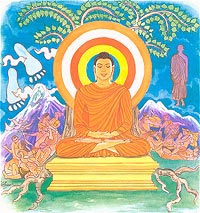
Verse 254. Nothing Is Eternal Other Than Nibbana
Explanation: In the skies, there are no footsteps that can |
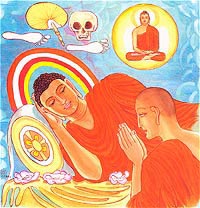 |
Verse 255. The Buddha Has No Anxiety
Explanation: In the skies, there is no footsteps that can |
Dhammapada Verses 254 and 255
Subhaddaparibbajaka VatthuAkaseva padam natthi
samano natthi bahire
papancabhirata paja
nippapanca tathagata.Akaseva padam natthi
samano natthi bahire
sankhara sassatta natthi
natthi buddhanaminjitam.Verse 254: In the sky there is no track; outside the Buddha’s Teaching there
is no ariya bhikkhu (samana). All beings take delight in fetters (i.e., craving,
pride and wrong view) that prolong samsara; all the Buddhas are free from these
fetters.Verse 255: In the sky there is no track; outside the Buddha’s Teaching there
is no ariya bhikkhu (samana). There is no conditioned thing that is permanent;
all the Buddhas are unperturbed (by craving, pride and wrong view).
The Story of Subhadda the Wandering Ascetic
Verses (254) and (255) of this book were uttered by the Buddha in the Sal
Grove of the Malla princes near Kusinara, just before the parinibbana (passing
away) of the Buddha, in reply to the questions raised by Subhadda, the wandering
ascetic (paribbajaka).Subhadda the wandering ascetic was staying at Kusinara when he heard that the
parinibbana of Gotama Buddha would take place in the last watch of that night.
Subhadda had three questions which had been troubling him for a long time. He
had already put these questions to other religious leaders, namely, Purana
Kassapa, Makkhali Gosala, Ajita Kesakambala, Pakudha Kaccayana, Sancaya
Belatthaputta and Nigantha Nataputta, but their answers did not satisfy him. He
had not yet asked Gotama Buddha, and he felt that only the Buddha could answer
his questions. So, he hurried off to the Sal Grove, but the Venerable Ananda did
not allow him to see the Buddha, because the Buddha was by that time very weak.
The Buddha overheard their conversation and consented to see Subhadda. Subhadda
asked three questions. They are: (1) Are there any tracks in the sky? (2) Are
there any ariya bhikkhus (samanas) outside the Teaching of the Buddha? and (3)
Is there any conditioned thing (sankhara) that is permanent? The Buddha’s answer
to all the above questions was negative.Then the Buddha spoke in verse as follows:
Verse 254: In the sky there is no track; outside
the Buddha’s Teaching there is no ariya bhikkhu (samana). All beings
take delight in fetters (i.e., craving, pride and wrong view) that
prolong samsara; all the Buddhas are free from these fetters.Verse 255: In the sky there is no track; outside
the Buddha’s Teaching there is no ariya bhikkhu (samana). There is no
conditioned thing that is permanent; all the Buddhas are unperturbed
(by craving, pride and wrong view).
At the end of the discourse Subhadda attained Anagami Fruition and as
requested by him the Buddha admitted him to the Order of the bhikkhus. Subhadda
was the last one to become a bhikkhu in the life time of the Buddha. Eventually,
Subhadda attained arahatship.End of Chapter Eighteen: Impurities
Maryland
• Kunzang Palyul Choling
http://en.wikipedia.org/wiki/Kunzang_Palyul_Choling
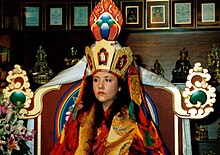
Jetsunma Ahkon Lhamo: first Western woman to be recognized as an incarnate Lama.
Kunzang Palyul Choling (KPC) is a center for Buddhist study and practice in the Nyingma tradition (Palyul lineage). Founded as the Center for Discovery and New Life in 1985, and then given to His Holiness Penor Rinpoche and renamed by him in 1987, KPC was Penor Rinpoche’s first Dharma Center in the US.![]()
PLEASE VISIT:
Indoor Golf Open Year Round on 68th St.
Fun for the whole family.
Don’t forget our 2 family arcades at our 68th …
Homegrown fun and farm fresh…
16 07 2012 MONDAY LESSON 669 FREE ONLINE eNālāndā Research and Practice UNIVERSITY![]() T
T
ipitaka network … his life, his acts, his words
sabbe satta bhavantu sukhi-tatta
TIPITAKA
TIPITAKA AND TWELVE DIVISIONS
Brief historical background
Sutta Pitaka
Vinaya Pitaka
Abhidhamma Pitaka
Twelve Divisions of Buddhist Canons
Nine Divisions of Buddhist Canons
Sutta Piṭaka
— The basket of discourses —Mahāsatipaṭṭhāna Sutta (DN 22) {excerpt} - all infobubbles— Attendance on awareness —Kāyānupassanā
Dhammapada Verse 253-Ujjhanasannitthera Vatthu-Seeing Others’ Faults
ALL ABOUT USA
Louisiana
• New Orleans Zen Temple
This sutta is widely considered as a the main reference for meditation practice.
And how, bhikkhus, does a bhikkhu dwell observing kāya in kāya? Here, bhikkhus, a
bhikkhu, having gone to the forest or having gone at the root of a tree
or having gone to an empty room, sits down folding the legs crosswise,
setting kāya upright, and setting sati parimukhaṃ.
Katha·ñ·ca, bhikkhave, bhikkhu kāye kāyānupassī viharati? Idha, bhikkhave, bhikkhu arañña-gato vā rukkha-mūla-gato vā suññ‘āgāra-gato vā nisīdati pallaṅkaṃ ābhujitvā ujuṃ kāyaṃ paṇidhāya parimukhaṃ satiṃ upaṭṭhapetvā. So sato‘va assasati, sato‘va passasati. Dīghaṃ vā assasanto ‘dīghaṃ assasāmī‘ ti pajānāti; dīghaṃ vā passasanto ‘dīghaṃ passasāmī‘ ti pajānāti; rassaṃ vā assasanto ‘rassaṃ assasāmī‘ ti pajānāti; rassaṃ vā passasanto ‘rassaṃ passasāmī‘ ti pajānāti;
‘sabba-kāya-paṭisaṃvedī assasissāmī‘ ti sikkhati; ‘sabba-kāya-paṭisaṃvedī passasissāmī‘ ti sikkhati; ‘passambhayaṃ kāya-saṅkhāraṃ assasissāmī‘ ti sikkhati; ‘passambhayaṃ kāya-saṅkhāraṃ passasissāmī‘ ti sikkhati.
thus sato he breathes in, being thus sato he breathes out. Breathing in
long he understands: ‘I am breathing in long’; breathing out long he
understands: ‘I am breathing out long’; breathing in short he
understands: ‘I am breathing in short’; breathing out short he
understands: ‘I am breathing out short’; he
trains himself: ‘feeling the whole kāya, I will breathe in’; he trains
himself: ‘feeling the whole kāya, I will breathe out’; he trains
himself: ‘calming down the kāya-saṅkhāras, I will breathe in’; he trains
himself: ‘calming down the kāya-saṅkhāras, I will breathe out’.
தமிழ்
மற்றும் எப்படி,பிக்குக்களுக்களா,kāya in kāya (உடலில் உடலை கவனித்து வசிக்கிரார்? இங்கு பிக்குக்களுக்களா,ஒரு பிக்கு,காட்டுக்குச் சென்றோ அல்லது மரத்தடிக்குச் சென்றோ அல்லது காலி அறைகுச் சென்றோ,காலை குறுக்காக கீழ்நோக்கி மடித்துக்கொண்டு அமர்கிரார்,உடலை செங்குத்தாக சரிசெய்துக்கொண்டு,மற்றும் sati parimukhaṃ. மூச்சு உள்ளே அல்லது வெளியே சரிசெய்துக்கொள்கிரார். sato இவ்வாறு கவனமான மூச்சு உள்ளே அல்லது வெளியே செலுத்துகிரார். மூச்சு நீண்டதாக உள்ளே செலுத்தும்போது: நான் நீண்டதாக உள்ளே செலுத்துககின்றேன் என அறிகிரார்.மூச்சு நீண்டதாக வெளியே செலுத்தும்போது: நான் நீண்டதாக வெளியே செலுத்துககின்றேன் என அறிகிரார்.மூச்சு குறைவாக உள்ளே செலுத்தும்போது: நான் குறைவாக உள்ளே செலுத்துககின்றேன் என அறிகிரார்.மூச்சு குறைவாக வெளியே செலுத்தும்போது:நான் குறைவாக வெளியே செலுத்துககின்றேன் என அறிகிரார்.அவர் தானே பயிற்சித்துகொள்கிரார்: முழு kāya உடலை/காயாவையும் கூருணர்ச்சியுடன்,நான் மூச்சை உள்ளே செலுத்துககின்றேன்:அவர் தானே பயிற்சித்துகொள்கிரார்:முழு kāya உடலை/காயாவையும் கூருணர்ச்சியுடன்,நான் மூச்சை வெளியே செலுத்துககின்றேன்:அவர் தானே பயிற்சித்துகொள்கிரார்: kāya-saṅkhāras உடல்/காயா இச்சாசத்தியை அமைதி உண்டாக்கொண்டு.நான் மூச்சை உள்ளே செலுத்துககின்றேன்:அவர் தானே பயிற்சித்துகொள்கிரார்:,நான் மூச்சை வெளியே செலுத்துககின்றேன்:அவர் தானே பயிற்சித்துகொள்கிரார்:
 |
Verse 253. Seeing Others’ Faults
Explanation: There are those who are given to the habit of |
Dhammapada Verse 253
Ujjhanasannitthera Vatthu
Paravajjanupassissa
niccam ujjhanasannino
asava tassa vaddhanti
ara so asavakkhaya.
Verse 253: In one who constantly sees the faults of others and is always
disparaging them, moral intoxicants (asavas) increase; he is far from extinction
of moral intoxicants (i.e., he is far from attainment of arahatship).
The Story of Thera Ujjhanasanni
While residing at the Jetavana monastery, the Buddha uttered Verse (253) of
this book, with reference to Thera Ujjhanasanni.
Thera Ujjhanasanni was always finding fault with and speaking ill of others.
Other bhikkhus reported about him to the Buddha. The Buddha replied to them,
“Bhikkhus, if someone finds fault with another so as to teach him in good
way; it is not an act of evil and is therefore not to be blamed. But, if someone
is always finding fault with others and speaking ill of them just out of spite
and malice, he will not attain concentration and mental absorption (jhana). He
will not be able to understand the Dhamma, and moral (intoxicants asavas) will
increase in him.”
| Verse 253: In one who constantly sees the faults of others and is always disparaging them, moral intoxicants (asavas) increase; he is far from extinction of moral intoxicants (i.e., he is far from attainment of arahatship). Louisiana Images for pictures of The New Orleans Zen Temple- Report images   Zoo Zoo
“/> “/>
|

15 07 2012 SUNDAY LESSON 668 FREE ONLINE eNālāndā Research and Practice UNIVERSITY
TIPITAKA
TIPITAKA AND TWELVE DIVISIONS
Brief historical background
Sutta Pitaka
Vinaya Pitaka
Abhidhamma Pitaka
Twelve Divisions of Buddhist Canons
Nine Divisions of Buddhist Canons
Sutta Piṭaka
— The basket of discourses —Mahāsatipaṭṭhāna Sutta (DN 22) {excerpt} - all infobubbles— Attendance on awareness —
Dhammapada Verse 252-Mendakasetthi Vatthu-Easy To See Are The Faults Of Others
ALL ABOUT USA
Kentucky
This sutta is widely considered as a the main reference for meditation practice.
Katame cattāro? Idha, bhikkhave, bhikkhu kāye kāyānupassī viharati ātāpī sampajāno satimā, vineyya loke abhijjhā-domanassaṃ. Vedanāsu vedanānupassī viharati ātāpī sampajāno satimā, vineyya loke abhijjhā-domanassaṃ. Citte cittānupassī viharati ātāpī sampajāno satimā, vineyya loke abhijjhā-domanassaṃ. Dhammesu dhammānupassī viharati ātāpī sampajāno satimā, vineyya loke abhijjhā-domanassaṃ.
எந்த நான்கு?இங்கு பிக்குக்களுக்களா,ஒரு பிக்கு kāye kāyānupassī (உடலை உடல் கண்காணிப்புடன்) கவனித்து வசிக்கிரார் ātāpī sampajāno satimā,வேறு வழியில்லாமல் பிரபஞ்சம் நோக்கி எச்சரிக்கையுடன் இருக்க ஏகாந்தமாயிருக்கிரார்.வேறு வழியில்லாமல் பிரபஞ்சம் நோக்கி எச்சரிக்கையுடன் இருக்க ஏகாந்தமாயிருக்க Vedanāsu vedanānupassī உறுதலுணர்ச்சி கண்காணிப்புடன் வசிக்கிரார்.வேறு வழியில்லாமல் பிரபஞ்சம் நோக்கி எச்சரிக்கையுடன் இருக்க ஏகாந்தமாயிருக Citte cittānupassī viharati ātāpī sampajāno satimā, சித்த நலம் கருதி ண்காணிப்புடன் வசிக்கிரார். மனத்தால் இயக்கப்படுகிற அபூர்வமான வினயா(ஒழுக்கம்) காக்க வேறு வழியில்லாமல் பிரபஞ்சம் நோக்கி எச்சரிக்கையுடன் இருக்க ஏகாந்தமாயிருக்க கண்காணிப்புடன் வசிக்கிரார்.
Watch:
http://records.photodharma.net/photos/sandamuni-pagoda-mandalay
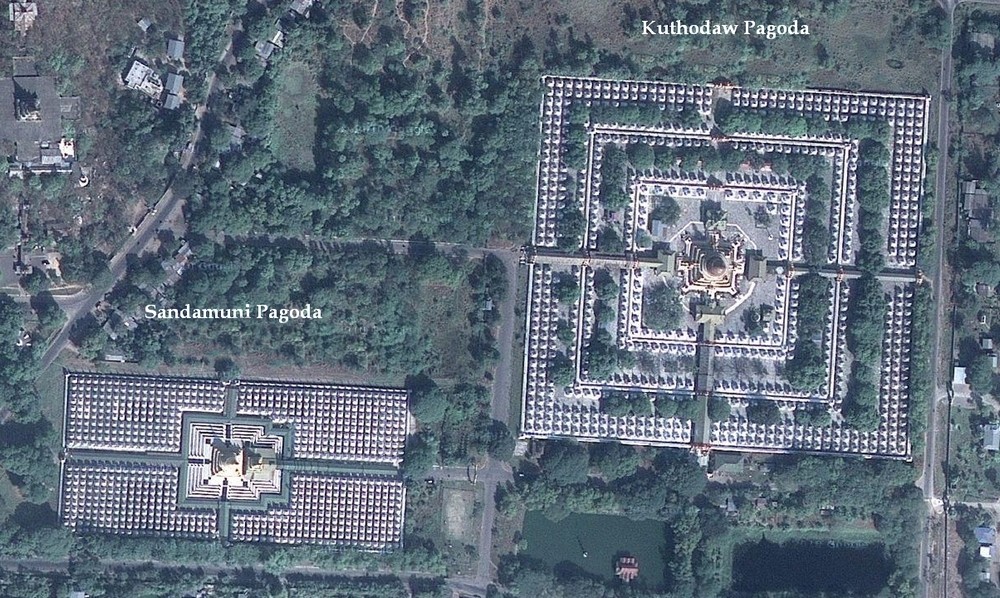
The history of the Pagoda is written up in stone in the compound and
here is a transcript (slightly corrected for spelling and diction):
Nanmyaebonthar Sannandawya Sandamuni Pagoda
1. On the full moon day of Nayon in M.E. 1229 [C.E. 1867] King Mindon
dismantled the temporary palace called Nanmyaebonthar and built a 100ft
pagoda in its place.King Badon, the grandfather of King Mindon had a Buddhist statue cast
at Mingun. That image was made of 11,368 viss of iron and was entitled
“Sandamuni”, which means the image is graceful like the full moon.It was moved from Amarapura and enshrined in the present [Sandamuni]
Pagoda. That’s why it is entitled Nanmyaebonthar Sannandawya Sandamuni
Pagoda meaning the pagoda as graceful as a fullmoon in the place of the
Nanmyaebonthar Palace.2. In M.E. 1275 [C.E. 1913], in the compound of Sandamuni Pagoda,
Venerable Hermit U Khanti managed to inscribe Sutta, Vinaya and
Abhidhamma from [the] Tipitaka with [a] complete explanation (Atthakatha
and Tika) on 1772 stone slabs and a historical record was [also]
inscribed on an iron sheet and a stone slab.3. These stone slabs are:
- (a) Vinaya Pitaka – 395 slabs
- (b) Sutta Pitaka – 1207 slabs
- (c) Abhidhamma Pitaka – 170 slabs
4. In [a] seven acre … compound there are:
- 248 pagodas housing a single slab each
- 139 pagodas housing three slabs each
- 72 eight-unit pagodas housing three slabs each,
which altogether contains 891 slabs, and
297 four-pillared pagodas housing three slabs each which contain 891 slabs.
All these pagodas are made of brick and called Dhammazedis. These pagodas contain records of [the] Buddha’s teachings.

Atthakatha Slabs
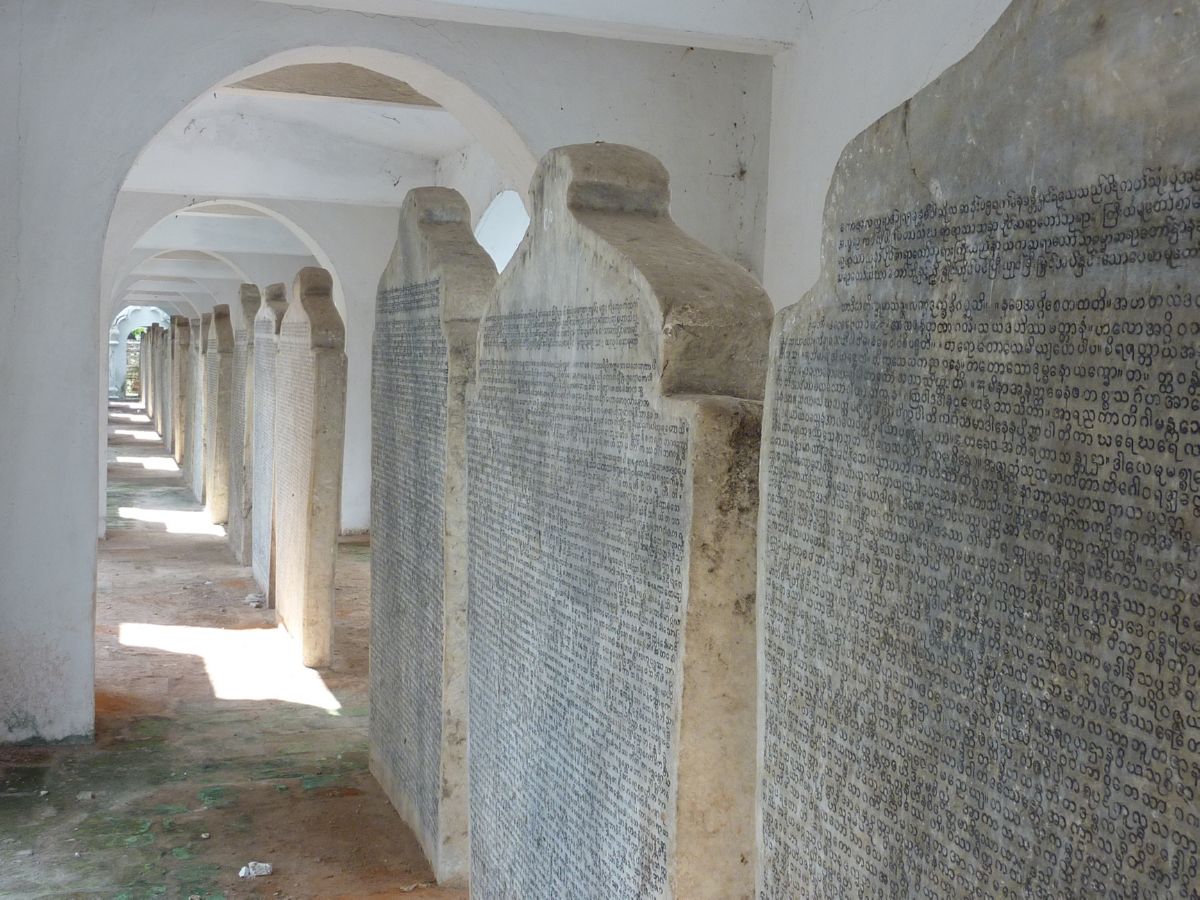
Atthakatha Slabs

Atthakatha Slab

Atthakatha Chedis

Atthakatha Chedis

Atthakatha Chedis
One thing that needs to be mentioned is that both the pagodas are
littered throughout, and there seems to be no proper maintenance
programme, and it struck me that maybe it is felt that, whereas there is
great merit in building these places, there is no merit in keeping them
clean.
But it is really striking to see such wonderful works as those at the
Kuthodaw and Sandamuni Pagodas, which hold the most sacred scriptures
of the tradition standing in a pile of rubbish, along with ciggie-buts,
betel-spit and all the rest of it. When walking around the small pagodas
one has to tread gingerly, because it’s not clear what one might be
putting one’s foot down on.
Surely it cannot be beyond the wit of the authorities of the
respective temples to see that a proper cleaning programme would not
only pay respect to the Dhamma, but would also go to find employment for
those who might be otherwise unemployed, or under-employed.
http://www.youtube.com/watch?v=hqA7hHpIUFI&feature=plcp

Other’s faults are easy to see
yet hard it is to see one’s own,
and so one winnows just like chaff
the faults of other people, while
hiding away those of one’s own
as crafty cheat the losing throw.
Explanation: The faults of others are clearly observed. But
one’s own faults are difficult to see. A person winnows the fault
of others into prominence, like chaff. He hides his own like the bird-hunter
who conceals himself with leaves and twigs.
Dhammapada Verse 252
Mendakasetthi Vatthu
Sudassam vajjamannesam
attano pana duddsam
paresam hi so vajjani
opunati yatha bhusam
attano pana chadeti
kalimva kitava satho.1
Verse 252: It is easy to see the faults of others, but difficult to see one’s
own. A man broadcasts the fault; of others like winnowing chaff in the wind, but
hides his own faults as a crafty fowler covers himself.
1. Satho: a cheat, a gambler. According to the Commentary, it means a crafty
fowler.
The Story of Mendaka the Rich Man
While residing near the town of Baddiya, the Buddha uttered Verse (252) of
this book with reference to the renowned rich man Mendaka and his family.
Once, during his tour of Anga and Uttara regions, the Buddha saw in his
vision that time was ripe for Mendaka, his wife, his son, his daughter-in-law,
his granddaughter and his servant, to attain Sotapatti Fruition. Seeing the
prospect of these six people attaining Sotapatti Fruition, the Buddha went to
the town of Baddiya.
Mendaka was an extremely rich man. It was said that he found a large number
of life-size golden statues of goats in his backyard. For this reason, he was
known as Mendaka (a goat) the rich man. Again, it was also said that during the
time of Vipassi Buddha he had donated a monastery for Vipassi Buddha and a
congregation hall complete with a platform for the preacher. On completion of
these buildings he made offerings of alms-food to Vipassi Buddha and the
bhikkhus for four months. Then, in yet another of his past existences, when he
was a rich man in Baranasi, there was a famine throughout the region. One day,
they had cooked a meal just enough for the members of the family when a
paccekabuddha stood at the door for alms-food. Then and there he offered all the
food. But due to his great faith and generosity, the rice pot was later found to
be miraculously filled up again; so also were his granaries.
Mendaka and his family, hearing that the Buddha was coming to Baddiya, went
to pay homage to him. After hearing the discourse given by the Buddha, Mendaka,
his wife Candapaduma, his son Danancaya, his daughter-in-law Sumanadevi, his
granddaughter Visakha and the servant Punna attained Sotapatti Fruition. Mendaka
then told the Buddha how on his way, some ascetics had spoken ill of the Buddha
and had tried to dissuade him from coming to see him. The Buddha then said, “My
disciple, it is natural for people not to see one’s own faults, and to
exaggerate other people’s faults and failings.”
Then the Buddha spoke in verse as follows:
| Verse 252: It is easy to see the faults of others, but difficult to see one’s own. A man broadcasts the fault; of others like winnowing chaff in the wind, but hides his own faults as a crafty fowler covers himself. |
| Furnace Mountain | |
|---|---|
 |
|
| The Tea House at Furnace Mountain. For group retreats the Tea House has sleeping quarters, showers and bathrooms, a kitchen and eating tables. |
|
| Information | |
| Denomination | Zen Buddhism |
| Founded | 1986 |
| Founder(s) | Dae Gak Soen Sa Nim Seung Sahn Soen Sa Nim |
| Abbot(s) | Dae Gak |
| Address | P.O. Box 545, Clay City, Kentucky 40312 |
| Country | United States |
| Website | http://www.furnacemountain.org/fm.html |
Furnace Mountain (temple name Kwan Se Um San Ji Sah) is an American Zen Buddhist retreat center in Clay City, Kentucky, co-founded in 1986 by Seung Sahn Soen Sa Nim and Dae Gak Soen Sa Nim as part of the international Kwan Um School of Zen;
it is now unaffiliated with the school in an official capacity. In 1990
the main Meditation Hall was completed, and in 1994 the temple was
constructed and opened. Kwan Se Um San Ji Sah is modeled after a
traditional Korean Buddhist Temple—located on 850 acres (263 ha) of woods in part of The Daniel Boone National Forest (in The Red River Gorge area). It is made of timber from the surrounding area (particularly Douglas fir siding and wood flooring). The exact site of Kwan Se Um San Ji Sah was determined by the use of geomantic divination, which was intended to help foster harmony. The Abbott and guiding teacher is Dae Gak Zen Master., 106[1][2][3]
All About Kentucky |
|
Kentucky Government |
|
Kentucky Civics for Kids |
|
|
|
|||
Games, Activities, and Contests |
|
Resources and Links |
|
Office of the Secretary of State |
|
|
|
| Greeting from Secretary of State Alison Lundergan Grimes |
Welcome
to the Office of the Secretary of State Kids’ website! This site is
designed to help Kentuckians of all ages understand and participate in
government and the civic process. You can navigate to specific sections
of our site by scrolling down and clicking on the corresponding picture
or by choosing a section on the side bar. Throughout the site you
will find information on the Commonwealth of Kentucky, state government,
civics, and even a section with games and contests sponsored by the
Kentucky Secretary of State. Students, parents, and educators should
visit the resources and links section for a list of educational and fun
resources relating to government and civics.
For more information about the Kentucky Office of the
Secretary of State visit our site by clicking on the picture below.
Again, thank you for visiting the Secretary of State’s Kids’ website!
Sincerely,
Alison Lundergan Grimes
Secretary of State
ALL ABOUT USA-Illinois

TO

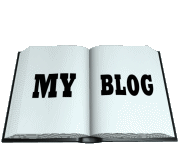



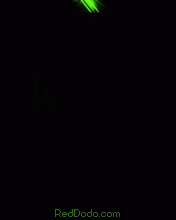
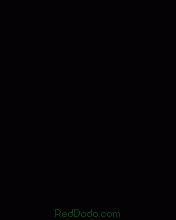


This sutta is widely considered as a the main reference for meditation practice.
PāḷiUddesa
|
EnglishIntroduction
|
|
|
|
Ekaṃ samayaṃ bhagavā kurūsu viharati kammāsadhammaṃ nāma kurūnaṃ nigamo. Tatra kho bhagavā bhikkhū āmantesi: |
|
|
– Bhaddante ti te bhikkhū bhagavato paccassosuṃ. Bhagavā etad-avoca: |
– Bhaddante answered the bhikkhus. The Bhagavā said: |
|
– |
– This, bhikkhus, is the path that leads to nothing but the purification |
|
Katame cattāro? Idha, bhikkhave, bhikkhu kāye kāyānupassī viharati ātāpī sampajāno satimā, vineyya loke abhijjhā-domanassaṃ. Vedanāsu vedanānupassī viharati ātāpī sampajāno satimā, vineyya loke abhijjhā-domanassaṃ. Citte cittānupassī viharati ātāpī sampajāno satimā, vineyya loke abhijjhā-domanassaṃ. Dhammesu dhammānupassī viharati ātāpī sampajāno satimā, vineyya loke abhijjhā-domanassaṃ. |
|
Katha·ñ·ca, bhikkhave, bhikkhu kāye kāyānupassī viharati? Idha, bhikkhave, bhikkhu arañña-gato vā rukkha-mūla-gato vā suññ‘āgāra-gato vā nisīdati pallaṅkaṃ ābhujitvā ujuṃ kāyaṃ paṇidhāya parimukhaṃ satiṃ upaṭṭhapetvā. So sato‘va assasati, sato‘va passasati. Dīghaṃ vā assasanto ‘dīghaṃ assasāmī‘ ti pajānāti; dīghaṃ vā passasanto ‘dīghaṃ passasāmī‘ ti pajānāti; rassaṃ vā assasanto ‘rassaṃ assasāmī‘ ti pajānāti; rassaṃ vā passasanto ‘rassaṃ passasāmī‘ ti pajānāti; ‘sabba-kāya-paṭisaṃvedī assasissāmī‘ ti sikkhati; ‘sabba-kāya-paṭisaṃvedī passasissāmī‘ ti sikkhati; ‘passambhayaṃ kāya-saṅkhāraṃ assasissāmī‘ ti sikkhati; ‘passambhayaṃ kāya-saṅkhāraṃ passasissāmī‘ ti sikkhati. |
|
|
Seyyathāpi, bhikkhave, dakkho bhamakāro vā bhamakār·antevāsī vā dīghaṃ vā añchanto ‘dīghaṃ añchāmī‘ ti pajānāti; rassaṃ vā añchanto ‘rassaṃ añchāmī‘ ti pajānāti; evameva kho, bhikkhave, bhikkhu dīghaṃ vā assasanto ‘dīghaṃ assasāmī‘ ti pajānāti; dīghaṃ vā passasanto ‘dīghaṃ passasāmī‘ ti pajānāti; rassaṃ vā assasanto ‘rassaṃ assasāmī‘ ti pajānāti; rassaṃ vā passasanto ‘rassaṃ passasāmī‘ ti pajānāti; ‘sabba-kāya-paṭisaṃvedī assasissāmī‘ ti sikkhati; ‘sabba-kāya-paṭisaṃvedī passasissāmī‘ ti sikkhati; ‘passambhayaṃ kāya-saṅkhāraṃ assasissāmī‘ ti sikkhati; ‘passambhayaṃ kāya-saṅkhāraṃ passasissāmī‘ ti sikkhati. |
|
|
Iti ajjhattaṃ vā kāye kāyānupassī viharati, bahiddhā vā kāye kāyānupassī viharati, ajjhatta-bahiddhā vā kāye kāyānupassī viharati; samudaya-dhamm·ānupassī vā kāyasmiṃ viharati, vaya-dhamm·ānupassī vā kāyasmiṃ viharati, samudaya-vaya-dhamm·ānupassī vā kāyasmiṃ viharati; ‘atthi kāyo’ ti vā pan·assa sati paccupaṭṭhitā hoti, yāvadeva ñāṇa·mattāya paṭissati·mattāya,{1} a·nissito ca viharati, na ca kiñci loke upādiyati. Evam·pi kho, bhikkhave, bhikkhu kāye kāyānupassī viharati. |
|
Puna ca·paraṃ, bhikkhave, bhikkhu gacchanto vā ‘gacchāmī’ ti pajānāti, ṭhito vā ‘ṭhitomhī’ ti pajānāti, nisinno vā ‘nisinnomhī’ ti pajānāti, sayāno vā ‘sayānomhī’ ti pajānāti. Yathā yathā vā pan·assa kāyo paṇihito hoti, tathā tathā naṃ pajānāti. |
|
|
Iti ajjhattaṃ vā kāye kāyānupassī viharati, bahiddhā vā kāye kāyānupassī viharati, ajjhatta-bahiddhā vā kāye kāyānupassī viharati; samudaya-dhamm·ānupassī vā kāyasmiṃ viharati, vaya-dhamm·ānupassī vā kāyasmiṃ viharati, samudaya-vaya-dhamm·ānupassī vā kāyasmiṃ viharati; ‘atthi kāyo’ ti vā pan·assa sati paccupaṭṭhitā hoti, yāvadeva ñāṇa·mattāya paṭissati·mattāya,{1} a·nissito ca viharati, na ca kiñci loke upādiyati. Evam·pi kho, bhikkhave, bhikkhu kāye kāyānupassī viharati. |
|
Puna ca·paraṃ, bhikkhave, bhikkhu abhikkante paṭikkante sampajānakārī hoti, ālokite vilokite sampajānakārī hoti, samiñjite pasārite sampajānakārī hoti, saṅghāṭi-patta-cīvara-dhāraṇe sampajānakārī hoti, asite pīte khāyite sāyite sampajānakārī hoti, uccāra-passāva-kamme sampajānakārī hoti, gate ṭhite nisinne sutte jāgarite bhāsite tuṇhībhāve sampajānakārī hoti. |
|
|
Iti ajjhattaṃ vā kāye kāyānupassī viharati, bahiddhā vā kāye kāyānupassī viharati, ajjhatta-bahiddhā vā kāye kāyānupassī viharati; samudaya-dhamm·ānupassī vā kāyasmiṃ viharati, vaya-dhamm·ānupassī vā kāyasmiṃ viharati, samudaya-vaya-dhamm·ānupassī vā kāyasmiṃ viharati; ‘atthi kāyo’ ti vā pan·assa sati paccupaṭṭhitā hoti, yāvadeva ñāṇa·mattāya paṭissati·mattāya,{1} a·nissito ca viharati, na ca kiñci loke upādiyati. Evam·pi kho, bhikkhave, bhikkhu kāye kāyānupassī viharati. |
|
Puna ca·paraṃ, bhikkhave, bhikkhu imam·eva kāyaṃ, uddhaṃ pādatalā adho kesa·matthakā, taca·pariyantaṃ pūraṃ nānappakārassa asucino paccavekkhati: ‘Atthi imasmiṃ kāye kesā lomā nakhā dantā taco maṃsaṃ nhāru aṭṭhi aṭṭhimiñjaṃ vakkaṃ hadayaṃ yakanaṃ kilomakaṃ pihakaṃ papphāsaṃ antaṃ antaguṇaṃ udariyaṃ karīsaṃ pittaṃ semhaṃ pubbo lohitaṃ sedo medo assu vasā kheḷo siṅghāṇikā lasikā muttaṃ’ ti. |
|
|
Seyyathāpi, bhikkhave, ubhatomukhā putoḷi pūrā nānāvihitassa dhaññassa, seyyathidaṃ sālīnaṃ vīhīnaṃ muggānaṃ māsānaṃ tilānaṃ taṇḍulānaṃ. |
|
|
Iti ajjhattaṃ vā kāye kāyānupassī viharati, bahiddhā vā kāye kāyānupassī viharati, ajjhatta-bahiddhā vā kāye kāyānupassī viharati; samudaya-dhamm·ānupassī vā kāyasmiṃ viharati, vaya-dhamm·ānupassī vā kāyasmiṃ viharati, samudaya-vaya-dhamm·ānupassī vā kāyasmiṃ viharati; ‘atthi kāyo’ ti vā pan·assa sati paccupaṭṭhitā hoti, yāvadeva ñāṇa·mattāya paṭissati·mattāya,{1} a·nissito ca viharati, na ca kiñci loke upādiyati. Evam·pi kho, bhikkhave, bhikkhu kāye kāyānupassī viharati. |
|
Puna ca·paraṃ, bhikkhave, bhikkhu imam·eva kāyaṃ yathā·ṭhitaṃ yathā·paṇihitaṃ dhātuso paccavekkhati: ‘Atthi imasmiṃ kāye pathavī·dhātu āpo·dhātū tejo·dhātū vāyo·dhātū’ ti. |
|
|
Seyyathāpi, bhikkhave, dakkho goghātako vā goghātak·antevāsī vā gāviṃ vadhitvā catu·mahā·pathe bilaso vibhajitvā nisinno assa; evameva kho, bhikkhave, bhikkhu imam·eva kāyaṃ yathā·ṭhitaṃ yathā·paṇihitaṃ dhātuso paccavekkhati: ‘Atthi imasmiṃ kāye pathavī·dhātu āpo·dhātū tejo·dhātū vāyo·dhātū’ ti. |
|
|
Iti ajjhattaṃ vā kāye kāyānupassī viharati, bahiddhā vā kāye kāyānupassī viharati, ajjhatta-bahiddhā vā kāye kāyānupassī viharati; samudaya-dhamm·ānupassī vā kāyasmiṃ viharati, vaya-dhamm·ānupassī vā kāyasmiṃ viharati, samudaya-vaya-dhamm·ānupassī vā kāyasmiṃ viharati; ‘atthi kāyo’ ti vā pan·assa sati paccupaṭṭhitā hoti, yāvadeva ñāṇa·mattāya paṭissati·mattāya,{1} a·nissito ca viharati, na ca kiñci loke upādiyati. Evam·pi kho, bhikkhave, bhikkhu kāye kāyānupassī viharati. |
|
(1) Puna ca·paraṃ, bhikkhave, bhikkhu seyyathāpi passeyya sarīraṃ sivathikāya chaḍḍitaṃ ekāha·mataṃ vā dvīha·mataṃ vā tīha·mataṃ vā uddhumātakaṃ vinīlakaṃ vipubbaka·jātaṃ, so imam·eva kāyaṃ upasaṃharati: ‘ayaṃ pi kho kāyo evaṃ·dhammo evaṃ·bhāvī evaṃ·an·atīto’ ti. |
(1)
|
|
Iti ajjhattaṃ vā kāye kāyānupassī viharati, bahiddhā vā kāye kāyānupassī viharati, ajjhatta-bahiddhā vā kāye kāyānupassī viharati; samudaya-dhamm·ānupassī vā kāyasmiṃ viharati, vaya-dhamm·ānupassī vā kāyasmiṃ viharati, samudaya-vaya-dhamm·ānupassī vā kāyasmiṃ viharati; ‘atthi kāyo’ ti vā pan·assa sati paccupaṭṭhitā hoti, yāvadeva ñāṇa·mattāya paṭissati·mattāya,{1} a·nissito ca viharati, na ca kiñci loke upādiyati. Evam·pi kho, bhikkhave, bhikkhu kāye kāyānupassī viharati. |
|
| (2) Puna ca·paraṃ, bhikkhave, bhikkhu seyyathāpi passeyya sarīraṃ sivathikāya chaḍḍitaṃ kākehi vā khajjamānaṃ kulalehi vā khajjamānaṃ gijjhehi vā khajjamānaṃ kaṅkehi vā khajjamānaṃ sunakhehi vā khajjamānaṃ byagghehi vā khajjamānaṃ dīpīhi vā khajjamānaṃ siṅgālehi vā khajjamānaṃ vividhehi vā pāṇaka·jātehi khajjamānaṃ, so imam·eva kāyaṃ upasaṃharati: ‘ayaṃ pi kho kāyo evaṃ·dhammo evaṃ·bhāvī evaṃ·an·atīto’ ti. |
(2)
|
|
Iti ajjhattaṃ vā kāye kāyānupassī viharati, bahiddhā vā kāye kāyānupassī viharati, ajjhatta-bahiddhā vā kāye kāyānupassī viharati; samudaya-dhamm·ānupassī vā kāyasmiṃ viharati, vaya-dhamm·ānupassī vā kāyasmiṃ viharati, samudaya-vaya-dhamm·ānupassī vā kāyasmiṃ viharati; ‘atthi kāyo’ ti vā pan·assa sati paccupaṭṭhitā hoti, yāvadeva ñāṇa·mattāya paṭissati·mattāya,{1} a·nissito ca viharati, na ca kiñci loke upādiyati. Evam·pi kho, bhikkhave, bhikkhu kāye kāyānupassī viharati. |
|
| (3) Puna ca·paraṃ, bhikkhave, bhikkhu seyyathāpi passeyya sarīraṃ sivathikāya chaḍḍitaṃ aṭṭhika·saṅkhalikaṃ sa·maṃsa·lohitaṃ nhāru·sambandhaṃ, so imam·eva kāyaṃ upasaṃharati: ‘ayaṃ pi kho kāyo evaṃ·dhammo evaṃ·bhāvī evaṃ·an·atīto’ ti. |
(3)
|
|
Iti ajjhattaṃ vā kāye kāyānupassī viharati, bahiddhā vā kāye kāyānupassī viharati, ajjhatta-bahiddhā vā kāye kāyānupassī viharati; samudaya-dhamm·ānupassī vā kāyasmiṃ viharati, vaya-dhamm·ānupassī vā kāyasmiṃ viharati, samudaya-vaya-dhamm·ānupassī vā kāyasmiṃ viharati; ‘atthi kāyo’ ti vā pan·assa sati paccupaṭṭhitā hoti, yāvadeva ñāṇa·mattāya paṭissati·mattāya,{1} a·nissito ca viharati, na ca kiñci loke upādiyati. Evam·pi kho, bhikkhave, bhikkhu kāye kāyānupassī viharati. |
|
| (4) Puna ca·paraṃ, bhikkhave, bhikkhu seyyathāpi passeyya sarīraṃ sivathikāya chaḍḍitaṃ aṭṭhika·saṅkhalikaṃ ni·maṃsa·lohita·makkhitaṃ nhāru·sambandhaṃ, so imam·eva kāyaṃ upasaṃharati: ‘ayaṃ pi kho kāyo evaṃ·dhammo evaṃ·bhāvī evaṃ·an·atīto’ ti. |
(4)
|
|
Iti ajjhattaṃ vā kāye kāyānupassī viharati, bahiddhā vā kāye kāyānupassī viharati, ajjhatta-bahiddhā vā kāye kāyānupassī viharati; samudaya-dhamm·ānupassī vā kāyasmiṃ viharati, vaya-dhamm·ānupassī vā kāyasmiṃ viharati, samudaya-vaya-dhamm·ānupassī vā kāyasmiṃ viharati; ‘atthi kāyo’ ti vā pan·assa sati paccupaṭṭhitā hoti, yāvadeva ñāṇa·mattāya paṭissati·mattāya,{1} a·nissito ca viharati, na ca kiñci loke upādiyati. Evam·pi kho, bhikkhave, bhikkhu kāye kāyānupassī viharati. |
|
| (5) Puna ca·paraṃ, bhikkhave, bhikkhu seyyathāpi passeyya sarīraṃ sivathikāya chaḍḍitaṃ aṭṭhika·saṅkhalikaṃ apagata·maṃsa·lohitaṃ nhāru·sambandhaṃ, so imam·eva kāyaṃ upasaṃharati: ‘ayaṃ pi kho kāyo evaṃ·dhammo evaṃ·bhāvī evaṃ·an·atīto’ ti. |
(5)
|
|
Iti ajjhattaṃ vā kāye kāyānupassī viharati, bahiddhā vā kāye kāyānupassī viharati, ajjhatta-bahiddhā vā kāye kāyānupassī viharati; samudaya-dhamm·ānupassī vā kāyasmiṃ viharati, vaya-dhamm·ānupassī vā kāyasmiṃ viharati, samudaya-vaya-dhamm·ānupassī vā kāyasmiṃ viharati; ‘atthi kāyo’ ti vā pan·assa sati paccupaṭṭhitā hoti, yāvadeva ñāṇa·mattāya paṭissati·mattāya,{1} a·nissito ca viharati, na ca kiñci loke upādiyati. Evam·pi kho, bhikkhave, bhikkhu kāye kāyānupassī viharati. |
|
| (6) Puna ca·paraṃ, bhikkhave, bhikkhu seyyathāpi passeyya sarīraṃ sivathikāya chaḍḍitaṃ aṭṭhikāni apagata·sambandhāni disā vidisā vikkhittāni, aññena hatth·aṭṭhikaṃ aññena pād·aṭṭhikaṃ aññena gopphak·aṭṭhikaṃ aññena jaṅgh·aṭṭhikaṃ aññena ūru·ṭṭhikaṃ aññena kaṭi·ṭṭhikaṃ aññena phāsuk·aṭṭhikaṃ aññena piṭṭh·iṭṭhikaṃ aññena khandh·aṭṭhikaṃ aññena gīv·aṭṭhikaṃ aññena hanuk·aṭṭhikaṃ aññena dant·aṭṭhikaṃ aññena sīsakaṭāhaṃ, so imam·eva kāyaṃ upasaṃharati: ‘ayaṃ pi kho kāyo evaṃ·dhammo evaṃ·bhāvī evaṃ·an·atīto’ ti. |
(6)
|
|
Iti ajjhattaṃ vā kāye kāyānupassī viharati, bahiddhā vā kāye kāyānupassī viharati, ajjhatta-bahiddhā vā kāye kāyānupassī viharati; samudaya-dhamm·ānupassī vā kāyasmiṃ viharati, vaya-dhamm·ānupassī vā kāyasmiṃ viharati, samudaya-vaya-dhamm·ānupassī vā kāyasmiṃ viharati; ‘atthi kāyo’ ti vā pan·assa sati paccupaṭṭhitā hoti, yāvadeva ñāṇa·mattāya paṭissati·mattāya,{1} a·nissito ca viharati, na ca kiñci loke upādiyati. Evam·pi kho, bhikkhave, bhikkhu kāye kāyānupassī viharati. |
|
| (7) Puna ca·paraṃ, bhikkhave, bhikkhu seyyathāpi passeyya sarīraṃ sivathikāya chaḍḍitaṃ aṭṭhikāni setāni saṅkha·vaṇṇa·paṭibhāgāni, so imam·eva kāyaṃ upasaṃharati: ‘ayaṃ pi kho kāyo evaṃ·dhammo evaṃ·bhāvī evaṃ·an·atīto’ ti. |
(7)
|
|
Iti ajjhattaṃ vā kāye kāyānupassī viharati, bahiddhā vā kāye kāyānupassī viharati, ajjhatta-bahiddhā vā kāye kāyānupassī viharati; samudaya-dhamm·ānupassī vā kāyasmiṃ viharati, vaya-dhamm·ānupassī vā kāyasmiṃ viharati, samudaya-vaya-dhamm·ānupassī vā kāyasmiṃ viharati; ‘atthi kāyo’ ti vā pan·assa sati paccupaṭṭhitā hoti, yāvadeva ñāṇa·mattāya paṭissati·mattāya,{1} a·nissito ca viharati, na ca kiñci loke upādiyati. Evam·pi kho, bhikkhave, bhikkhu kāye kāyānupassī viharati. |
|
| (8) Puna ca·paraṃ, bhikkhave, bhikkhu seyyathāpi passeyya sarīraṃ sivathikāya chaḍḍitaṃ aṭṭhikāni puñja·kitāni terovassikāni, so imam·eva kāyaṃ upasaṃharati: ‘ayaṃ pi kho kāyo evaṃ·dhammo evaṃ·bhāvī evaṃ·an·atīto’ ti. |
(8)
|
|
Iti ajjhattaṃ vā kāye kāyānupassī viharati, bahiddhā vā kāye kāyānupassī viharati, ajjhatta-bahiddhā vā kāye kāyānupassī viharati; samudaya-dhamm·ānupassī vā kāyasmiṃ viharati, vaya-dhamm·ānupassī vā kāyasmiṃ viharati, samudaya-vaya-dhamm·ānupassī vā kāyasmiṃ viharati; ‘atthi kāyo’ ti vā pan·assa sati paccupaṭṭhitā hoti, yāvadeva ñāṇa·mattāya paṭissati·mattāya,{1} a·nissito ca viharati, na ca kiñci loke upādiyati. Evam·pi kho, bhikkhave, bhikkhu kāye kāyānupassī viharati. |
|
| (9) Puna ca·paraṃ, bhikkhave, bhikkhu seyyathāpi passeyya sarīraṃ sivathikāya chaḍḍitaṃ aṭṭhikāni pūtīni cuṇṇaka·jātāni, so imam·eva kāyaṃ upasaṃharati: ‘ayaṃ pi kho kāyo evaṃ·dhammo evaṃ·bhāvī evaṃ·an·atīto’ ti. |
(9)
|
|
Iti ajjhattaṃ vā kāye kāyānupassī viharati, bahiddhā vā kāye kāyānupassī viharati, ajjhatta-bahiddhā vā kāye kāyānupassī viharati; samudaya-dhamm·ānupassī vā kāyasmiṃ viharati, vaya-dhamm·ānupassī vā kāyasmiṃ viharati, samudaya-vaya-dhamm·ānupassī vā kāyasmiṃ viharati; ‘atthi kāyo’ ti vā pan·assa sati paccupaṭṭhitā hoti, yāvadeva ñāṇa·mattāya paṭissati·mattāya,{1} a·nissito ca viharati, na ca kiñci loke upādiyati. Evam·pi kho, bhikkhave, bhikkhu kāye kāyānupassī viharati. |
|
Kathaṃ ca pana, bhikkhave, bhikkhu vedanāsu vedanānupassī viharati? |
|
|
Idha, bhikkhave, bhikkhu sukhaṃ vā vedanaṃ vedayamāno ‘sukhaṃ vedanaṃ vedayāmī’ ti pajānāti; dukkhaṃ vā vedanaṃ vedayamāno ‘dukkhaṃ vedanaṃ vedayāmī’ ti pajānāti; a·dukkham-a·sukhaṃ vā vedanaṃ vedayamāno ‘a·dukkham-a·sukhaṃ vedanaṃ vedayāmī’ ti pajānāti. Sāmisaṃ vā sukhaṃ vedanaṃ vedayamāno ‘sāmisaṃ sukhaṃ vedanaṃ vedayāmī’ ti pajānāti; nirāmisaṃ vā sukhaṃ vedanaṃ vedayamāno ‘nirāmisaṃ sukhaṃ vedanaṃ vedayāmī’ ti pajānāti. Sāmisaṃ vā dukkhaṃ vedanaṃ vedayamāno ‘sāmisaṃ dukkhaṃ vedanaṃ vedayāmī’ ti pajānāti; nirāmisaṃ vā dukkhaṃ vedanaṃ vedayamāno ‘nirāmisaṃ dukkhaṃ vedanaṃ vedayāmī’ ti pajānāti. Sāmisaṃ vā a·dukkham-a·sukhaṃ vedanaṃ vedayamāno ‘sāmisaṃ a·dukkham-a·sukhaṃ vedanaṃ vedayāmī’ ti pajānāti; nirāmisaṃ vā a·dukkham-a·sukhaṃ vedanaṃ vedayamāno ‘nirāmisaṃ a·dukkham-a·sukhaṃ vedanaṃ vedayāmī’ ti pajānāti. |
|
|
Iti ajjhattaṃ vā vedanāsu vedanānupassī viharati, bahiddhā vā vedanāsu vedanānupassī viharati, ajjhatta-bahiddhā vā vedanāsu vedanānupassī viharati; samudaya-dhamm·ānupassī vā vedanāsu viharati, vaya-dhamm·ānupassī vā vedanāsu viharati, samudaya-vaya-dhamm·ānupassī vā vedanāsu viharati; ‘atthi vedanā’ ti vā pan·assa sati paccupaṭṭhitā hoti, yāvadeva ñāṇa·mattāya paṭissati·mattāya,{1} a·nissito ca viharati, na ca kiñci loke upādiyati. Evam·pi kho, bhikkhave, bhikkhu vedanāsu vedanānupassī viharati. |
|
1. ‘atthi kāyo’ ti vā pan·assa sati paccupaṭṭhitā hoti, yāvadeva ñāṇa·mattāya paṭissati·mattāya:
this is probably the trickiest part of the sutta. It is very important
because it will be repeated over 20 times, and also because it is the
central part explaining how sati is actually made present. Here are a
few alternate renderings:
VRI: “Now his awareness is established: “This
is body!” Thus he develops his awareness to such an extent that there
is mere understanding along with mere awareness.”
Bhante Analayo: “Or else mindfulness that ‘There is a body’ is established in him to the extent of bare knowledge and remembrance of it”
Thanissaro Bhikkhu: “Or his mindfulness that ‘There is a body’ is maintained to the extent of knowledge & remembrance”
Bhikkhu Nanamoli & Bhikkhu Bodhi: “Or
else mindfulness that ‘there is a body’ is simply established in him to
the extent necessary for bare knowledge and mindfulness.”
Nyanasatta Thera: “Or his mindfulness is
established with the thought: “The body exists,” to the extent necessary
just for knowledge and mindfulness.”
Soma Thera: “Or indeed his mindfulness is
established with the thought: ‘The body exists,’ to the extent necessary
just for knowledge and remembrance”
Maurice Walshe: “Or else, mindfulness that “there is a body” is present to him just to the extent necessary for the knowledge and awareness.”
———oOo———
Published as a gift of Dhamma, to be distributed free of charge.
Any copies or derivatives of this work must cite their original source.
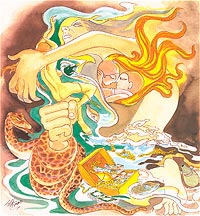
There is no fire like lust,
nought seizes like aversion,
unequalled is delusion’s net,
no river’s like to craving.
Explanation: There is no fire life passion. There is no grip
like hatred. There is no net like ignorance. There is no torrent like
craving.
Dhammapada Verse 251
Panca Upasaka VatthuNatthi ragasamo aggi
natthi dosasamo gaho
natthi mohasamam jalam
natthi tanhaisama nadi1.Verse 251: There is no fire like passion, there is no grip like ill will,
there is no net like ignorance, there is no river like craving.
1. natthi tanhasama nadi: There is no river like craving. This is because
although a river can be full at times, craving can never be full, ie., satiated.
The Story of Five Lay-disciples
While residing at the Jetavana monastery, the Buddha uttered Verse (251) of
this book, with reference to five lay disciples.On one occasion, five lay-disciples were present while the Buddha was
expounding the Dhamma at the Jetavana monastery. One of them was asleep while
sitting, the second one was drawing lines with his fingers on the ground, the
third was trying to shake a tree, the fourth was looking up at the sky. The
fifth was the only one who was respectfully and attentively listening to the
Buddha. Thera Ananda, who was near the Buddha fanning him saw the different
behaviour of the five disciples and said to the Buddha, “Venerable Sir!
While you were expounding the Dhamma like big drops of rain falling from the
sky, only one out of those five people were listening attentively.” Then
Thera Ananda described the different behaviour of the other four to the Buddha
and asked why they were behaving thus.The Buddha then explained to Thera Ananda, “Ananda, these people
could not get rid of their old habits. In their past existences, the first one
was a snake; as a snake usually coils itself up and goes to sleep, so also, this
man goes to sleep while listening to the Dhamma. The one who was scratching the
earth with his hand was an earthworm, the one who was shaking the tree was a
monkey, the one who was gazing up at the sky was an astronomer and the one who
was listening attentively to the Dhamma was a learned astrologer. In this
connection, Ananda, you must remember that one must be attentive to be able to
understand the Dhamma and that there are many people who cannot follow what was
being said.”Thera Ananda then asked the Buddha, “Venerable Sir! What are the things
that prevent people from being able to take in the Dhamma?” And the Buddha
replied, “Ananda, passion (raga), ill will (dosa) and ignorance (moha)
are the three things that prevent people from taking in the Dhamma. Passion
burns one; there is no fire like passion. The world may burn up when seven suns
rise in the sky, but that happens very rarely. Passion burns always and without
any break.”Then the Buddha spoke in verse as follows:
Verse 251: There is no fire like passion, there is no
grip like ill will, there is no net like ignorance, there is no river
like craving.
At the end of the discourse the one who was listening attentively attained
Sotapatti Fruition.
ALL ABOUT USA
Illinois
• Buddhist Temple of Chicago, independent, Chicago
• Chicago Zen Center, Sanbo Kyodan lineage, Evanston
• Daiyuzenji
• Dharma Drum Mountain Buddhist Association of Chicago, Mount Prospect
• Midwest Buddhist Temple, Jodo Shinshu lineage, Chicago
• Buddhist Temple of Chicago, independent, Chicago
• Chicago Zen Center, Sanbo Kyodan lineage, Evanston
• Daiyuzenji
• Dharma Drum Mountain Buddhist Association of Chicago, Mount Prospect
• Midwest Buddhist Temple, Jodo Shinshu lineage, Chicago

UPASAKA JAGATHEESAN CHANDRASEKHARAN
Dhammapada Verses 249 and 250-Tissadahara Vatthu-Verse 249. The Envious Are Not At Peace-Verse 250. The Unenvious Are At Peace
AWAKEN ONE WITH AWARENESS ONLINE GOOD NEWS LETTER
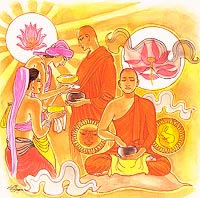
People give as they have faith,
as they are bright with joyfulness.
Who’s troubled over gifts received,
the food and drink that others get,
neither in daytime nor by night
will come to a collected mind.
Verse 250. The Unenvious Are At Peace
But who has severed envy’s mind,
uprooted it, destroyed entire,
indeed in daytime and by night
will come to a collected mind.
Explanation: If someone were to utterly uproot and totally
eradicate this jealousy, and if it is absolutely destroyed, he will,
without any doubt, attain tranquillity day and night.
Explanation: The people give in terms of the faith they have
in the recipient. They give in terms of their pleasure. If one were
to be jealous when they receive, food and drink, he will never attain
tranquillity of mind day or night.
Dhammapada Verses 249 and 250
Tissadahara Vatthu
Dadati ve yathasaddham
yathapasadanam jano
tattha yo ca manku bhavati
paresam panabhojane
na so diva va rattim va
samadhimadhigacchati.
Yassa cetam samucchinnam
mulaghaccam samuhatam
sa ve diva va rattim va
samadhimadhigacchati.
Verse 249: People give according to their faith and their devotion; one who
is displeased with others receiving food and drink cannot attain concentration
(samadhi) by day or by night.
Verse 250: He who has this feeling of displeasure cut off, uprooted and
removed, will surely attain concentration (samadhi) by day or by night.
The Story of Tissa
While residing at the Jetavana monastery, the Buddha uttered Verses (249) and
(250) of this book, with reference to Tissa, a young bhikkhu.
Tissa, a young bhikkhu, had a very bad habit of disparaging other people’s
charities and good deeds. He even criticized the charities given by such
renowned donors like Anathapindika and Visakha. Besides, he boasted that his
relatives were very rich and were like a well where anyone could come for water.
Hearing him boast thus, other bhikkhus were very sceptical; so they decided to
find out the truth.
Some young bhikkhus went to the village from where he came and made
enquiries. They found out that Tissa’s relatives were all poor and that all this
time Tissa had only been making a vain boast. When the Buddha was told about
this, he said, “Bhikkhus, a bhikkhu who is displeased with others
receiving gifts and offerings can never attain Magga and Phala.”
Then the Buddha spoke in verse as follows:
| Verse 249: People give according to their faith and their devotion; one who is displeased with others receiving food and drink cannot attain concentration (samadhi) by day or by night. |
| Verse 250: He who has this feeling of displeasure cut off, uprooted and removed, will surely attain concentration (samadhi) by day or by night. |
AWAKEN ONE WITH AWARENESS ONLINE GOOD NEWS LETTER
This sutta gathers various instructions the Buddha gave for the
sake of his followers after his passing away, which makes it be a very
important set of instructions for us nowadays.
Pāḷi |
English |
|
|
|
| (Dhammādāsa)
Dhammādāsaṃ nāma dhamma-pariyāyaṃ desessāmi, yena samannāgato ariyasāvako ākaṅkhamāno attanāva attānaṃ byā-kareyya: ‘khīṇa-nirayo-mhi khīṇa-tiracchāna-yoni khīṇa-pettivisayo khīṇ‘āpāya-duggati-vinipāto, sotāpanno-hamasmi avinipāta-dhammo niyato sambodhi-parāyaṇo‘ ti. |
(The Mirror of the Dhamma)
தமிழ் நான் Dhammādāsa (தம்மாவின் உருப்பளிங்கு) என கருதப்படும் தம்மாவை வியாக்கியானம் பண்ண பிரசங்கம் செய்ய விரும்புகிரேன், ariyasāvaka (புனிதமான சீடர்) ஆக ஆட்கொண்டு, ஒருவேளை அவர் தானே விரும்பி உறுதியாக்கிக் கொண்டால்: |
|
Katamo ca so, Ānanda, dhammādāso dhamma-pariyāyo, yena samannāgato ariyasāvako ākaṅkhamāno attanāva attānaṃ byā-kareyya: ‘khīṇa-nirayo-mhi khīṇa-tiracchāna-yoni khīṇa-pettivisayo khīṇ‘āpāya-duggati-vinipāto, sotāpanno-hamasmi avinipāta-dhammo niyato sambodhi-parāyaṇo‘ ti? |
மற்றும் என்ன,Ānanda (ஆனந்தா),தம்மா மீது ஆன அந்த பிரசங்கம் Dhammādāsa (தம்மாவின் உருப்பளிங்கு) என கருதப்படும் தம்மாவை வியாக்கியானம் பண்ண பிரசங்கம் செய்ய விரும்புகிரேன்,ariyasāvaka (புனிதமான சீடர்)ஆக ஆட்கொண்டு,ஒருவேளை அவர் தானே விரும்பி உறுதியாக்கிக் கொண்டால்: |
|
Idh‘ānanda, ariyasāvako Buddhe aveccappasāda samannāgato hoti: |
இங்கு,ஆனந்தா,புனிதமான சீடர் Buddhe aveccappasāda (புத்தர் இடத்தில் தன்னம்பிக்கை)உடைய வராக குணிக்கப் படுகிரார். |
Dhamme aveccappasāda:(தம்மா இடத்தில் தன்னம்பிக்கை)உடைய வராக குணிக்கப் படுகிரார்.
|
|
|
|
|
|
| Saṅghe aveccappasāda (சான்றோர் இடத்தில் தன்னம்பிக்கை)உடைய வராக குணிக்கப் படுகிரார்.
|
|
புனிதமானவர்கள் ஏற்றுக்கொள்ளத்தக்க சீலராக குணிக்கப் படுகிரார். |
|
|
Ayaṃ kho so, Ānanda, dhammādāso dhamma-pariyāyo, yena samannāgato ariyasāvako ākaṅkhamāno attanāva attānaṃ byā-kareyya: ‘khīṇa-nirayo-mhi khīṇa-tiracchāna-yoni khīṇa-pettivisayo khīṇ‘āpāya-duggati-vinipāto, sotāpanno-hamasmi avinipāta-dhammo niyato sambodhi-parāyaṇo‘ ti |
இது, Ānanda (ஆனந்தா),தம்மா மீது ஆன அந்த பிரசங்கம் Dhammādāsa (தம்மாவின் |
|
|
|
|
Sato, bhikkhave, bhikkhu vihareyya sampajāno. Ayaṃ vo amhākaṃ anusāsanī. |
Sato should you remain, bhikkhus, and sampajānos. This is our intruction to you. Sato(கவனமான) நீர் இருக்க வேண்டும்,bhikkhus (பிக்குக்கள்),மேலும் sampajānos(மாறா இயல்பு அநித்தியத்தை பகுத்தறிதல்).இது தான் உமக்கு |
|
Katha‘ñca, bhikkhave, bhikkhu sato hoti? Idha, bhikkhave, bhikkhu |
மற்றும் எப்படி,பிக்குக்கள், பிக்கு sato (கவனமான) இருக்கிரார்? இங்கு,பிக்குக்கள், ஒரு பிக்கு |
|
Evaṃ kho, bhikkhave, bhikkhu sato hoti. Katha‘ñca, bhikkhave, bhikkhu sampajāno hoti? Idha, bhikkhave, |
இப்படி,பிக்குக்கள்,பிக்கு sato (கவனமான) இருக்கிரார்.மற்றும் எப்படி,பிக்குக்கள், பிக்கு sampajānos(மாறா இயல்பு அநித்தியத்தை பகுத்தறிதல்)ஆகிரார்? இங்கு,பிக்குக்கள், |
| |
|
Evaṃ kho, bhikkhave, bhikkhu sampajāno hoti. Sato, bhikkhave, bhikkhu vihareyya sampajāno. Ayaṃ vo amhākaṃ anusāsanī ti. |
இப்படி,பிக்குக்கள்,பிக்கு sampajānos(மாறா இயல்பு அநித்தியத்தை பகுத்தறிதல்)ஆகிரார்,Sato(கவனமான) நீர் இருக்க வேண்டும்,பிக்குக்கள்,மற்றும்sampajānos(மாறா இயல்பு அநித்தியத்தை பகுத்தறிதல்),இது தான் உமக்கு |
|
|
|
|
|
-ஆனந்தா,பூவா பருவகாலமாக இருந்த போதிலும், இரட்டை sala (சாலா) மரங்கள் முழு மலர்ச்சி அடைந்து இருக்கிறது. மற்றும் Tathagata (குறைபாடற்றவரை) வழிபாடு செய்தல் போல் Tathagata(குறைபாடற்றவர்) உடல் மேலே பூமழை பொழிந்து, துளி சிதற, இரத்தினப்பிரபையாகியது. மற்றும் தேவலோக பவழமலர்கள் மற்றும் சுவர்க்கத்தைச் சேர்ந்த சந்தன மரத் தூள் வானத்தில் இருந்து மழை கீழ் நோக்கி Tathagata (குறைபாடற்றவர்) உடல் மேலே பொழிந்து, மற்றும் Tathagata (குறைபாடற்றவரை) வழிபாடு செய்தல் போல் Tathagata(குறைபாடற்றவர்) உடல் மேலே பூமழை பொழிந்தது. மற்றும் Tathagata(குறைபாடற்றவர்) போற்றுதலைக் காட்டுஞ் சமிக்கையால் சுவர்க்கத்தைச் சேர்ந்த குரல் ஒலி மற்றும் இசைகருவிகள் காற்றுவெளியில் வெளிப்படுத்தியது. |
|
Na kho, Ānanda, ettāvatā Tathāgato sakkato vā hoti garukato vā mānito vā pūjito vā apacito vā. Yo kho, Ānanda, bhikkhu vā bhikkhunī vā upāsako vā upāsikā vā dhammānudhammappaṭipanno viharati sāmīcippaṭipanno anudhammacārī, so Tathāgataṃ sakkaroti garuṃ karoti māneti pūjeti apaciyati, paramāya pūjāya. Tasmātih‘ānanda, dhammānudhammappaṭipannā viharissāma sāmīcippaṭipannā anudhammacārin‘oti. Evañ‘hi vo, Ānanda, sikkhitabba nti. |
இதனால் மட்டும் அல்ல, ஆனந்தா,Tathagata (குறைபாடற்றவரை) உபசரித்தது, மரியாதை செலுத்தியது, நன்குமதிக்கப் பட்டது, மனந்திறந்த புகழுரைத்தது, கெளரவம் செலுத்தியது. ஆனால், ஆனந்த, எந்த ஒரு பிக்குவோ அல்லது பிக்குனியோ, உபாசகன் அல்லது உபாசகி, dhamm’ānudhamma’p'paṭipanna, sāmīci’p'paṭipanna, தம்மாவிற்கு பொருந்துமாறு பயிற்சிக்கிராரோ அவர் Tathagata (குறைபாடற்றவரை) உபசரித்தது, மரியாதை செலுத்தி, நன்குமதித்து, மனந்திறந்த புகழுரைத்தது, கெளரவம் செலுத்தி. மிக உயர்ந்த அளவு நேர்த்திவாய்ந்த மனந்திறந்த புகழுரையாற்றுவர். இதுக்காக, ஆனந்தா, நீங்கள், நீங்களாகவே பயிற்சித்தல் இதுதான்: நாங்கள் dhamm’ānudhamma’p'paṭipanna, sāmīci’p'paṭipanna, தம்மாவிற்கு பொருந்துமாறு வாழ்க்கை முறையில் தொடர்ந்திருப்போம். |
|
|
|
|
|
உங்கள் சிலர்ருக்கு, ஆனந்தா,இவ்வாறு நேரிடக் கூடும்: |
|
|
|
———oOo———
Published as a gift of Dhamma, to be distributed free of charge.
Any copies or derivatives of this work must cite their original source.
 |
Verse 246. Wrong Deeds To Avoid
Explanation: One day a group of lay disciples who only kept |
 |
Verse 247. Precepts The Lay Person Should Follow
Explanation: A man who is given to taking intoxicating drinks, |
 |
Verse 248. These Precepts Prevent Suffering
Explanation: Evil actions do not have restraint or discipline. |
Dhammapada Verses 246, 247 and 248
Panca Upasaka VatthuYo panamatipateti
musavadanca bhasati
loke adinnamadiyati
paradaranca gacchati.Suramerayapananca
yo naro anuyunjati
idheva meso lokasmim
mulam khanati attano.Evam bho purisa janahi
papadhamma asannata
ma tam lobho adhammo ca
ciram dukkhaya randhayum.Verses 246 & 247: He who destroys life, tells lies, takes what is not
given him, commits adultery and takes intoxicating drinks, digs up his own roots
even in this very life.Verse 248: Know this, O man! Not restraining oneself is evil; do not let
greed and ill will subject you to prolonged misery.
The Story of Five Lay-Disciples
While residing at the Jetavana monastery, the Buddha uttered Verses (246),
(247) and (248) of this book, with reference to five lay-disciples.On one occasion five lay-disciples were keeping sabbath at the Jetavana
monastery. Most of them were observing only one or two of the five moral
precepts (sila). Each one of them observing a particular precept claimed that
the precept observed by him was the most difficult and there were a lot of
arguments. In the end, they came to the Buddha with this problem. To them the
Buddha said, “You should not consider any individual precept as being
easy or unimportant. Each and every one of the precepts must be strictly
observed. Do not think lightly of any of the precepts; none of them is easy to
observe.”Then the Buddha spoke in verse as follows:
Verses 246 & 247: He who destroys life, tells
lies, takes what is not given him, commits adultery and takes
intoxicating drinks, digs up his own roots even in this very life.Verse 248: Know this, O man! Not restraining
oneself is evil; do not let greed and ill will subject you to
prolonged misery.
At the end of the discourse the five lay-disciples attained Sotapatti
Fruition.
AWAKEN ONE WITH AWARENESS ONLINE GOOD NEWS LETTER
Hawaii
• Byodo-In Temple
|
|
| Byodo-In Temple | |
|---|---|
 |
|
| Byodo-In Temple in Hawai’i is a replica of the historic Byodoin Temple of Uji in Kyoto prefecture of Japan, established in 1052. | |
| Information | |
| Denomination | non-denominational |
| Founded | 1968 |
| Address | 47-200 Kahekili Hwy
Kaneohe, HI 96744 |
| Country | United States |
The Byodo-In (平等院) Temple is a non-denominational Buddhist temple located on the island of O’ahu in Hawai’i at the Valley of the Temples. At 47-200 Kahekili Highway, the Byodo-In Temple is a replica of a 900-year-old Buddhist place of worship at Uji in Kyoto prefecture of Japan. Inside the Byodo-In Temple is a nine-foot (3 m) Lotus Buddha, a wooden Buddha. It is covered in gold and lacquer. Outside is a three-ton, brass peace bell. Surrounding the temple are large koi
ponds that cover a total of two acres (8,000 m²). Around those ponds
are lush Japanese gardens set against a backdrop of towering cliffs of
the Ko’olau mountains. Sparrows are often seen fluttering about and playing in the garden trees while peacocks strut about displaying their beautiful feathers.
The Byodo-In Temple is visited and used by thousands of worshippers
from around the world. It welcomes people of all faiths to participate
in its traditions. Apart from worship, the temple grounds are also used
for weddings and office meetings.
| Broken Ridge Buddhist Temple | |
|---|---|
| Information | |
| Denomination | Chogye |
| Founded | 1975 |
| Abbot(s) | Dohyun Gwon |
| Address | 2420 Halelaau Place, Honolulu, HI 96816 |
| Country | United States |
| Website | hawaiimuryangsa.com |
Broken Ridge Buddhist Temple (Hangul: 무량사 “Mu Ryang Sa”) is a Korean Buddhist temple on the island of Oahu in the U.S. state of Hawaii. Originally known as the “Dae Won Sa Temple,” it was constructed on King St in Honolulu in 1975. After being destroyed by fire, construction of the new temple located in the Palolo Valley began in 1986. Due to legal disputes construction was not completed until 2005.
• Hawaii Shingon Mission
http://en.wikipedia.org/wiki/Hawaii_Shingon_Mission
|
Shingon Shu Hawaii
|
|
 |
|
|
|
|
| Nearest city: | Honolulu, Hawaii |
|---|---|
| Coordinates: | 21°17′5″N 157°50′57″WCoordinates: 21°17′5″N 157°50′57″W |
| Area: | less than one acre |
| Built: | 1918, 1929 |
| Architect: | Hego Fuchino |
| Architectural style: | Japanese |
| Governing body: | Private |
| NRHP Reference#: | 02000386[1] |
| Added to NRHP: | April 26, 2002 |
Hawaii Shingon Mission or Shingon Shu Hawaii located at 915 Sheridan Street in Honolulu, Hawaii, is one of the most elaborate displays of Japanese Buddhist temple architecture in Hawaiʻi. It was first built in 1917-1918 by Nakagawa Katsutaro, a master builder of Japanese-style temples, then renovated in 1929 by Hego Fuchino, a self-taught man who was the first person of Japanese ancestry to become a licensed architect
in the Islands. The building underwent further changes in 1978, and was
considerably augmented in 1992. However, its most distinctive features
remain: the steep, hipped-gable roof (irimoya)
with rounded-gable projection, both with elaborate carvings on the
ends, and the glittering altar and interior furnishings from Japan that
signify its ties to esoteric Shingon Buddhism.
http://www.atlantisadventures.com/waikiki
Welcome to Atlantis Adventures Waikiki
Atlantis Adventures is proud to be recognized as the largest provider
of tourist attractions on the Hawaiian Islands. Our spectacular island
setting is home to two of Hawaii’s most celebrated water adventures
including the fascinating Atlantis Submarines and the Atlantis Navatek
Cruises.
Atlantis Submarines Waikiki – Add deeper meaning to your island visit
by diving to depths well over 100 feet in the safety and comfort of an
air-conditioned, Coast Guard approved, real submarine. Located within
view of famous Diamond Head, the Atlantis dive site is frequented by
green turtles, sharks, stingrays, yellow tangs, eels, and many other
species of underwater marine life.
Atlantis Navatek Cruises – Enjoy an evening of tasty food,
entertainment, and unforgettable views aboard the sleek and
state-of-the-art vessel, the Navatek I. Royal Sunset Dinner and Sunset
Buffet Dinner guests are treated to live entertainment by some of
Hawaii’s finest vocalists, musicians, and beautiful dancers. Enjoy
music of the Pacific and beyond while gently cruising toward the sunset.
Navatek’s singers and dancers love to interact with guests, and there
are opportunities for couples to dance if they wish.
Experience the magic of our Atlantis Adventure tours and create a
lifetime of memories as you explore our majestic coastal waters
surrounding the cities of Waikiki and Honolulu. This will be an
experience to remember!
Come and explore everything that Atlantis Adventures Waikiki has to offer!